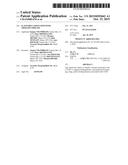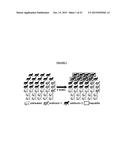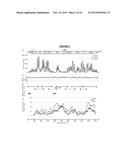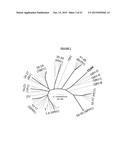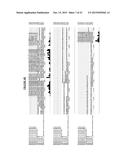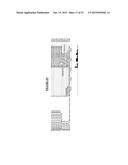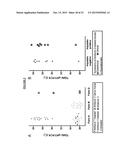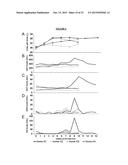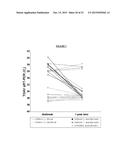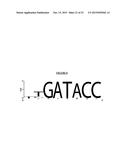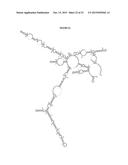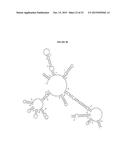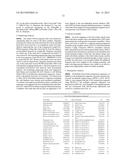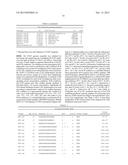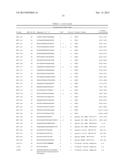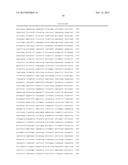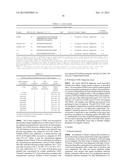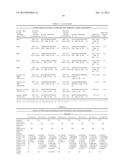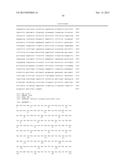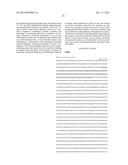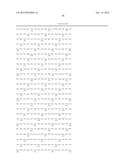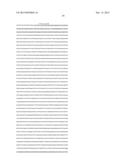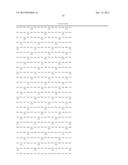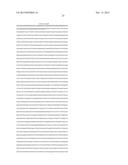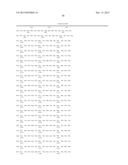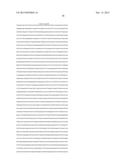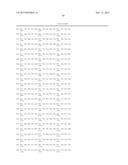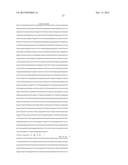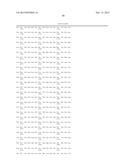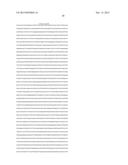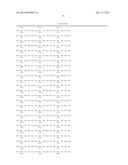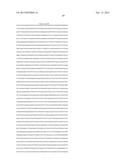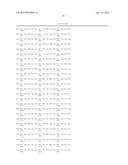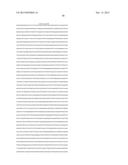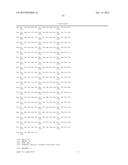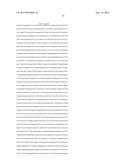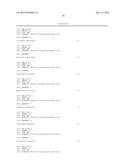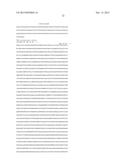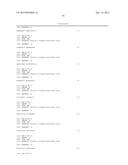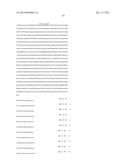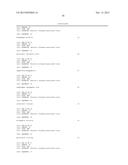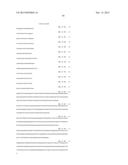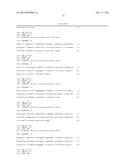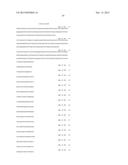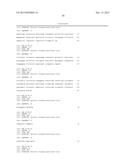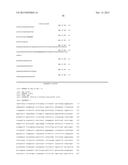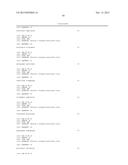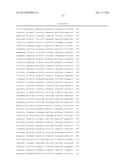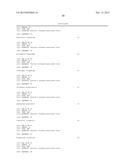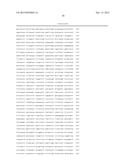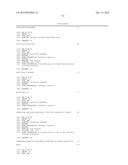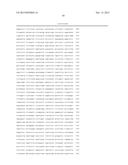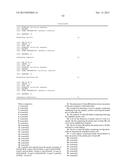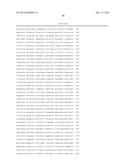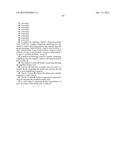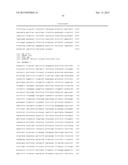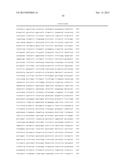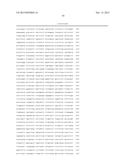Patent application title: FLAVIVIRUS ASSOCIATED WITH THEILER'S DISEASE
Inventors:
Sanjay Chandriani (Emeryville, CA, US)
Peter Skewes-Cox (Emeryville, CA, US)
Thomas Divers (Ithaca, NY, US)
Bud Tennant (Ithaca, NY, US)
Amy Kistler (Emeryville, CA, US)
Assignees:
NOVARTIS TIERGESUNDHEIT AG
IPC8 Class: AC12Q170FI
USPC Class:
506 2
Class name: Combinatorial chemistry technology: method, library, apparatus method specially adapted for identifying a library member
Publication date: 2015-10-15
Patent application number: 20150292042
Abstract:
This disclosure relates to Theiler's disease-associated virus ("TDAV"),
reagents relating thereto, and methods for detecting, using, and/or
treating diseases associated with TDAV.Claims:
1. (canceled)
2. (canceled)
3. (canceled)
4. (canceled)
5. (canceled)
6. (canceled)
7. (canceled)
8. (canceled)
9. (canceled)
10. (canceled)
11. (canceled)
12. (canceled)
13. (canceled)
14. (canceled)
15. (canceled)
16. (canceled)
17. (canceled)
18. (canceled)
19. (canceled)
20. A primer pair selected from the group consisting of SEQ ID NOS.: 4 and 5; SEQ ID NOS.: 6 and 7; SEQ ID NOS.: 8 and 9; SEQ ID NOS.: 10 and 11; SEQ ID NOS.: 12 and 13; SEQ ID NOS.: 14 and 15; SEQ ID NOS.: 16 and 17; and SEQ ID NOS.: 18 and 19.
21. The primer pair of claim 20 wherein at least one primer of the pair comprises a detectable label.
22. A method for detecting a virus in a sample, comprising amplifying from the sample a nucleic acid using the primer pair of claim 20 or 21.
23. The method of claim 22 further comprising detecting the amplified nucleic acid.
24. A kit for the detection of nucleic acid of a virus in a sample, the kit comprising the primer pair of claim 20; and one or more amplification reagents.
25. The kit of claim 24 wherein the primer pair is fixably attached to a solid support.
26. The kit of claim 24 further comprising an oligonucleotide for detecting the amplified nucleic acid.
27. A solid support comprising fixably bound thereto at least one primer of the primer pair of claim 20.
28. (canceled)
29. (canceled)
30. (canceled)
31. (canceled)
32. (canceled)
33. (canceled)
34. (canceled)
35. (canceled)
36. (canceled)
37. (canceled)
38. (canceled)
39. (canceled)
40. (canceled)
41. (canceled)
42. (canceled)
43. (canceled)
44. (canceled)
45. (canceled)
46. A method for detecting Theiler's disease-associated virus (TDAV) in a sample, comprising amplifying from the sample a nucleic acid using a primer pair selected from the group consisting of SEQ ID NOS.: 4 and 5; SEQ ID NOS.: 6 and 7; SEQ ID NOS.: 8 and 9; SEQ ID NOS.: 10 and 11; SEQ ID NOS.: 12 and 13; SEQ ID NOS.: 14 and 15; SEQ ID NOS.: 16 and 17; and SEQ ID NOS.: 18 and 19.
47. A method for detecting a virus in a sample, comprising amplifying from the sample a nucleic acid using the primer pair of claim 21.
48. The method of claim 47 further comprising detecting the amplified nucleic acid.
49. A kit for the detection of nucleic acid of a virus in a sample, the kit comprising the primer pair of claim 21; and one or more amplification reagents.
50. The kit of claim 49 wherein the primer pair is fixably attached to a solid support.
51. The kit of claim 49 further comprising an oligonucleotide for detecting the amplified nucleic acid.
52. A solid support comprising fixably bound thereto at least one primer of the primer pair of claim 21.
Description:
FIELD OF THE DISCLOSURE
[0001] This disclosure relates to Theiler's disease-associated virus ("TDAV"), reagents relating thereto, and methods for detecting, using, and/or treating diseases associated with TDAV.
BACKGROUND OF THE DISCLOSURE
[0002] Theiler's disease is a fulminant hepatic disease affecting horses. The cause of Theiler's disease has not yet been elucidated and represents a significant problem related to the diagnosis and treatment of the disease. The disease has been associated with the antecedent administration of biologics of equine origin (e.g., botulinal antitoxin, tetanus antitoxin). A significant delay between exposure to biologics and the onset of acute hepatitis has been observed and the associated histopathologic lesions in the liver determined to be remarkably similar to those associated with acute human hepatitis A virus or hepatitis B virus infection.
SUMMARY OF THE DISCLOSURE
[0003] This disclosure describes a new virus that has now been linked to Theiler's disease (Theiler's disease-associated Virus ("TDAV")). TDAV was determined to be a member of the Flaviviridae family that includes hepatitis C virus (HCV), GB virus B, canine hepacvirus (CHV), and equine Non-Primate Hepacivirus (NPHV). This new virus, the genomic nucleotide sequence, amino acid sequence, as well as compositions and methods for preparing, using, and/or detecting the same are described herein. Also provided are reagents and methods for detecting TDAV within biological samples. Thus, this disclosure provides a solution to the problems relating to the detection, diagnosis, treatment and prevention of Theiler's disease.
[0004] TDAV is disclosed herein to comprise the nucleic acid and amino acid sequences of SEQ ID NOS.: 1, 2 and/or 3. Nucleic acid molecules comprising such nucleic acid sequences and/or encoding such amino acid sequences are described. Methods and reagents for detecting TDAV (which may also include TDAV-like viruses), in a sample (e.g., a biological sample such as whole blood (e.g., undiluted or processed), cord blood, plasma, serum, cord serum, saliva, lymphatic fluid, cerebrospinal fluid, urine, semen, pleural fluid, breast milk, sweat, ascites, a tissue sample e.g. liver, a food (e.g., meat) or beverage (e.g., milk) product, etc.) are also provided herein. Compositions comprising TDAV, nucleic acids, peptides, and/or polypeptides corresponding to TDAV are also disclosed. Other embodiments are also provided, as described herein.
BRIEF DESCRIPTION OF THE DRAWINGS
[0005] FIG. 1. Overview of a Theiler's disease outbreak. Twenty-two horses on Farm A suspected of exposure to botulinum toxin were therapeutically and prophylactically treated with intravenous equine anti-botulinum toxin hyperimmune plasma. Five horses received antitoxin from one source (grey horses, `antitoxin 1`), while 17 horses received an independently sourced batch (black horses, `antitoxin 2`). Fifteen horses followed in this study went untreated (white horses, `untreated`). Within 8 weeks of antitoxin administration, 8 horses treated with Antitoxin 2 showed signs of acute hepatitis (boxes). All other horses were clinically asymptomatic (no boxes).
[0006] FIG. 2. Genome of Theiler's disease-associated virus (TDAV). (A) Schematic of the TDAV genome. Protein cleavage sites are putative and were annotated based on homologous inference from HCV (FIG. 4). (*) gene corresponding to HCV p7, GBV-B p13, GBV-D X, and GBV-A 21 kDa protein. (B) Coverage map of sequencing reads from Horse A1, Horse A2, and Antitoxin 2. (C) Median calculated amplicon size based on the distance between the 5' ends of paired end sequencing reads mapping to each nucleotide. (D) Overlapping clones recovered and sequenced to confirm the genome assembly (above) and the location of amplicons used in TDAV diagnosis and quantification (below). (E) Pairwise amino acid percent identity plot (100 aa windows) of TDAV compared to HCV-gt1, NPHV, and GBV-D. Genome position scale (bottom) refers to panels A-E.
[0007] FIG. 3. Phylogenetic analysis of Flaviviridae based on polyprotein sequences. Multiple sequence alignments were generated using MUSCLE and a Neighbor-Joining phylogenetic tree with 100 bootstrap replicates was generated in MEGA5. TDAV in bold for emphasis. All branches are numbered starting at `*` and incremented clockwise (see Table S3 for key). Closer branch groups are labeled with range of sequence numbers; representative member of group listed in parenthesis with a thicker line illustrating branch for representative member. WNV=West Nile virus, DENV=Dengue virus 1, DV=Donggang virus, YFV=Yellow fever virus, MV=Modoc virus, TBEV=Tick-borne encephalitis virus, BVDV=Bovine viral diarrhea virus 1, TDAV=Theiler's disease-associated virus, GBV-(A-D)=GB virus (A-D), HCV=Hepatitis C virus genotype 1, NPHV=NPHV #1 (AFJ20709.1). `†` indicates nearly identical branches 8 and 9, corresponding to Tembusu virus and Duck flavivirus TA respectively.
[0008] FIG. 4A-N. Multiple sequence alignment of polyprotein sequences from Hepatitis C virus, GB viruses, Canine hepacivirus, and TDAV. All six HCV genotypes, all four GB viruses, Canine hepacivirus, and TDAV were aligned using MUSCLE and viewed in ClustalX v2.0. `*` above column indicates perfect conservation, `.` indicates high degree of conservation, and `:` indicates amino acid similarity across entire column. Bar graph below alignment shows fraction of column members matching consensus.
[0009] FIG. 5. A quantitative PCR-based diagnostic assay to detect TDAV in different cohorts. Cycles to threshold (Ct) from the qRT-PCR TDAV diagnostic assay (primers EVT-146/147) are plotted on an inverted y-axis; a lower Ct value represents a greater viral load. (A) Serum/plasma from horses on Farms A, B and D with antitoxin treatment status indicated. (B) Results from Farm A, Antitoxin 2 treated animals only are segregated by whether the horse displayed signs of hepatitis. The severity of symptoms (clinical and subclinical) is indicated.
[0010] FIG. 6A-E. TDAV viral load and liver enzyme function in animals experimentally inoculated with Antitoxin 2. (A) qRT-PCR quantification of TDAV RNA. (B-E) Biochemical tests for aspartate amino transferase (AST), gamma gluatamyl transferase (GGT), sorbitol dehydrogenase (SDH), and glutamate dehydrogenase (GLDH or GD). Samples were taken at time 0 and 10-14 weeks after inoculation with 500 mL of the same lot of Antitoxin 2 linked to the serum hepatitis outbreak. One horse became mildly symptomatic at week 9 post inoculation (Horse C1, black), while the other three did not (Horse C2, light gray; Horse C3, gray; and Horse C4, dark gray).
[0011] FIG. 7. TDAV can cause chronic infection. TDAV was monitored in paired samples harvested during the outbreak and approximately one year later. Cycles to threshold (Ct) from the qRT-PCR TDAV diagnostic assay (primers EVT-146/147) are plotted on an inverted y-axis; a lower Ct value represents a greater viral load. The diagnostic assays were performed in parallel on paired samples, permitting direct comparison of Ct values.
[0012] FIG. 8. Thirty-five high quality sequences from the RACE clones were analyzed to determine the true 5' end of the TDAV genome. Polyguanine (or polycytosine for clones in the reverse orientation) stretches generated during the 5' RACE procedure were identified preceding the putative 5' end of the genome and were removed. Positions 1-7 (labeled) were included in the assembly as the consensus sequence, TGATACC, while the position labeled `?` represents a potential polymorphic `T` seen in five clones. Sequence logo was generated using WebLogo (http://weblogo.berkeley.edu).
[0013] FIG. 9. Predicted structures for 5' UTR and 3' UTR. RNA secondary structure for (A) 5' UTR and (B) 3' UTR sequences was predicted using CONTRAfold and viewed using PseudoViewer3. Approximately 30 nucleotides downstream of the translation initiation codon (`AUG`, bold in (A)) and 30 nucleotides upstream of translation stop codon (`UGA`, bold in (B)) were folded in addition to the UTRs. Coordinates in (B) are relative and offset by 10,154 nt (position 1=nt 10155 in TDAV; position 325=nt 10479 in TDAV).
DETAILED DESCRIPTION
[0014] This disclosure relates to solutions to the current and unmet need for the identification and detection of the causitive agent(s) of diseases such as Theiler's Disease. As described herein, a possible causitive agent has been identified as Theiler's disease-associated virus (TDAV, which may include, for instance, "TDAV-like" viruses) as well as isolates and compositions thereof. Further provided are nucleic acid sequences and amino acid sequences representing the same (e.g., SEQ ID NOS.: 1-3). Nucleic acid molecules comprising such nucleic acid sequences and/or encoding such amino acid sequences are also provided. Methods and reagents for detecting TDAV (which may also include TDAV-like viruses), in a sample (e.g., a biological sample such as whole blood (e.g., undiluted or processed), cord blood, plasma, serum, cord serum, saliva, lymphatic fluid, cerebrospinal fluid, urine, semen, pleural fluid, breast milk, sweat, ascites, a tissue sample, a food (e.g., meat), beverage (e.g., milk) product, etc.), and/or organism (e.g., insect) are also provided herein. For instance, TDAV virus may be present in a biological sample of an animal (e.g., mammal) such as a horse. Such a horse (e.g., one having Theiler's disease) may have TDAV circulating in a bodily fluid such as, for instance, blood. In some embodiments, TDAV (e.g., a virus sharing at least some identity with that described herein) may be identified and/or detected by detecting and/or isolating the virus or a portion thereof from a biological sample. In some embodiments, TDAV may be detected by detecting a nucleic acid sequence and/or amino acid sequence of the virus, and/or the virus per se (e.g., as an intact virus or viral particle) in the biological sample. Other embodiments are also contemplated as will be clear to one of ordinary skill in the art from this disclosure.
[0015] TDAV typically comprises any one or more nucleic acid and/or amino acid sequences that correspond to, may be used to identify, and/or distinguish TDAV from another virus, and/or may be used to detect TDAV in a sample (e.g., a biological sample), and/or used to generate an antibody reactive with TDAV, such as, for example: SEQ ID NO.: 1 or 2 or a portion thereof; a nucleic acid sequence having at least about 50-99%, identity to SEQ ID NO.: 1 or 2 or a portion thereof; a nucleic acid sequence comprising at least any of five, six, seven, eight, nine, 10, 11, 12, 13, 14, 15, 16, 17, 18, 19, 20 or more consecutive nucleotides of SEQ ID NO.: 1 or 2 or a portion thereof; a nucleic acid sequence encoding SEQ ID NO.: 3 or a portion thereof; a nucleic acid sequence encoding a polypeptide or peptide having at least about 50-99% identity to SEQ ID NO.: 3 or a portion thereof; a nucleic acid sequence encoding at least three, four, five, six, seven, eight, nine, 10, 11, 12, 13, 14, 15, 16, 17, 18, 19, 20 or more consecutive amino acid residues of SEQ ID NO.: 3 or a portion thereof; a polypeptide comprising SEQ ID NO.: 3 or a portion thereof; a polypeptide having at least about 50-99% identity or similarity to SEQ ID NO.: 3 or a portion thereof; a peptide or polypeptide comprising at least three contiguous amino acids of SEQ ID NO.: 3 or a portion thereof, and the like. A suitable "portion of" SEQ ID NO.: 1, 2 or 3 may be, for example, any nucleotide sequence (e.g., an oligonucleotide) and/or amino acid sequence (e.g., a peptide or any amino acid sequence to which a binding agent (e.g., antibody) binds) of any number of nucleotides and/or amino acid residues that is specific to TDAV, may be used to identify TDAV, and/or may be used to differentiate TDAV from, for example, another virus in, for example, a biological sample (e.g., using an assay). The sequence of these nucleic acid sequences may be determined by any method available to those of ordinary skill in the art. Any of such nucleotide and/or amino acid sequences may be "unique to Theiler's disease-associated virus (TDAV)". "Used to identify" may include the use of a binding of a binding agent having specificity for a nucleotide and/or amino acid sequence of TDAV described herein. A virus comprising any such nucleotide (e.g., within the viral genome) and/or amino acid sequence (e.g., expressed by the virus) described herein and/or binding to a binding agent having specificity therefor may be referred to herein as a "TDAV-like" virus. In some instances herein, "TDAV" and "TDAV-like" may be used interchangeably. Assays for identifying TDAV (e.g., within a product) may be conducted in any manner set forth herein or otherwise available to one of ordinary skill in the art. For instance, the assay may include the use of one or more oligonucleotides, primer pair(s), method(s), kit(s), solid support(s), and/or antibodies described herein. Other embodiments of such products are also contemplated as will be clear to one of ordinary skill in the art from this disclosure.
[0016] As described herein, Theiler's disease has been associated with the antecedent administration of biologics of equine origin (e.g., botulinal antitoxin, tetanus antitoxin, snake antitoxins, anti-thymocyte preparations, general colostral products and the like). It is therefore important to produce products that are known not to contain an infectious agent that may cause Theiler's disease. The reagents and methods described herein provide one of ordinary skill in the art to make such determinations. Accordingly, using the reagents and methods described herein (e.g., assays for detecting TDAV), one may provide a product (e.g., a biologic of equine origin such as botulinal antitoxin or tetanus antitoxin) that has been screened and/or assayed for the presence of a Theiler's disease-associated virus therein. In certain embodiments, the product may be derived from serum or plasma (e.g., horse serum or plasma). The product, for example, may be one screened and/or assayed to detect the presence of TDAV. A preferred "assayed product", for instance, may be one determined not to contain TDAV and/or to contain less TDAV than the original product.
[0017] TDAV may be detected as a viral particle per se or a portion thereof (e.g., nucleic acid sequence and/or antigen) may be detected using any of several well-known techniques. A viral particle may be detected by, for example, observing the virus directly (e.g., by electron microscopy), detecting cells expressing an antigen of the virus (e.g., by staining and/or flow cytometry), and/or detecting a nucleic acid molecule (e.g., a target nucleic acid sequence) corresponding to the virus. Other techniques for detecting TDAV in a sample are also available to those of ordinary skill in the art and are contemplated herein.
[0018] TDAV nucleic acid sequences (and/or oligonucleotides used to identify and/or detect such nucleic acid sequences) may include those that hybridize (e.g., under highly stringent and/or moderately stringent conditions) to all or any portion of a hybridization probe having a nucleotide sequence encoding a polypeptide of SEQ ID NO.: 3 or a portion thereof, such as SEQ ID NOS.: 1 or 2 (or a complement thereof). The hybridizing portion of the hybridizing nucleic acid is typically at least about five, six, seven, eight, nine, 10, 11, 12, 13, 14, 15, 16, 17, 18, 19, 20 nucleotides in length. The hybridizing portion is typically at least about 50%, 55%, 60%, 50-60%, 65%, 70%, 60-70%, 75% 80%, 70-80%, 85%, 90%, 80-90%, 95%, 95-99%, 97.5%, 99% or 100% identical to the nucleotide sequence to which it hybridizes. Hybridizing nucleic acids are useful, for example, as cloning probes, primers (e.g., PCR primer), and/or diagnostic probes. Nucleic acid duplex or hybrid stability is expressed as the melting temperature or Tm, which is the temperature at which a probe dissociates from a target DNA. This melting temperature is typically used to define the required stringency conditions. If sequences are identified that are related and substantially identical to the probe, rather than identical, then it is useful to first establish the lowest temperature at which only homologous hybridization occurs with a particular concentration of salt (e.g., SSC or SSPE). Assuming that a 1% mismatching results in a 1° C. decrease in Tm, the temperature of the final wash in the hybridization reaction is reduced accordingly (for example, if sequences having more than 95% identity are sought, the final wash temperature is decreased by 5° C.). In practice, the change in Tm can be between 0.5 and 1.5° C. per 1% mismatch. Highly stringent conditions may involve hybridizing at 68° C. in 5×SSC/5×Denhardt's solution/1.0% SDS, and washing in 0.2×SSC/0.1% SDS at room temperature. Moderately stringent conditions may include washing in 3×SSC at 42° C. Salt concentrations and temperatures can be varied to achieve the optimal level of identity between the probe and the target nucleic acid. Additional guidance regarding such conditions is readily available in the art, for example, in Molecular Cloning: A Laboratory Manual, Third Edition by Sambrook et al., Cold Spring Harbor Press, 2001.
[0019] A nucleic acid sequence corresponding to (e.g., sharing at least some identity with) TDAV may also be a "target nucleic acid" and/or "target nucleic acid sequence" (which terms may be used interchangeably). A target nucleic acid sequence may be detected and/or identified and/or quantified by any of several techniques widely available in the art. The target nucleic acid sequence may, for example, correspond to SEQ ID NO.: 1 and/or encode any number of contiguous amino acid residues (e.g., at least any of 5, 6, 7, 8, 9, 10, 11, 12, 13, 14, 15, 16, 17, 18, 19, 20 or more consecutive amino acid residues) encoded thereby (e.g., the amino acid sequence encoded by nucleotides 618-10,479 of SEQ ID NO.: 1 (including stop codon GTG) and/or as in SEQ ID NO.: 2)) and/or a derivative thereof. In some embodiments, the target nucleic acid sequence may be at least about 50%, 55%, 60%, 50-60%, 65%, 70%, 60-70%, 75% 80%, 70-80%, 85%, 90%, 80-90%, 95%, 95-99%, 97.5%, 99% or 100% complementary (e.g., identical to or capable of binding to under, for instance, stringent nucleic acid hybridization conditions) to a portion of or over the entirely of nucleic acid sequence of TDAV (e.g., SEQ ID NO.: 1). The target nucleic acid sequence may comprise a region (e.g., a "target-specific region") that is, for instance, about 4-30, about 5-25, about 6-20, about 7-15, about 8-10, about 10-15, about 15-20, about 20-25, about 25-30, about 30-35, about 35-40, about 40-45, about 45-50 or more nucleotides in length.
[0020] The target nucleic acid sequence may be of any kind such as, for example, single- or double-stranded RNA, DNA, or a RNA/DNA hybrid, for example. In some embodiments, the target nucleic acid may be contained on a RNA (e.g., as in the case of simultaneous analysis of gene expression by RT-PCR) or DNA molecule (e.g., cDNA). Target nucleic acid preparation may be carried out in a manner appropriate for the particular detection process to be implemented, as would be known by those of ordinary skill in the art. For example, DNA or RNA nucleic acid molecules may be extracted from any type of sample (e.g., blood) and processed according to standard procedures. Typically, detection involves the use of a nucleic acid (e.g., an oligonucleotide (e.g., probe)) that hybridizes to and/or may be used to amplify (e.g., is specific for) a target nucleic acid sequence. In some embodiments, 1-1000 different oligonucleotides (e.g., any of 1, 2, 3, 4, 5, 6, 7, 8, 9, 10, 11-50, 51-100, 101-150, 151-200, 201-250, 251-300, 301-350, 351-400, 401-450, 451-500, 501-550, 551-600, 601-650, 651-700, 701-750, 751-800, 801-850, 851-900, 901-950, or 951-1000 oligonucleotides) may be used separately or together in a single or multiple reactions to detect and/or identify and/or detect one or more target nucleic acid sequences in a sample. Suitable, exemplary detection techniques may include northern blot and/or polymerase chain reaction and/or variations thereof. Other techniques may also be utilized as may be described herein or elsewhere.
[0021] A commonly used technique for detecting nucleic acids involves amplification of one or more target nucleic acids (which may or may not also include one or more non-target nucleic acids) prior to detection and/or identification. Any amplification and/or detection method may be used. The method used to amplify the target nucleic acid(s) may be chosen from any one or more methods available to one of skill in the art including but not limited to linear, logarithmic, and/or any other amplification methods. While the term "amplifying" typically refers to an "exponential" increase in target nucleic acid (e.g., as in a polymerase chain reaction ("PCR")), the term may be used herein to describe both linear and exponential increases in the numbers of the target nucleic acid sequence(s). The term "amplification reaction mixture" typically refers to an aqueous solution comprising the various reagents used to amplify the target nucleic acid sequence(s) such as, for example, enzyme(s), aqueous buffer(s), salt(s), oligonucleotide(s) (e.g., amplification primer(s)), target nucleic acid, and nucleoside triphosphates. Depending upon the context, the mixture can be either a complete or incomplete amplification reaction mixture. Exemplary methods include polymerase chain reaction (PCR; see, e.g., U.S. Pat. No. 4,683,202; 4,683,195; 4,965,188; and/or 5,035,996), isothermal procedures (using one or more RNA polymerases (see, e.g., WO 2006/081222)), strand displacement (see, e.g., U.S. Pat. No. RE39007E), partial destruction of primer molecules (see, e.g., WO2006087574)), ligase chain reaction (LCR) (see, e.g., Wu, et al., Genomics 4: 560-569 (1990) and/or Barany, et al. PNAS USA 88:189-193 (1991)), Qβ RNA replicase systems (see, e.g., WO/1994/016108), RNA transcription-based systems (e.g., TAS, 3SR), rolling circle amplification (RCA) (see, e.g., U.S. Pat. No. 5,854,033; U.S. Pub. No. 2004/265897; Lizardi et al. Nat. Genet. 19: 225-232 (1998); and/or Barrer et al. Nucleic Acid Res., 26: 5073-5078 (1998)), and/or strand displacement amplification (SDA) (Little, et al. Clin Chem 45:777-784 (1999)), among others. In some embodiments, such as while carrying out PCR, the melting temperature (e.g., Tm) of the target nucleic acid sequence (or region thereof, e.g., a "target specific region") may be about 5° C. below the anneal/extend temperature used for PCR cycling. In some embodiments, the Tm of the target specific region may range from about 51° C. to 60° C., about 52° C. to 59° C., about 53° C. to 58° C., about 54° C. to 57° C., about 55° C. to 56° C., or about 50° C. to about 60° C. Many systems are suitable for use in amplifying target nucleic acid sequences and are contemplated herein as would be understood by one of skill in the art.
[0022] In some embodiments, amplification may be accomplished by forming a reaction mixture containing the biological sample comprising nucleic acid of TDAV (or, e.g., a target nucleic acid thereof), a nucleic acid molecule such as a plasmid and/or oligonucleotide (optionally comprising a detectable label) corresponding to TDAV, and other reagents that may be required (e.g., buffers, enzymes (e.g., polymerase)) to amplify and/or detect and/or identify and/or quantify the target nucleic acid. In some embodiments, these methods may involve isolating and/or amplifying the target nucleic acid, and detecting the same using an oligonucleotide probe (e.g., an oligonucleotide corresponding to the nucleotide sequence of the TDAV-like virus described herein). For instance, for a PCR reaction, a pair of primers (a "forward" and a "reverse" primer) such as:
[0023] AGGGTTCTTCGGGTAAATCC (EVT-146; SEQ ID NO.: 4) and CCCTCGGACTGAATTATAGGC (EVT-147; SEQ ID NO.: 5) to produce a 166 base pair amplicon (e.g., corresponding to nucleotides 171-336 of SEQ ID NO.: 1);
[0024] GCTTTCCCTTTGCACTATGG (EVT-154; SEQ ID NO.: 6) and CAAGCCGATGCAACTAAAGC (EVT-155; SEQ ID NO.: 7) to produce a 156 base pair amplicon (e.g., corresponding to nucleotides 1674-1829 of SEQ ID NO.: 1);
[0025] ATGCCATGGGTATGTTGACC (EVT-162; SEQ ID NO.: 10) and CTCCTCGTAGTTGCCTTTGC (EVT-163; SEQ ID NO.: 11) to produce a 155 base pair amplicon (e.g., corresponding to nucleotides 3892-4046 of SEQ ID NO.: 1);
[0026] CTCCTGTGCTCCCTGAACC (EVT-178; SEQ ID NO.: 16) and AACACCATTGACCCAGAAGC (EVT-179; SEQ ID NO.: 17) to produce a 167 base pair amplicon (e.g., corresponding to nucleotides 7834-8000 of SEQ ID NO.: 1); or
[0027] CTTCTGCCTACATCCCATCG (EVT-186; SEQ ID NO.: 18) and TGCATACCTTTCGGCTAAGG (EVT-187; SEQ ID NO.: 19) to produce a 197 base pair amplicon (e.g., corresponding to nucleotides 9931-10127 of SEQ ID NO.: 1). Other potentially useful primer pairs that may include:
[0028] GGCTCTTTGGATTCACTTGC (EVT-158; SEQ ID NO.: 8) and CCAGTGACCAGCATAATTCG (EVT-159; SEQ ID NO.: 9) to produce a 166 base pair amplicon (e.g., corresponding to nucleotides 2144-2309 of SEQ ID NO.: 1);
[0029] TGGGAGTGTCTGGATTATTGC (EVT-170; SEQ ID NO.: 12) and CAAGGTGTCCGAGAGGTAGG (EVT-171; SEQ ID NO.: 13) to produce a 178 base pair amplicon (e.g., corresponding to nucleotides 5607-5784 of SEQ ID NO.: 1); or,
[0030] TGGTACTGGTACCGTCACTGG (EVT-174; SEQ ID NO.: 14) and GCGAGGACCTGAAGTAGTGC (EVT-175; SEQ ID NO.: 15) to produce a 163 base pair amplicon (e.g., corresponding to nucleotides 6572-6734 of SEQ ID NO.: 1).
[0031] Other primer pairs corresponding to SEQ ID NO.: 1 and/or encoding a portion of SEQ ID NO.: 2 may also be useful. Such primer pairs may be used in amplification reactions as described herein and/or as is known in the art. Any of these primers may be also or alternatively be used alone or in combination with any other of such primers in other detection reactions (e.g., as oligonucleotide probes). Thus, a target nucleic acid sequence may also be identical to, be similar to, comprise, and/or correspond to any of SEQ ID NOS.: 4, 5, 6, 7, 8, 9, 10, 11, 12, 13, 14, 15, 16, 17, 18, or 19. The nucleotide sequences of SEQ ID NO.: 1 or 2 corresponding to any of the primers and/or amplicons referred to above may serve as target nucleic acids for other assays as well. Thus, a target nucleic acid may comprise and/or correspond to nucleotides 171-336 of SEQ ID NO.: 1 (SEQ ID NO.: 28); nucleotides 1674-1829 of SEQ ID NO.: 1 (SEQ ID NO.: 29); nucleotides 2144-2309 of SEQ ID NO.: 1 (SEQ ID NO.: 30); nucleotides 3892-4046 of SEQ ID NO.: 1 (SEQ ID NO.: 31); nucleotides 5607-5784 of SEQ ID NO.: 1 (SEQ ID NO.: 32); nucleotides 6572-6734 of SEQ ID NO.: 1 (SEQ ID NO.: 33); nucleotides 7834-8000 of SEQ ID NO.: 1 (SEQ ID NO.: 34); or nucleotides 9931-10127 of SEQ ID NO.: 1 (SEQ ID NO.: 35), as shown below:
TABLE-US-00001 SEQ ID NO.: 28 AGGGTTCTTCGGGTAAATCCCGGCGCGGTGTTTTGGGTTCAGGGCAGTAG GGGCAGACGGGCCAGCAGTCGCTGGTTCCTGGTACCACCACCCTATCCGG ACGACCTCCCTCACGAAAGGTCGCCACGGTCTGTGGCTCGACGACGCCTA TAATTCAGTCCGAGGG; SEQ ID NO.: 29 GCTTTCCCTTTGCACTATGGTCAGAAATCTACTGTTGCTTTGGCTACTAA AATGGTCTTGACTGCTAAATTACAACCCTTGTGGAGGAATCTTAACACTA CCATTATGTGCTCAGTTATTCGGACTTCTGTCCATTGCTTTAGTTGCATC GGCTTG; SEQ ID NO.: 30 GGCTCTTTGGATTCACTTGCGGGGGGGGGTCTTTGGATCCCCCACTCCGA TACCTGGCTGCAAAAATAAGAATGAAGCCATCCACAACTACACACACTGT GTCCAGGCTCTTGGTCACGCCATTAGCGTGGTTGGTGAGGCGAGTGCGAA TTATGCTGGTCACTGG; SEQ ID NO.: 31 ATGCCATGGGTATGTTGACCGCGGTGTCGCATCGGGGGCCGGAAGTACA CTCGGCCCTCTTTGTCAAGCCGTGGGACAGCGTTCCCAGGGATGCCCAA ACGGTTACGGACGTGGGTGCACCTCCTGCGGTACCTGGCAAAGGCAACT ACGAGGAG; SEQ ID NO.: 32 TGGGAGTGTCTGGATTATTGCTACCGGGTAGCGACCGGTACCCTGGCTCC TAGAACCGCCGACGCGCTGGAAAGCGGGGCGCGTTGGCTTCGGGAGGCGT GCTGTGGGACTAACCCTCCCACTAGTCCATTCCCAGGTGGGTGGGGGGTC ACCCAACCCCTACCTCTCGGACACCTTG; SEQ ID NO.: 33 TGGTACTGGTACCGTCACTGGCCGTTGCGGCTGTGGCGCTGCCATCTCTG CTGACTTCGAGGAGGGTGTTCGCGTTCGCTGGCACACTACTTCATATTTC TGCCGTGGGTACTTTGCCCGCGGCATTCCTCTGAATACTCTTGGCACTAC TTCAGGTCCTCGC; SEQ ID NO.: 34 CTCCTGTGCTCCCTGAACCCCAGGTGCGGGTTGTGCACTTGACTGCTCCT TGTTTCAATCATGATGGGGATGTTCTTTGTACTTCGGCTGACATCACCTT GGCCGGAGTTTTGGTGCATGCCGGGGGGCGTTTTAACCACCGGCACAGCT TCTGGGTCAATGGTGTT; or, SEQ ID NO.: 35 CTTCTGCCTACATCCCATCGTTGGAGGTTGACACCTTCGACGCAACCCAG CTTTTGGACATTATGAGCAGGCCCTATAACAACCTTGAGCTCCAGATTGG CAAGCCGATTCGTCGGTCGCTGACTGGACTCTTTGTGTCTAGGATCTGTT CTTTTTTTGGTTCTGACATTCCTGCTACCTTAGCCGAAAGGTATGCA.
Variants of such target nucleic acids may also be suitable, as would other target nucleic acids that correspond to TDAV.
[0032] In some embodiments, the methods may involve preparing a sample of RNA and processing the same using a northern blot technique in which target nucleic acid is detected using an oligonucleotide probe that may include a detectable label. A suitable probe in a northern blot reaction may include any corresponding to TDAV such as, for instance, SEQ ID NO.: 3, which may include a detectable label. The types and/or amount of sample nucleic acid and/or primer and/or probe used in such reactions may vary as would be understood by one of ordinary skill in the art. For example, an amplification reaction may be performed using a nucleic acid polymerase (e.g., Taq polymerase), at least one oligonucleotide primer capable of specifically hybridizing to a target polynucleotide (typically two oligonucleotides as would be used in a polymerase chain reaction (PCR)) and, optionally, at least one (directly or indirectly) detectable oligonucleotide probe that hybridizes to the amplified target nucleic acid. A detectable label and/or probe may, for instance, be incorporated into the at least one oligonucleotide primer and/or probe. In some embodiments, at least one detectable nucleic acid binding agent (e.g., an intercalating or non-intercalating dye) may also be introduced before, during or after amplification. Any of these or other methods may be used to detect a TDAV in a sample as would be understood by one of ordinary skill in the art.
[0033] The oligonucleotide probe(s) described above may contain a detectable label that provides a signal that may be monitored to ascertain whether the target nucleic acid sequence has been amplified. Many different reagents, systems, and/or detectable labels may be used in the methods described herein. These include, for example, TaqMan® systems, detectable label-quencher systems (e.g., FRET, salicylate/DTPA ligand systems (see, e.g., Oser et al. Angew. Chem. Int. Engl. 29(10):1167 (1990), displacement hybridization, homologous probes, assays described in EP 070685), molecular beacons (e.g., NASBA), Scorpion, locked nucleic acid (LNA) bases (Singh, et al. Chem Commum 4:455-456 (1998)), peptide nucleic acid (PNA) probes (Pellestor, et al. European J. Human Gen. 12:694-700 (2004)), Eclipse probes (Afonina, et al. Biotechniques 32:940-949 (2002)), light-up probes (Svanvik, et al. Anal Biochem 281:26-35 (2001)), molecular beacons (Tyagi, et al. Nat. Biotechnol. 14:303-308 (1996)), tripartite molecular beacons (Nutiu, et al. Nucleic Acids Res. 30:e94 (2002)), QuantiProbes (www.qiagen.com), HyBeacons (French, et al. Mol. Cell. Probes 15:363-374 (2001)), displacement probes (Li, et al. Nucliec Acids Res. 30:e5 (2002)), HybProbes (Cardullo, et al. PNAS 85:8790-8794 (1988)), MGB Alert (www.nanogen.com), Q-PNA (Fiandaca, et al. Genome Res. 11:609-611 (2001)), Plexor (www.Promega.com), LUX primers (Nazarenko, et al. Nucleic Acids Res. 30:e37 (2002)), Scorpion primers (Whitcombe, et al. Nat Biotechnol 17:804-807 (1999)), AmpliFluor (Sunrise) primers (Nazarenko, et al. Nucleic Acids Res. 25:2516-2521 (1997)), DzyNA primers (Todd, et al. Clin. Chem. 46:625-630 (2000)), and the like. In each of these assays, the generation of amplification products may be monitored while the reaction is in progress. An apparatus for detecting the signal generated by the detectable label may be used to detect, measure, and quantify the signal before, during, and/or after amplification. The particular type of signal may dictate the choice of detection method. For example, in some embodiments, fluorescent dyes are used to label probes and/or amplified products. The probes may bind to single-stranded and/or double-stranded amplified products, and/or the dyes intercalate into the double-stranded amplified products, and consequently, the resulting fluorescence increases as the amount of amplified product increases. In some embodiments, the Tm may be ascertained by observing a fluorescence decrease as the double-stranded amplified product dissociates and the intercalating dye is released therefrom. The amount of fluorescence may be quantitated using standard equipment such as a spectra-fluorometer, for example. One or more detectable labels and/or quenching agents may also be attached to a primer or probe. The detectable label may emit a signal when free or when bound to one the target nucleic acid. The detectable label may also emit a signal when in proximity to another detectable label. Detectable labels may also be used with quencher molecules such that the signal is only detectable when not in sufficiently close proximity to the quencher molecule. For instance, in some embodiments, the assay system may cause the detectable label to be liberated from the quenching molecule. Any one or more of such detectable labels may be used to label and/or detect the primers and/or probes used in the methods described herein. As mentioned above, in some embodiments the detectable label may be attached to a probe, which may be incorporated into a primer, or may otherwise bind to amplified target nucleic acid (e.g., a detectable nucleic acid binding agent such as an intercalating or non-intercalating dye). In some embodiments, the probe is an oligonucleotide that hybridizes to a target nucleic acid 3' relative to the at least one primer. In some embodiments, the polymerase has nuclease activity (e.g., 5'-3') for releasing the probe from the amplified nucleic acid. In some embodiments, release from the amplified nucleic acid renders the probe detectable. In some embodiments, the probe may have a detectable label and a quencher molecule that quenches the detectable label when free but does not quench when the probe is hybridized to the amplified nucleic acid. In some embodiments, two or more probes may be used where at least one probe has a detectable label and at least one other probe has a quencher molecule. When in sufficiently close proximity of one another, the quencher molecule typically suppresses the signal of the detectable label on the other probe. In some embodiments, two or more probes, each having a different detectable label, may be used without quencher molecules. In such embodiments, the probes may be rendered detectable (e.g., de novo or by exhibiting a different signal than either probe alone) when in sufficiently close proximity to one another. Such reactions may also be combined with other detection steps, such as melting temperature analysis and the like. When using more than one detectable label, each should differ in their spectral properties such that the labels may be distinguished from each other, or such that together the detectable labels emit a signal that is not emitted by either detectable label alone.
[0034] Exemplary detectable labels include, for instance, a fluorescent dye or fluorphore (e.g., a chemical group that can be excited by light to emit fluorescence or phosphorescence), "acceptor dyes" capable of quenching a fluorescent signal from a fluorescent donor dye, and the like. Suitable detectable labels may include, for example, fluorosceins (e.g., 5-carboxy-2,7-dichlorofluorescein; 5-Carboxyfluorescein (5-FAM); 5-HAT (Hydroxy Tryptamine); 5-Hydroxy Tryptamine (HAT); 6-JOE; 6-carboxyfluorescein (6-FAM); FITC); Alexa fluors (e.g., 350, 405, 430, 488, 500, 514, 532, 546, 555, 568, 594, 610, 633, 635, 647, 660, 680, 700, 750); BODIPY fluorophores (e.g., 4921515, 493/503, 500/510, 505/515, 530/550, 542/563, 558/568, 564/570, 576/589, 581/591, 630/650-X, 650/665-X, 665/676, FL, FL ATP, FI-Ceramide, R6G SE, TMR, TMR-X conjugate, TMR-X, SE, TR, TR ATP, TR-X SE), coumarins (e.g., 7-amino-4-methylcoumarin, AMC, AMCA, AMCA-S, AMCA-X, ABQ, CPM methylcoumarin, coumarin phalloidin, hydroxycoumarin, CMFDA, methoxycoumarin), calcein, calcein AM, calcein blue, calcium dyes (e.g., calcium crimson, calcium green, calcium orange, calcofluor white), Cascade Blue, Cascade Yellow; Cy® dyes (e.g., 3, 3.18, 3.5, 5, 5.18, 5.5, 7), cyan GFP, cyclic AMP Fluorosensor (FiCRhR), fluorescent proteins (e.g., green fluorescent protein (e.g., GFP. EGFP), blue fluorescent protein (e.g., BFP, EBFP, EBFP2, Azurite, mKalamal), cyan fluorescent protein (e.g., ECFP, Cerulean, CyPet), yellow fluorescent protein (e.g., YFP, Citrine, Venus, YPet), FRET donor/acceptor pairs (e.g., fluorescein/tetramethylrhodamine, IAEDANS/fluorescein, EDANS/dabcyl, fluorescein/fluorescein, BODIPY FL/BODIPY FL, Fluorescein/QSY7 and QSY9), LysoTracker and LysoSensor (e.g., LysoTracker Blue DND-22, LysoTracker Blue-White DPX, LysoTracker Yellow HCK-123, LysoTracker Green DND-26, LysoTracker Red DND-99, LysoSensor Blue DND-167, LysoSensor Green DND-189, LysoSensor Green DND-153, LysoSensor Yellow/Blue DND-160, LysoSensor Yellow/Blue 10,000 MW dextran), Oregon Green (e.g., 488, 488-X, 500, 514); rhodamines (e.g., 110, 123, B, B 200, BB, BG, B extra, 5-carboxytetramethylrhodamine (5-TAMRA), 5 GLD, 6-Carboxyrhodamine 6G, Lissamine, Lissamine Rhodamine B, Phallicidine, Phalloidine, Red, Rhod-2, 5-ROX (carboxy-X-rhodamine), Sulphorhodamine B can C, Sulphorhodamine G Extra, Tetramethylrhodamine (TRITC), WT), Texas Red, Texas Red-X, VIC and other labels described in, e.g., US Pub. No. 2009/0197254), among others as would be known to those of skill in the art. Other detectable labels may also be used (see, e.g., US Pub. No. 2009/0197254), as would be known to those of skill in the art. The use of other methods and/or reagents is also contemplated herein as would be understood by one of skill in the art.
[0035] Polymerase enzymes suitable for the practicing the methods described herein are well known in the art and can be derived from a number of sources. For instance, thermostable polymerases may be obtained from a variety of thermophilic bacteria that are commercially available (for example, from American Type Culture Collection, Rockville, Md.) using methods that are well-known to one of ordinary skill in the art (see, e.g., U.S. Pat. No. 6,245,533). Bacterial cells may be grown according to standard microbiological techniques, using culture media and incubation conditions suitable for growing active cultures of the particular species that are well-known to one of ordinary skill in the art (See, e.g., Brock, T. D., and Freeze, H., J. Bacteriol. 98(1):289-297 (1969); Oshima, T., and Imahori, K, Int. J. Syst. Bacteriol. 24(1):102-112 (1974)). Suitable sources of thermostable polymerases may include the thermophilic bacteria Thermus aquaticus, Thermus thermophilus, Thermococcus litoralis, Pyrococcus furiosus, Pyrococcus woosii and other species of the Pyrococcus genus, Bacillus stearothermophilus, Sulfolobus acidocaldarius, Thermoplasma acidophilum, Thermus flavus, Thermus ruber, Thermus brockianus, Thermotoga neapolitana, Thermotoga maritima and other species of the Thermotoga genus, and Methanobacterium thermoautotrophicum, and mutants of each of these species. Preferable thermostable polymerases can include, but are not limited to, Taq DNA polymerase, Tne DNA polymerase, Tma DNA polymerase, or mutants, derivatives or fragments thereof.
[0036] Sources of nucleic acids (e.g., target nucleic acids) in the compositions, methods and/or kits include, but are not limited to, biological samples (e.g., mammalian, non-mammalian) described herein. For instance, mammalian tissue, blood, cultured cells, and/or other culture samples (e.g., containing virus) may also be suitable sources of template nucleic acids. In addition, viruses, bacteriophage, bacteria, fungi and other micro-organisms may be the source of nucleic acid for analysis. The DNA may be genomic or it may be cloned in plasmids, bacteriophage, bacterial artificial chromosomes (BACs), yeast artificial chromosomes (YACs) or other vectors. RNA may be isolated directly from the relevant cells or it may be produced by in vitro priming from a suitable RNA promoter or by in vitro transcription. Other sources may also be suitable as would be understood by one of ordinary skill in the art.
[0037] Nucleic acid molecules corresponding to and/or derived from and/or encoding TDAV and/or an antigen (or immunogen) thereof may also be contained within a vector (e.g., a recombinant vector) such as one or more non-viral and/or viral vectors. In one embodiment, such a vector may be utilized to deliver such nucleic acid molecules (e.g., to a cell in vitro or in vivo). Where such vectors are used to induce and/or enhance an immune response, the vector may also encode other proteins (e.g., co-stimulatory molecules, cytokines or chemokines) and/or be combined with other factors (e.g., exogenous cytokines) (Xiang et al., Immunity, 2:129-135, 1995; Kim et al., Eur. J. Immunol., 28:1089-1103, 1998; Iwasaki et al., J. Immunol. 158:4591-3601, 1997; Sheerlinck et al., Vaccine, 19:2647-2656, 2001). Other strategies may also be utilized to improve the efficiency of such delivery systems including, for example, the use of self-replicating viral replicons (Caley et al., Vaccine, 17:3124-2135, 1999; Dubensky et al., Mol. Med. 6:723-732, 2000; Leitner et al., Cancer Res. 60: 51-55, 2000), codon optimization (Liu et al., Mol. Ther., 1:497-500, 2000; Dubensky, supra; Huang, et al., J. Virol. 75:4947-4951, 2001), in vivo electroporation (Widera et al., J. Immunol. 164:4635-3640, 2000), incorporation of stimulatory motifs such as CpG (Gurunathan, supra; Leitner, supra), sequences for targeting of the endocytic or ubiquitin-processing pathways (Thomson et al., J. Virol. 72:2246-2252, 1998; Velders et al., J. Immunol. 166:5366-5373, 2001), prime-boost regimens (Gurunathan supra; Sullivan et al., Nature 408:605-609, 2000; Hanke et al., Vaccine, 16:439-445, 1998; Amara et al., Science 292:69-74, 2001), proteasome-sensitive cleavage sites, and the use of mucosal delivery. "Non-viral" vectors may include, for instance, plasmid vectors (e.g., compatible with bacterial, insect, and/or mammalian host cells). Exemplary vectors may include, for example, PCR-ii, PCR3, and pcDNA3.1 (Invitrogen, San Diego, Calif.), pBSii (Stratagene, La Jolla, Calif.), pet15 (Novagen, Madison, Wis.), pGEX (Pharmacia Biotech, Piscataway, N.J.), pEGFp-n2 (Clontech, Palo Alto, Calif.), pETI (Bluebacii, Invitrogen), pDSR-alpha (PCT pub. No. WO 90/14363) and pFASTBACdual (Gibco-BRL, Grand island, NY) as well as Bluescript® plasmid derivatives (a high copy number COLe1-based phagemid, Stratagene Cloning Systems, La Jolla, Calif.), PCR cloning plasmids designed for cloning TAQ-amplified PCR products (e.g., TOPO® TA Cloning® kit, PCR2.1® plasmid derivatives, Invitrogen, Carlsbad, Calif.). Bacterial vectors may also be used including, for instance, Shigella, Salmonella (e.g., for mucosal delivery), Vibrio cholerae, Lactobacillus, Bacille Calmette Guerin (BCG), and Streptococcus (see for example, WO 88/6626; WO 90/0594; WO 91/13157; WO 92/1796; and WO 92/21376). The vectors may be constructed using standard recombinant techniques widely available to one skilled in the art. Many other non-viral plasmid expression vectors and systems are known in the art and may be used. Various viral vectors that have been successfully utilized for introducing a nucleic acid to a host include retrovirus, adenovirus, adeno-associated virus (AAV), herpes virus, and poxvirus, among others. Viral vectors may be constructed using standard recombinant techniques widely available to one skilled in the art.
[0038] Other delivery techniques may also suffice including, for example, DNA-ligand complexes, adenovirus-ligand-DNA complexes, direct injection of DNA, CaPO4 precipitation, gene gun techniques, electroporation, and colloidal dispersion systems. Colloidal dispersion systems include macromolecule complexes, nanocapsules, microspheres, beads, and lipid-based systems including oil-in-water emulsions, micelles, mixed micelles, and liposomes. The preferred colloidal system is a liposome, which are artificial membrane vesicles useful as delivery vehicles in vitro and in vivo. RNA, DNA and intact virions can be encapsulated within the aqueous interior and be delivered to cells in a biologically active form (Fraley, R. et al. Trends Biochem. Sci., 6:77, 1981). The composition of the liposome is usually a combination of phospholipids, particularly high-phase-transition-temperature phospholipids, usually in combination with steroids, especially cholesterol. Other phospholipids or other lipids may also be used. The physical characteristics of liposomes depend on pH, ionic strength, and the presence of divalent cations. Examples of lipids useful in liposomes include, for instance, phosphatidyl compounds, such as phosphatidylglycerol, phosphatidylcholine, phosphatidylserine, phosphatidylethanolamine, sphingolipids, cerebrosides, and gangliosides. Particularly useful are diacylphosphatidylglycerols, where the lipid moiety contains from 14-18 carbon atoms, particularly from 16-18 carbon atoms, and is saturated. Illustrative phospholipids include egg phosphatidylcholine, dipalmitoylphosphatidylcholine and distearoylphosphatidylcholine.
[0039] As would be understood by those of ordinary skill in the art, methods for preparing and using such non-viral vectors, viral vectors, and variations thereof are available in the art. For instance, useful techniques may be found in common molecular biology references such as Molecular Cloning: A Laboratory Manual (Sambrook et al., Cold Spring Harbor Laboratory Press, 1989), Gene Expression Technology (Methods in Enzymology, Vol. 185, edited by D. Goeddel, 1991. Academic Press, San Diego, Calif.), and PCR Protocols: A Guide to Methods and Applications (Innis et al., 1990. Academic Press, San Diego, Calif.), for instance.
[0040] TDAV polypeptides described herein may be the same as or similar to those specific to TDAV (e.g., SEQ ID NO.: 3 or a portion thereof), and may contain and/or be modified to contain substitutions that may be considered, for instance, conservative or non-conservative. A conservative substitution may be, for example, the substitution of one type of amino acid residue with a similar type of amino acid residue. A non-conservative substitution may be, for example, the substitution of one type of amino acid residue with a different type of amino acid residue. Amino acids may be similar to one another if, for example, based on size, hydrophobicity, polarity, aliphaticity (or not), aromaticity (or lack thereof), charge (positive or negative), or other attributes. Non-limiting, exemplary and preferred substitutions are shown in Table 1:
TABLE-US-00002 TABLE 1 Amino acid substitutions Original Exemplary Preferred Residues Substitutions Substitutions Ala Val, Leu, Ile Val Arg Lys, Gln, Asn, His Lys Asn Gln Gln Asp Glu Glu Cys Ser, Ala Ser Gln Asn Asn Glu Asp Asp Gly Pro, Ala Ala His Asn, Gln, Lys, Arg Arg Ile Leu, Val, Met, Ala, Phe, Norleucine Leu Leu Norleucine, Ile, Val, Met, Ala, Phe Ile Lys Arg, 1,4 Diamino-butyric Acid, Gln, Arg Asn Met Leu, Phe, Ile Leu Phe Leu, Val, Ile, Ala, Tyr Leu Pro Ala Gly Ser Thr, Ala, Cys Thr Thr Ser Ser Trp Tyr, Phe Tyr Tyr Trp, Phe, Thr, Ser Phe Val Ile, Met, Leu, Phe, Ala, Norleucine Leu
[0041] A cultured cell comprising nucleic acid molecules corresponding to and/or derived from and/or encoding TDAV and/or an antigen (or immunogen) thereof may also be provided. The cultured cell may be transfected and/or infected by a vector or progeny thereof such that the may express a polypeptide (e.g., an antigen). Suitable cell lines are known to those of skill in the art and are commercially available, for example, through established cell culture collections. Such cells may then be used to produce viral particles, polypeptides, reagents for detecting and/or isolating TDAV, or for other uses.
[0042] An exemplary method may comprise culturing a cell comprising the nucleic acid molecule (e.g., optionally under the control of an expression sequence) under conditions that allow for the production of viral particles or expression a polypeptide. The viral particle, polypeptide and/or other reagent may then be isolated from the cell or the cell culture medium using standard techniques.
[0043] Binding agents reactive with antigens of TDAV are also provided. For example, an antigen of TDAV may include any minimum number of contiguous amino acid residues (e.g., 5, 6, 7, 8, 9, 10, 11, 12, 13, 14, 15, 16, 17, 18, 19, 20 or more) of SEQ ID NO.: 3 (and/or encoded by SEQ ID NO.: 1 and/or SEQ ID NO.: 2) unique to TDAV. The binding agent may therefore be utilized to identify, isolate and/or remove TDAV from a sample (e.g., a biological sample). As described above, in some embodiments, binding agents may be antibodies. The term "antibody" or "antibodies" may refer to whole or fragmented antibodies in unpurified or partially purified form (e.g., hybridoma supernatant, ascites, polyclonal antisera) or in purified form, or to derivatives of antibodies. A purified antibody may be one that is separated from at least about 50%, 60%, 75%, 90%, or 95% of the proteins with which it is initially found (e.g., as part of a hybridoma supernatant or ascites preparation). The antibodies may be of any suitable origin or form including, for example, murine (e.g., produced by murine hybridoma cells), or expressed as humanized antibodies, chimeric antibodies, human antibodies, and the like. For instance, antibodies may be of any suitable type including, for example, human (e.g., IgG (IgG1, IgG2, IgG3, IgG4), IgM, IgA (IgA1 and IgA2), IgD, and IgE), canine (e.g., IgGA, IgGB, IgGC, IgGD), chicken (e.g., IgA, IgD, IgE, IgG, IgM, IgY), goat (e.g., IgG), mouse (e.g., IgG, IgD, IgE, IgG, IgM), pig (e.g., IgG, IgD, IgE, IgG, IgM), rat (e.g., IgG, IgD, IgE, IgG, IgM) and/or a fragment and/or derivative thereof (e.g., as chimeric antibodies). Suitable derivatives may include, for example, an Fab, F(ab')2, Fab' single chain antibody, Fv, single domain antibody, mono-specific antibody, bi-specific antibody, tri-specific antibody, multi-valent antibody, chimeric antibody, canine-human chimeric antibody, canine-mouse chimeric antibody, antibody comprising a canine Fc, humanized antibody, human antibody, caninized, CDR-grafted antibody, shark antibody, nanobody (e.g., antibody consisting of a single monomeric variable domain), camelid antibody (e.g., antibodies of members of the Camelidae family), microbody, intrabody (e.g., intracellular antibody), or mimetic. Mimetics may also include, for example, organic compounds that specifically bind TDAV virus or an antigen thereof such as, for example, an affibody (Nygren, et al., FEBS J. 275(11):2668-76, 2008), affilin (Ebersbach, et al., J. Mol. Biol. 372 (1):172-85, 2007), affitin (Krehenbrink et al., J. Mol. Biol. 383(5):1058-68, 2008), anticalin (Skerra, A., FEBS J. 275(11):2677-83, 2008), avimer (Silverman et al., Nat. Biotechnol. 23(12): 1556-61, 2005), DARPin (Stumpp et al., Drug Discov. Today 13(15-16):695-701, 2008), Fynomer (Grabulovski et al., J. Biol. Chem. 282(5):3196-3204, 2007), Kunitz domain peptide (Nixon et al., Curr. Opin. Drug Discov. Devel. 9(2):261-8, 2006), and/or a monobody (Koide et al., Methods Mol. Biol. 352:95-109, 2007). Other binding agents are also provided herein as would be understood by one of ordinary skill in the art.
[0044] Methods of preparing and utilizing various types of antibodies are well-known to those of skill in the art and would be suitable in practicing the present invention (see, for example, Harlow, et al. Antibodies: A Laboratory Manual, Cold Spring Harbor Laboratory, 1988; Harlow, et al., Using Antibodies: A Laboratory Manual, Portable Protocol No. 1, 1998; Kohler and Milstein, Nature, 256:495, 1975; Jones et al., Nature, 321:522-525, 1986; Riechmann et al., Nature, 332:323-329, 1988; Presta, Curr. Op. Struct. Biol. 2:593-596, 1992; Verhoeyen et al., Science, 239:1534-1536, 1988; Hoogenboom et al., J. Mol. Biol., 227:381, 1991; Marks et al., J. Mol. Biol., 222:581, 1991; Cole et al., Monoclonal Antibodies and Cancer Therapy, Alan R. Liss, p. 77, 1985; Boerner et al., J. Immunol., 147(1):86-95, 1991; Marks et al., Bio/Technology 10, 779-783, 1992; Lonberg et al., Nature 368:856-859, 1994; Morrison, Nature 368:812-13, 1994; Fishwild et al., Nature Biotechnology 14, 845-51, 1996; Neuberger, Nature Biotechnology 14, 826, 1996; Lonberg and Huszar, Intern. Rev. Immunol. 13:65-93, 1995; as well as U.S. Pat. Nos. 4,816,567, 5,545,807, 5,545,806, 5,569,825, 5,625,126, 5,633,425, and 5,661,016). In certain applications, the antibodies may be contained within hybridoma supernatant or ascites and utilized either directly as such or following concentration using standard techniques. In other applications, the antibodies may be further purified using, for example, salt fractionation and ion exchange chromatography, or affinity chromatography using Protein A, Protein G, Protein A/G, and/or Protein L ligands covalently coupled to a solid support such as agarose beads, or combinations of these techniques. The antibodies may be stored in any suitable format, including as a frozen preparation (e.g., -20° C. or -70° C.), in lyophilized form, or under normal refrigeration conditions (e.g., 4° C.). When stored in liquid form, a suitable buffer such as Tris-buffered saline (TBS) or phosphate buffered saline (PBS) may be utilized.
[0045] Where the binding agent is an antibody, it may be identified with reference to the nucleotide and/or amino acid sequence corresponding to the variable and/or complementarity determining regions ("CDRs") thereof. For instance, an exemplary binding agent that is, is derived from, or is related to the monoclonal antibody that binds TDAV or antigen thereof may comprise a heavy and/or a light chain that each comprise one or more constant and/or variable regions. The variable regions typically comprise one or more CDRs that in large part determine the binding specificity of the antibody. These monoclonal antibodies may be identified by analysis of the nucleotide sequences encoding the variable regions. The monoclonal antibodies may also be identified by analysis of the amino acid sequences of (e.g., which may be encoded by the nucleotide sequences) the variable regions. The binding agent may also be a derivative of an antibody (of, for example, the monoclonal antibody 1E4, 1G10, and/or 1G1) such as, for example, an Fab, F(ab')2, Fab' single chain antibody, Fv, single chain, mono-specific antibody, bi-specific antibody, tri-specific antibody, multi-valent antibody, chimeric antibody, canine-human chimeric antibody, canine-mouse chimeric antibody, antibody comprising a canine Fc, humanized antibody, human antibody, caninized, CDR-grafted antibody, shark antibody, nanobody (e.g., antibody consisting of a single monomeric variable domain), camelid antibody (e.g., antibodies members of the Camelidae family) microbody, intrabody (e.g., intracellular antibody), and/or de-fucosylated antibody and/or derivative thereof. Mimetics of binding agents and/or antibodies are also provided. The binding agent may also comprise a detectable label and/or function/effector moiety fixably attached thereto. Functional/effector moieties may include, for example, cytotoxic drugs or toxins, or active fragments thereof such as diphtheria A chain, exotoxin A chain, ricin A chain, abrin A chain, curcin, crotin, phenomycin, enomycin, among others. Functional moieties may also include radiochemicals. In one embodiment, the effector moieties may be fixably attached to the binding agents. In one example, the detectable labels are fixably attached to the binding agents by chemical bonds. In one example, the chemical bonds are covalent chemical bonds. In one example, the effector moieties are conjugated to the binding agents.
[0046] The skilled artisan has many suitable techniques available for using the binding agents (e.g., antibodies) described herein to identify biological samples containing proteins that bind thereto. For instance, antibodies may be utilized to isolate TDAV and/or an antigen thereof using, for example, immunoprecipitation or other capture-type assay. This well-known technique may be performed by attaching the antibody to a solid support or chromatographic material (e.g., a bead coated with Protein A, Protein G and/or Protein L), contacting a sample (e.g., a solution) either containing or believed to contain the TDAV and/or an antigen thereof (e.g., a biological sample such as blood) with the material such that the TDAV and/or an antigen thereof binds to the antibody, thereby separating it from other components in the sample. The bound TDAV and/or an antigen thereof may then be separated from the antibody and analyzed as desired. Similar methods for isolating TDAV and/or an antigen thereof using a bindign agent are well-known in the art. The binding agents (e.g., antibodies) may also be utilized to detect, isolate, and/or remove TDAV and/or an antigen thereof within or from a biological sample. Assays such as, for example, flow cytometric analysis, ELISA, immunoblotting (e.g., western blot), in situ detection, immunocytochemistry, and/or immunohistochemistry may be utilized in such methods. Other uses for the binding agents described herein may also be suitable, as would many other methods and/or assay systems.
[0047] In certain embodiments, preparations and/or compositions comprising the TDAV viral particles, nucleic acids corresponding thereto (e.g., contained within a vector), polypeptides and/or peptides corresponding thereto, and/or binding agents thereof are also provided. For example, a preparation or composition may comprise, for example, a TDAV viral particle, nucleic acid, polypeptide, peptide, and/or binding agent as a partially purified (e.g., about any of 50%, 60%, 75%, 90%, 95% purity (e.g., w/w)) or purified (e.g., about 98-100% (w/w)) preparation or composition. Typically, such preparations include a buffer such as phosphate- or tris-buffered saline (PBS or TBS, respectively). The preparations may also be formulated to contain excipients, like stabilizers, for example. The TDAV viral particles, nucleic acids corresponding thereto (e.g., contained within a vector), polypeptides and/or peptides corresponding thereto, and/or binding agents thereof may also be combined with one or more pharmaceutically acceptable carriers prior to use (e.g., administration to a host). A pharmaceutically acceptable carrier may be a material that is not biologically or otherwise undesirable, e.g., the material may be administered to a cell and/or subject, without causing significant undesirable biological effects or interacting in a deleterious manner with any of the other components of the pharmaceutical composition in which it is contained. The carrier would naturally be selected to minimize any degradation of the active ingredient and to minimize any adverse side effects in the subject, as would be well known to one of skill in the art.
[0048] Suitable pharmaceutical carriers and their formulations that may be suitable are available to those of ordinary skill in the art as described in, for example, Remington's: The Science and Practice of Pharmacy, 21st Edition, David B. Troy, ed., Lippicott Williams & Wilkins (2005). Typically, an appropriate amount of a pharmaceutically-acceptable salt is used in the formulation to render the formulation isotonic. Examples of the pharmaceutically-acceptable carriers include, but are not limited to, sterile water, saline, buffered solutions like Ringer's solution, and dextrose solution. The pH of the solution is generally from about 5 to about 8 or from about 7 to about 7.5. Other carriers include sustained-release preparations such as semipermeable matrices of solid hydrophobic polymers containing polypeptides or fragments thereof. Matrices may be in the form of shaped articles, e.g., films, liposomes or microparticles. It will be apparent to those persons skilled in the art that certain carriers may be more preferable depending upon, for instance, the route of administration and concentration of composition being administered. Pharmaceutical compositions may also include carriers, thickeners, diluents, buffers, preservatives, surface active agents, adjuvants, immunostimulants, in addition to the binding agent and/or nucleic acid. Pharmaceutical compositions may also include one or more active ingredients such as antimicrobial agents, antiinflammatory agents and anesthetics. Adjuvants may also be included in the immunuostimulatory compositions to stimulate or enhance the immune response. Non-limiting examples of suitable classes of adjuvants include those of the gel-type (e.g., aluminum hydroxide/phosphate ("alum adjuvants"), calcium phosphate, microbial origin (muramyl dipeptide (MDP)), bacterial exotoxins (cholera toxin (CT), native cholera toxin subunit B (CTB), E. coli labile toxin (LT), pertussis toxin (PT), CpG oligonucleotides, BCG sequences, tetanus toxoid, monophosphoryl lipid A (MPL) of, for example, E. coli, Salmonella minnesota, Salmonella typhimurium, or Shigella exseri), particulate adjuvants (biodegradable, polymer microspheres), immunostimulatory complexes (ISCOMs)), oil-emulsion and surfactant-based adjuvants (Freund's incomplete adjuvant (FIA), microfluidized emulsions (MF59, SAF), saponins (QS-21)), synthetic (muramyl peptide derivatives (murabutide, threony-MDP), nonionic block copolymers (L121), polyphosphazene (PCCP), synthetic polynucleotides (poly A:U, poly I:C), thalidomide derivatives (CC-4407/ACTIMID), RH3-ligand, or polylactide glycolide (PLGA) microspheres, among others. Metallic salt adjuvants such as alum adjuvants are well-known in the art as providing a safe excipient with adjuvant activity. The mechanism of action of these adjuvants are thought to include the formation of an antigen depot such that antigen may stay at the site of injection for up to 3 weeks after administration, and also the formation of antigen/metallic salt complexes which are more easily taken up by antigen presenting cells. In addition to aluminium, other metallic salts have been used to adsorb antigens, including salts of zinc, calcium, cerium, chromium, iron, and berilium. The hydroxide and phosphate salts of aluminium are the most common. Formulations or compositions containing aluminium salts, antigen, and an additional immunostimulant are known in the art. An example of an immunostimulant is 3-de-O-acylated monophosphoryl lipid A (3D-MPL). Other homologs and/or derivatives of any of these toxins may also suitable, provided that they retain adjuvant activity.
[0049] The TDAV viral particles, nucleic acids corresponding thereto (e.g., contained within a vector), polypeptides and/or peptides corresponding thereto, and/or binding agents may be used, for example, to stimulate an immune response against TDAV described herein in a host. In some embodiments, immunogenic compositions and vaccines comprising TDAV, antigen thereof (e.g., SEQ ID NO.: 2 or a fragment thereof), and/or nucleic acid corresponding thereto (e.g., SEQ ID NO.: 1 or a fragment thereof) may be used to treat diseases caused by or associated with the presence of TDAV in a host (e.g., an animal such as a horse). An immunological composition is one that, upon administration to a host (e.g., an animal such as a horse) induces or enhances an immune response directed against the antigen or immunogen (e.g., TDAV) contained within the composition. This response may include the generation of antibodies (e.g., through the stimulation of B cells) or a T cell-based response (e.g., a cytolytic response). These responses may or may not be protective or neutralizing. A protective or neutralizing immune response is one that may be detrimental to the cell containing or expressing the antigen (e.g., from which the antigen was derived) and beneficial to the host (e.g., by reducing or preventing tumor growth). As used herein, protective or neutralizing antibodies and/or cellular responses may be reactive to TDAV and/or an antigen thereof. An immunological composition that, upon administration to a host, results in a protective or neutralizing immune response may be considered a vaccine. Immunological compositions comprising at least one TDAV and/or antigen may also include one or more additional antigens.
[0050] Methods for treating disease caused by or associated with TDAV in a mammalian host by administering to the mammal at least one or more effective doses of one or more TDAV viral particles (e.g., inactivated), nucleic acids, polypeptides, peptides, and/or binding agents described herein are also provided. For instance, a TDAV viral particle (e.g., inactivated) or vector corresponding thereto, may be administered to a host in a suitable dose (e.g., about 104, 105, 106, 107 or 108 viral particles) and dosing schedule (e.g., once, twice, or three times a day/week/month), as may be determined by one of ordinary skill in the art. A polypeptide and/or peptide may be administered to a host in a suitable dose (e.g., about 1-100 mg/kg body weight) and dosing schedule (e.g., once, twice, or three times a day/week/month), as may be determined by one of ordinary skill in the art. A binding agent may be administered in a suitable dosage (e.g., about 1-50 mg/kg of body weight), about 1 to about 30 mg/kg, or about 1 to about 15 mg/kg (e.g., about any of 1, 2, 3, 4, 5, 6, 7, 8, 9, 10, 11, 12, 13, 14, 15, 16, 17, 18, 19, 20, 21, 22, 23, 24, 25, 26, 27, 28, 29, 30, 35, or 40 mg/kg). In certain embodiments, these reagents may be administered via any route (e.g., intradermally, intravenously, orally, rectally) at one or more times. When multiple doses are administered, the doses may comprise about the same or different types and or amounts of reagent (e.g., in a prime-boost format). The doses may also be separated in time from one another by the same or different intervals. For instance, the doses may be separated by about any of 6, 12, 24, 36, 48, 60, 72, 84, or 96 hours, one week, two weeks, three weeks, one month, two months, three months, four months, five months, six months, seven months, eight months, nine months, 10 months, 11 months, 12 months, 1.5 years, 2 years, 3 years, 4 years, 5 years, or any time period before, after, and/or between any of these time periods. In some embodiments, the binding agents may be administered in conjunction with other agents (e.g., chemotherapeutic agents), as described above. Such other agents may be administered about simultaneously with the binding agents, or at a different time and/or frequency. Other embodiments of such methods may also be appropriate as could be readily determined by one of ordinary skill in the art. Generally, a dose has the effect of decreasing the number of TDAV viral particles in a mammal is called an effective dose. Methods for preparing and/or using such preparations are well-known in the art.
[0051] In some embodiments, methods for detecting cells comprising TDAV viral particles and/or antigens thereof using binding agents are provided. In certain embodiments, cells expressing TDAV antigen(s) on the cell surface in an animal (e.g., a horse), may be detected by contacting a test biological sample with a binding agent and detecting the same bound to the cells (e.g., using flow cytometry). In certain embodiments, the method may comprise comparing the amount of binding to the test biological sample or components thereof to the amount of binding to a control biological sample or components thereof, wherein increased binding to the test biological sample or components thereof relative to the control biological sample or components thereof indicates the presence of a lymphoma cell in the test biological sample. In some embodiments, the biological sample is equine blood. Such methods are also provided in an in vivo and/or in vitro format. In some embodiments, methods for decreasing the viability and/or number of TDAV viral particles in a host using such the nucleic acids and/or binding agents described herein are also provided.
[0052] To assist the skilled artisan in using the nucleic acids and/or binding agents described herein, the same may be provided in kit format. A kit including such nucleic acids and/or binding agents (e.g., antibodies) and optionally other components necessary for using the same to detect, isolate and/or remove TDAV and/or antigen in and/or from a biological sample (e.g., cell or fluid) thereof is also provided herein. The nucleic acids and/or binding agents of the kit may be provided in any suitable form, including frozen, lyophilized, or in a pharmaceutically acceptable buffer such as TBS or PBS. The kit may also include other reagents required for utilization of the antibodies in vitro or in vivo such as buffers (e.g., TBS, PBS), blocking agents (solutions including nonfat dry milk, normal sera, Tween-20 Detergent, BSA, or casein), and/or detection reagents (e.g., goat anti-mouse IgG biotin, streptavidin-HRP conjugates, allophycocyanin, B-phycoerythrin, R-phycoerythrin, peroxidase, and/or detectable label) and other labels and/or staining kits (e.g., ABC Staining Kit, Pierce). The kits may also include other reagents and/or instructions for using the antibodies in commonly utilized assays described above such as, for example, flow cytometric analysis, ELISA, immunoblotting (e.g., western blot), in situ detection, immunocytochemistry, immunohistochemistry. In one embodiment, the detectable labels may be fixably attached to the binding agents. In one example, the detectable labels are fixably attached to the binding agents by chemical bonds. In one example, the chemical bonds are covalent chemical bonds. In one example, the detectable labels are conjugated to the binding agents.
[0053] In one embodiment, the kit provides a monoclonal antibody against TDAV and/or an antigen thereof in purified form. The monoclonal antibody may be provided in biotinylated form either alone or along with an avidin-conjugated detection reagent (e.g., antibody). The kit may include fluorescently-labelled antibodies that may be used to directly detect TDAV and/or an antigen thereof. Buffers and the like required for using any of these systems are well-known in the art and may be prepared by the end-user or provided as a component of the kit. The kit may also include a solid support containing positive- and negative-control protein and/or tissue samples. For example, kits for performing spotting or western blot-type assays may include control cell or tissue lysates for use in SDS-PAGE or nylon or other membranes containing pre-fixed control samples with additional space for experimental samples. Kits for visualization of TDAV and/or an antigen thereof on slides may include pre-formatted slides containing control cell or tissue samples with additional space for experimental samples. As mentioned above, the binding agents described herein and/or derivatives thereof may also be incorporated into compositions for use in vitro or in vivo. Other embodiments are also provided as would be understood by one of ordinary skill in the art.
[0054] As described above, this disclosure relates to SEQ ID NO.: 1, 2 or 3, any portion thereof, any derivative thereof, and/or any virus or viral particle comprising any of SEQ ID NOS.: 1, 2 or 3, any portion thereof, and/or any derivative thereof. This disclosure relates to, for example, an isolated nucleic acid sequence comprising SEQ ID NO.: 1 or 2 or a portion thereof; an isolated nucleic acid sequence having at least 50-99% identity to SEQ ID NO.: 1 or 2 or a portion thereof; an isolated nucleic acid sequence comprising at least five, six, seven, eight, nine, 10, 11, 12, 13, 14, 15, 16, 17, 18, 19, 20 or more consecutive nucleotides of SEQ ID NO.: 1 or 2 or a portion thereof; an isolated nucleic acid sequence encoding SEQ ID NO.: 3 or a portion thereof; an isolated nucleic acid sequence encoding a polypeptide having at least 50-99% identity to SEQ ID NO.: 3 or a portion thereof; an isolated nucleic acid sequence encoding at least at least three, four, five, six, seven, eight, nine, 10, 11, 12, 13, 14, 15, 16, 17, 18, 19, 20 or more consecutive amino acids of SEQ ID NO.: 3 or a portion thereof; a polypeptide comprising SEQ ID NO.: 3 or a portion thereof; a polypeptide having at least 50-99% identity or similarity to SEQ ID NO.: 3 or a portion thereof; a peptide or polypeptide comprising at least at least three, four, five, six, seven, eight, nine, 10, 11, 12, 13, 14, 15, 16, 17, 18, 19, 20 or more consecutive contiguous amino acids of SEQ ID NO.: 3, optionally comprising a conservative and/or non-conservative substitution therein; an expression vector comprising or encoding SEQ ID NO.: 1, 2 and/or 3, and/or a complementary or similar (e.g., 50-99% identical) nucleic acid sequence, and/or a similar (e.g., 50-99% identical) amino acid sequence; a host cell comprising or encoding SEQ ID NO.: 1, 2 and/or 3, and/or a complementary or similar nucleic acid sequence, and/or a similar amino acid sequence; an oligonucleotide having a nucleic acid sequence hybridizable under highly or moderately stringent conditions to SEQ ID NO.: 1 or 2 or a portion thereof, complementary to a fragment of SEQ ID NO.: 1 or 2 or a portion thereof, corresponding to a nucleic acid sequence encoding at least a portion of SEQ ID NO.: 3, or complementary to a nucleic acid sequence encoding at least a portion of SEQ ID NO.: 3; an oligonucleotide corresponding to or complementary to at least portion of SEQ ID NO.: 1 or 2; an oligonucleotide selected from the group consisting of SEQ ID NO.: 1, SEQ ID NO.: 2, SEQ ID NO.: 3, SEQ ID NO.: 4, SEQ ID NO.: 5, SEQ ID NO.: 6, SEQ ID NO.: 7, SEQ ID NO.: 8, SEQ ID NO.: 9, SEQ ID NO.: 10, SEQ ID NO.: 11, SEQ ID NO.: 12, SEQ ID NO.: 13, SEQ ID NO.: 14, SEQ ID NO.: 15, SEQ ID NO.: 16, SEQ ID NO.: 17, SEQ ID NO.: 18, and SEQ ID NO.: 19; an oligonucleotide comprising nucleotides encoding at least a portion of SEQ ID NO.: 3, optionally comprising one or more detectable labels; two or more oligonucleotides for amplifying a nucleic acid sequence of a virus (e.g., TDAV), each oligonucleotide comprising a nucleic acid sequence corresponding to at least a portion of SEQ ID NO.: 1 or 2, complementary to at least a portion of SEQ ID NO.: 1 or 2, corresponding to a nucleic acid sequence encoding at least a portion of amino acids of SEQ ID NO.: 3, or complementary to a nucleic acid sequence encoding a portion of SEQ ID NO.: 3, optionally comprising one or more detectable labels; a primer pair selected from the group consisting of SEQ ID NOS.: 4 and 5; SEQ ID NOS.: 6 and 7; SEQ ID NOS.: 8 and 9; SEQ ID NOS.: 10 and 11; SEQ ID NOS.: 12 and 13; SEQ ID NOS.: 14 and 15; SEQ ID NOS.: 16 and 17; and SEQ ID NOS.: 18 and 19, optionally comprising one or more detectable labels; methods for detecting and/or identifying and/or quantifying a virus (e.g., TDAV) in a sample (e.g., a biological sample such as serum), comprising amplifying from the sample a nucleic acid corresponding to TDAV; a kit for the detection of nucleic acid of a virus in a sample, the kit comprising an oligonucleotide, oligonucleotides, and/or primer pair for detecting and/or identifying and/or quantifying TDAV, the kit further optionally comprising a solid support, and/or one or more amplification reagents; a composition comprising a pharmaceutically acceptable carrier and a nucleic acid or complement thereof and/or a peptide and/or polypeptide corresponding to TDAV (which may be an immunogenic composition and/or a vaccine); a method of producing a nucleic acid molecule, peptide and/or polypeptide corresponding to TDAV, the method comprising transfecting a host cell with an expression vector encoding the peptide or polypeptide, culturing the host cell such that nucleic acid molecule, peptide and/or polypeptide is expressed, and isolating the peptide or polypeptide; a method of eliciting an immune response in a mammal by administering to the mammal a pharmaceutical composition comprising a nucleic acid molecule, peptide, and/or polypeptide corresponding to TDAV, and/or host cell comprising or expressing the same; a method of generating a binding agent (e.g., antibody) against a nucleic acid, peptide and/or polypeptide corresponding to TDAV and the binding agent(s) produced thereby (e.g., reactive with a polypeptide encoded by SEQ ID NO.: 1 or 2, a fragment of at least 9 nucleotides thereof). Other embodiments are also provided by this disclosure as would be recognized by one of ordinary skill in the art.
[0055] Any indication that a feature is optional is intended provide adequate support for claims that include closed or exclusive or negative language with reference to the optional feature. Exclusive language specifically excludes the particular recited feature from including any additional subject matter. For example, if it is indicated that A can be drug X, such language is intended to provide support for a claim that explicitly specifies that A consists of X alone, or that A does not include any other drugs besides X. "Negative" language explicitly excludes the optional feature itself from the scope of the claims. For example, if it is indicated that element A can include X, such language is intended to provide support for a claim that explicitly specifies that A does not include X. Non-limiting examples of exclusive or negative terms include "only," "solely," "consisting of," "consisting essentially of," "alone," "without", "in the absence of (e.g., other items of the same type, structure and/or function)" "excluding," "not including", "not", "cannot," or any combination and/or variation of such language.
[0056] All publications and patents cited in this specification are herein incorporated by reference as if each individual publication or patent were specifically and individually indicated to be incorporated by reference. Genbank records referenced by GID or accession number, particularly any polypeptide sequence, polynucleotide sequences or annotation thereof, are incorporated by reference herein. The citation of any publication is for its disclosure prior to the filing date and should not be construed as an admission that the present invention is not entitled to antedate such publication by virtue of prior invention.
[0057] Certain embodiments are further described in the following examples. These embodiments are provided as examples only and are not intended to limit the scope of the claims in any way.
Examples
[0058] Described below are the procedures utilized to isolate the genome of a novel virus termed "Theiler's disease-associated virus" (TDAV). The genome is presented as SEQ ID NO: 1; the amino acid coding sequence presented as SEQ ID NO.: 2; and the amino acid sequence is presented as SEQ ID NO.: 3.
A. Materials and Methods
1. RNA Extraction
[0059] Sera harvested from horses were stored at -80° C. RNA was extracted from 300 μl aliquots of stored sera using the TRIzol LS reagent (Life Technologies) as per the manufacturer's protocol. Briefly, 900 μl of TRIzol LS was added to 300 μl of sera; tube was shaken by hand; homogenized sample was incubated for 5 minutes (min) at room temperature; 0.24 ml of chloroform was added and shaken vigorously; sample was centrifuged at 12000×g for 15 min at 4° C.; the aqueous top phase was saved; 15 μg of GlycoBlue (Life Technologies) was added; 600 μl of 2-propanol was added; sample was incubated room temperature for 10 min; sample was centrifuged at 12000×g for 10 min at 4° C.; supernatant was discarded; RNA pellet was washed with 75% ethanol; pellet was dried and RNA was dissolved in 20 μl water. Extracted RNA samples were subjected to Turbo DNA-free (Life Technologies) treatment as per the manufacturer's protocol with one modification (include RNase inhibitor). Briefly, a mix of 2.9 μl Turbo DNase buffer, 5 μl H20, and 0.25 μl RNase Inhibitor (Life Technologies) was added to a 20 μl RNA sample; 1 μl Turbo DNase was added; sample was incubated at 37° C. for 20 min; 3 μl DNase inactivation reagent was added; sample was incubated at room temperature for 5 mM; sample was centrifuged at 10000×g for 1.5 min at room temperature; 21.5 μl of supernatant was saved for further analysis.
2. Library Preparation and Sequencing
[0060] Briefly, 4 μL of DNase-treated RNA was used as template for reverse transcription with the following conditions: 3Sol_N primer (final concentration, 8 uM) was mixed with RNA and denatured at 65° C. for 5 min before incubation on ice for 5 min. Superscript III reverse transcriptase (10 U/ul) reagents (Life Technologies) Superscript III buffer (1×), MgCl2 (5 mM), DTT (10 mM), dNTP (500 μM), and RNaseOUT (0.4 U/μL), were added and sample was incubated at 42° C. for 60 min followed by 94° C. for 4 mM. For second strand synthesis, a 5 μL mix of Sequenase buffer (0.33×) and Sequenase 2.0 (0.13 U/μL) was added. Reaction temperature was ramped from 4° C. to 37° C. over 8 mM, then held at 37° C. for 8 min. In an initial PCR step, 5 μL of this cDNA was amplified with Klentaq LA DNA polymerase (0.1 U/gL) (Sigma) in Klentaq buffer (1×), dNTP (200 μM), and 3_Sol primer (2 mM), and PCR was performed under the following cycling conditions: 94° C. for 3 mM, 25 cycles [94° C. for 30 seconds (s), 40° C. for 1 min, 68° C. for 1 min], 68° C. for 7 min. A final 4-primer PCR used 10 ng of the initial PCR reaction as a template with Klentaq buffer (1×), dNTP (200 μM), SolM1 primer (10 nM), SolM2_barcode (10 nM), two oligos manufactured with the CleanAmp Precision® modification (TriLink BioTechnologies), 5SolM1--18** (200 nM), 5SolM2--19** (200 nM), and Klentaq LA DNA polymerase (0.1 U/μL). The following cycling conditions were used for this PCR step: 94° C. for 1 min, then two cycles [94° C. for 30 s, 40° C. for 30 s, 68° C. for 1 mM], 94° C. for 10 min, seven cycles [94° C. for 30 s, 58° C. for 30 s, 68° C. for 1 min], and 72° C. for 5 min. Resulting sequencing libraries were purified using DNA Clean & Concentrator-5 (Zymo Research) according to the manufacturer's protocol and eluted with 20 g, H2O. Ten microliters of purified libraries were size selected (423 bp+/-7%) using LabChip XT (DNA 750 assay kit, Caliper/Perkin Elmer) and further purified by Zymo column. Individual library concentration were determined by qPCR using a PhiX control library (Illumina) with primers 1.1 and 2.1 and Fast SYBR Green Master Mix (Life Technologies), as per manufacturer's protocol. Libraries were then pooled in equimolar concentrations and re-quantified prior to sequencing. Paired-end sequencing (100 cycles for each paired end) on the HiSeq2000 (Illumina) with v3 cluster generation reagents and SBS reagents was performed as per manufacturer's instructions.
3. Illumina Sequencing
[0061] Paired-end sequencing (100 cycles for each paired end) was performed by first generating clusters on flow cell (FC) on the cBot as described in the "cBot User Guide" (Part #: 15006165 Rev. G, Illumina); the clustered FC was subjected to paired-end sequencing on the HiSeq200 as described in the "HiSeq 2000 User Guide" (Part#: 15011190 Rev. K, Illumina).
4. Sequencing Analysis
[0062] The initial FASTQ sequence data were binned by sequencing index for each of the three samples. Sequence read pairs for which one of the reads had 10 or more uncalled bases (Ns) were removed. Low complexity reads were identified by analyzing the size of the compressed Lempel-Ziv-Welch sequence string after removing Ns from the string to avoid artificial increases in complexity. Sequence read pairs for which one of the reads had a compressed size below 37 were removed. The remaining sequencing reads were aligned to the horse genome (EquCab2.0, GCF--000002305.2) (33) by nucleotide BLAST (blastn) with default word size and E value (11 and 10, respectively). Sequence read pairs for which one of the reads had at least 80/100 nucleotides (80% total read identity) mapping identically to the horse genome were considered host-derived and removed from downstream analysis. The remaining sequencing reads were aligned by both blastn and translated BLAST (blastx) to all RefSeq (March 2012) viral genomes and protein sequences, respectively, with default word size (11 for blastn, 3 for blastx) and E value (10 for both blastn and blastx). Sequences matching the viral database were isolated and considered candidates. To confirm viral origin in an unbiased context, candidate viral sequences were aligned to the non-redundant nucleotide database (NT; April 2012) by blastn using the default parameters. Candidate viral reads that did not have an alignment to NT were aligned to the non-redundant protein database (NR; April 2012) by blastx using the default parameters. Candidate viral reads whose highest-scoring alignments mapped only to viral genomes were deemed viral in origin.
5. Genome Assembly
[0063] All reads mapping to the Flaviviridae family from each of the three samples were consolidated into FASTA files representing the starting point for genome assemblies. These reads were used as seeds for a targeted metatranscriptomic assembly using an alpha version (v0.16.2) of the Paired-Read Iterative Contig Extension (PRICE) assembler software (http://derisilab.ucsf.edu/software/price/index.html). PRICE uses paired-end information to generate local assemblies that extend existing contigs; in this case, the initial contigs were reads with blastx matches to the Flaviviridae family, and the contigs were repeatedly extended through as many cycles as possible. In some cases, if an assembly stalled, the unfiltered sequence data were mapped to the existing assembly, and reads with high percent identity were culled in an effort to gather more high-quality seeds for further assembly.
6. Phylogenetic Analysis
[0064] All RefSeq Flaviviridae polyprotein sequences, in addition to the polyprotein sequences from the recently-discovered non-primate hepaciviruses (NPHVs) (FIG. 4A-N; Table 2), were aligned with the TDAV polyprotein sequence using MUSCLE. The multiple sequence alignment was imported into MEGA5, and a Neighbor-Joining phylogenetic tree was constructed with 100 bootstrap replications and viewed as a radiation tree (FIG. 3).
TABLE-US-00003 TABLE 2 GIs of Flaviviridae sequences referenced Virus name GI Label Virus name GI Label Aedes flavivirus 254688377 37 Kamiti River virus 33620714 38 Alkhurma virus 24432114 30 Karshi virus 62326810 28 Apoi virus 20178607 27 Kedougou virus 226377836 13 Bagaza virus 226377838 7 Kokobera virus 126010839 11 Border disease virus 20198946 41 Langat virus 20260782 31 Bovine viral diarrhea virus 1 9626650 45 Louping ill virus 9629457 33 Bovine viral diarrhea virus 2 9629507 46 Modoc virus 20177456 26 Bovine viral diarrhea virus 3 240114605 44 Montana myotis leukoencephalitis 22550316 24 virus Bussuquara virus 126010843 10 Murray Valley encephalitis virus 9633623 2 Canine hepacivirus 330722930 64 NPHV #1 (AFJ20709.1) 386686662 60 Cell fusing agent virus 9627243 39 NPHV #2 (AFJ20708.1) 386686660 61 Classical swine fever virus 12657942 42 NPHV #3 (AFJ20707.1) 386686657 58 Culex flavivirus 166159178 35 NPHV #4 (AFJ20706.1) 386686655 62 Dengue virus 1 9626686 17 NPHV #5 (AFJ20705.1) 386686653 63 Dengue virus 2 159024209 15 NPHV #6 (AFJ20704.1) 386686651 59 Dengue virus 3 163644369 16 NPHV #7 (AFJ20703.1) 386686649 65 Dengue virus 4 12084823 14 Omsk hemorrhagic fever virus 33589254 32 Donggang virus 380877199 18 Pestivirus giraffe 1 20178633 43 Duck flavivirus TA 379764914 9 Powassan virus 20260780 29 Entebbe bat virus 119952255 20 Quang Binh virus 229904920 36 Theiler's disease-associated [TBD] 47 Rio Bravo virus 20178609 25 virus GB virus A 9629719 49 Sepik virus 119952253 23 GB virus B 9628102 51 St Louis encephalitis virus 123205972 5 GB virus C 9628706 50 Tamana bat virus 21397175 40 GB virus D 300431402 48 Tembusu virus 340034687 8 Hepatitis C virus gt1 22129793 53 Tick-borne encephalitis virus 9628432 34 Hepatitis C virus gt2 157781213 57 Usutu virus 56692442 1 Hepatitis C virus gt3 157781217 56 Wesselsbron virus 238801615 22 Hepatitis C virus gt4 157781209 54 West Nile virus 158516888 4 Hepatitis C virus gt5 157781211 55 Yellow fever virus 9627245 21 Hepatitis C virus gt6 157781215 52 Yokose virus 33112011 19 Ilheus virus 126010841 6 Zika virus 226377834 12 Japanese encephalitis virus 9626461 3
7. Physical Recovery and Validation of TDAV Sequence
[0065] The TDAV genome assembly was validated by recovering and sequencing ten overlapping RT-PCR amplicons that span positions 57-10127 (see below). Successful recovery of each amplicon required optimization of the RT and PCR conditions. Two different reverse transcription (RT) approaches were used in combination with 4 different PCR conditions to recover the 10 overlapping TDAV clones shown in FIG. 2D. Amplicons for each primer pair were cloned into the TOPO T/A pCR4.0 vector (Life Technologies) and the forward and reverse strands of at least three independent clones were sequenced (Elim Biopharma). A summary of the TDAV coordinates for each of the 10 amplicons, their corresponding reverse transcription conditions, PCR conditions, and PCR primer pairs that yielded specific products is described below. For reverse transcription, SuperScript III First-Strand Synthesis System (Life Technologies) was used according to manufacturer's protocol for random hexamers (RT condition 1) or gene-specific primers (RT condition 2) with a pool of the following primers: EVT-151, -155, -157, -163, -171, -175, -177, -183, -187, and -189 (Table 3). For PCR conditions 1-3, a standard Klentaq LA polymerase PCR reaction mix (cDNA template, 200 nM PCR primers, 200 μM dNTP, 0.1 U/μl Klentaq LA DNA polymerase (Sigma-Aldrich) in 1× Klentaq buffer) was cycled under the following 3 different conditions: (1) 94° C. for 60 s, 32 cycles of 94° C. for 30 s, 55° C. for 30 s, 68° C. for 1 min 45 s, followed by 68° C. for 7 min; (2) 94° C. for 60 s, 32 cycles of 94° C. for 30 s, 59.5° C. for 30 s, 68° C. for 1 min 45 s, followed by 68° C. for 7 min; or (3) 94° C. for 60 s, then 1 cycle of 94° C. for 30 s, 65° C. for 30 s, and 68° C. for 1 min 45 s, followed by 9 additional cycles with a 1° C. decrease in annealing temperature, then 25 cycles of 94° C. for 30 s, 55° C. for 30 s, 68° C. for 1 min 45 s, then 68° C. for 7 min. For PCR condition 4, a modified Phusion DNA polymerase PCR reaction mix (cDNA template, 500 nM PCR primers, 200 uM dNTP and 0.1 U/ul Phusion DNA polymerase (New England Biolabs) in 1× Phusion HF buffer supplemented with 3% DMSO) was cycled under the following conditions: 94° C. for 60 s, then 1 cycle of 94° C. for 30 s, 65° C. for 30 s, and 68° C. for 1 min 45 s, followed by 9 additional cycles with a 1° C. decrease in annealing temperature, then 25 cycles of 94° C. for 30 s, 55° C. for 30 s, 68° C. for 1 min 45 s, followed by 68° C. for 7 min (Table 4). Ultimately, one of two RT conditions and one of four PCR conditions produced a specific amplicon for each primer pair that was TOPO-cloned according to the manufacturer's protocol (Life Technologies, San Diego, Calif.). At least three independent TOPO cloned inserts were sequenced by Elim Biopharma (Hayward, Calif.).
TABLE-US-00004 TABLE 3 Oligonucleotides Used Primer Primer SEQ ID NO.: Sequence (5'-3') Use* Source.sup.† Primer Target Coordinates EVT-144 36 CGTAAGGGCGCGTAGTGG 1 a TDAV 57-74 EVT-145 37 CCGAAGCATCAAGGAACC 4 a TDAV 494-477 EVT-146 4 AGGGTTCTTCGGGTAAATCC 2, 3 a TDAV 171-190 EVT-147 5 CCCTCGGACTGAATTATAGGC 2, 3, 4 a TDAV 336-316 EVT-151 38 ACACATTGCAAGGTCTGTCG 1 a TDAV 1023-1004 EVT-152 39 GGCAGCCTTTAACATCTTCG 1 a TDAV 1115-1134 EVT-153 40 AACACCGCCAATTACAGAGC 1 a TDAV 1518-1499 EVT-154 6 GCTTTCCCTTTGCACTATGG 2 a TDAV 1674-1693 EVT-155 7 CAAGCCGATGCAACTAAAGC 2 a TDAV 1829-1810 EVT-157 41 AACCGAGAGTAGCACCAAGC 1 a TDAV 2917-2898 EVT-158 8 GGCTCTTTGGATTCACTTGC 1, 2 a TDAV 2144-2163 EVT-159 9 CCAGTGACCAGCATAATTCG 1, 2 a TDAV 2309-2290 EVT-160 42 CAAATCCTGATCTGGGAAGG 1 a TDAV 3100-3119 EVT-161 43 CCCAAGGATAAGGACATTGC 1 a TDAV 3557-3538 EVT-162 10 ATGCCATGGGTATGTTGACC 2, 3 a TDAV 3892-3911 EVT-163 11 CTCCTCGTAGTTGCCTTTGC 1, 2, 3 a TDAV 4046-4027 EVT-164 44 TTTGTGATGAGTGCCACAGC 1 a TDAV 4324-4343 EVT-165 45 GCGAAGAGAAATGGTGAAGG 1 a TDAV 4808-4789 EVT-166 46 GTTCTGAACCCGTCTGTTGC 1 a TDAV 4128-4147 EVT-167 47 CAGCAACTGCTTATGCTTGG 1 a TDAV 4304-4285 EVT-169 48 ACCCAAGTTGTTGAGCAAGG 1 a TDAV 5822-5803 EVT-170 12 TGGGAGTGTCTGGATTATTGC 1, 2 a TDAV 5607-5627 EVT-171 13 CAAGGTGTCCGAGAGGTAGG 2 a TDAV 5784-5765 EVT-172 49 TACACTGGACCTTGGGTTGG 1 a TDAV 6555-6574 EVT-173 50 CACCAGAACCGTAAATCATGG 1 a TDAV 6966-6946 EVT-174 14 TGGTACTGGTACCGTCACTGG 2 a TDAV 6572-6592 EVT-175 15 GCGAGGACCTGAAGTAGTGC 2 a TDAV 6734-6715 EVT-177 51 GAGCAGTCAAGTGCACAACC 1 a TDAV 7881-7862 EVT-178 16 CTCCTGTGCTCCCTGAACC 1, 2 a TDAV 7834-7852 EVT-179 17 AACACCATTGACCCAGAAGC 1, 2 a TDAV 8000-7981 EVT-180 52 TTGCCATCTTTCCAGACTCC 1 a TDAV 8245-8264 EVT-181 53 ATAAGACCAGCCCCGATACG 1 a TDAV 8645-8626 EVT-183 54 GTCAACCGTGATAGCAATGG 1 a TDAV 9035-9016 EVT-186 18 CTTCTGCCTACATCCCATCG 2 a TDAV 9931-9950 EVT-187 19 TGCATACCTTTCGGCTAAGG 2 a TDAV 10127-10108 EVT-189 55 ACTCCCCCTGTTAACCTTGC 1 a TDAV 10409-10390 EVT-192 20 ATGCGGCGGCGTTATTCC 2, 3 b equine 18S rRNA (AJ311673) 1079-1096 EVT-193 21 GCTATCAATCTGTCAATCCTGTCC 2, 3 b equine 18S rRNA (AJ311673) 1282-1259 EVT-194 22 CGGGTAAACGGCGGGAGTAAC 2 b equine 28S rRNA (EU554425) 4-24 EVT-195 23 TAGGTAGGGACAGTGGGAATCTCG 2 b equine 28S rRNA (EU554425) 112-89 EVT-196 24 CACCACACCTTCTACAAC 2 b equine b-actin (AF035774) 259-276 EVT-197 25 ATCTGGGTCATCTTCTCG 2 b equine b-actin (AF035774) 365-348 EVT-200 26 GCCATCACCATCTTCCAG 2 b equine GAPDH (AF157626) 85-103 EVT-201 27 GACTCCACAACATATTCAGC 2 b equine GAPDH (AF157626) 162-143 3Sol_N 56 GCTCTTCCGATCTNNNNNN 5 c Illumina library adapters n.a. 3_Sol 57 GCTCTTCCGATCT 5 c Illumina library adapters n.a. SolM1 58 AATGATACGGCGACCACCGAGATC 5 c Illumina library adapters n.a. TACACTCTTTCCCTACACGACGCTC TTCCGATCT SolM2 59 CAAGCAGAAGACGGCATACGAGAT 5 c Illumina library adapters n.a. NNNNNNNGTGACTGGAGTTCAGAC GTGTGCTCTTCCGATCT.dagger-dbl. 5SolM1_18** 60 AATGATACGGCGACCACC 5 c Illumina library adapters n.a. 5SolM2_19** 61 CAAGCAGAAGACGGCATAC 5 c Illumina library adapters n.a. 1.1 62 AATGATACGGCGACCACCGAGAT 6 a Illumina library adapters n.a. 2.1 63 CAAGCAGAAGACGGCATACGA 6 a Illumina library adapters n.a. *Use 1 = physical recovery of TDAV amplicons for genome sequence validation, Use 2 = TDAV qRT-PCR assay development, Use 3 = qRT-PCR assay used in the study, Use 4 = TDAV 5' RACE, Use 5 = Illumina sequencing library preparation, Use 6 = quantitative PCR assay for Illumina sequencing library preparations. .sup.†Source a = This study, Source b = Zhang YW, Davis EG and Bai J, 2009. Determination of internal control for gene expression studies in equine tissue and cell culture using quantitative RT-PCR. Veterinary Immunology and Immunopathology 130, 114-119; Source c = Runckel C, Flenniken, ML, Engel JC, Ruby JG, Ganem D, Andino R, and DeRisi JL, 2011. Temporal analysis of the honey bee microbiome reveals four novel viruses and seasonal prevalence of known viruses, Nosema and Crithidia. PLoS One. 6(6): e20656. Epub 2011 Jun 7. .sup..dagger-dbl.The X in the sequence indicates base positions of barcode sequences in Illumina library adapters used in this study. **DNA oligo manufactured with the CleanAmp Precision ® modification (TriLink BioTechnologies, San Diego, CA).
TABLE-US-00005 TABLE 4 RT-PCR conditions for physical recovery of TDAV sequence TDAV Amplicon RT PCR PCR Coordinates Condition* Condition* primers.sup.† 1-336 5'RACE 5'RACE 5'RACE (see below) (see below) adapter, EVT147 57-1518 2 1 EVT-144, -153 1115-2309 1 1 EVT-152, -159 2144-3557 2 1 EVT-158, -161 3100-4304 1 1 EVT-160, -167 4128-4808 2 4 EVT-166, -165 4324-5822 2 3 EVT-164, -169 5607-6966 1 2 EVT-170, -173 6555-8000 1 2 EVT-172, -179 7834-8645 2 2 EVT-178, -181 8245-10127 1 2 EVT-180, -187 *See Materials and Methods for detailed description of conditions listed. .sup.†See Table 3 for PCR primer sequences.
[0066] The 5'-most sequence of TDAV was recovered by performing 5' Rapid Amplification of cDNA Ends (5'-RACE) according to the manufacturer's protocol (Life Technologies. Briefly, 2 μl of RNA from two subjects (Horse A1 and Horse A2) and Antitoxin 2 were used as input to the initial RT step. Reverse transcription was primed by EVT-145 (Table 3). Purified cDNAs were subjected to a tailing reaction with dCTP. dCTP-tailed cDNA was used as a template for PCR with EVT-147 (Table 3) and the manufacturer-supplied Abridged Anchor Primer. PCR was performed according to the Taq polymerase manufacturer's protocol (New England BioLabs) with the following cycling conditions: 94° C. for 2 min, then 32 cycles of 94° C. for 30 s, 55° C. for 30 s, 72° C. for 1 min, followed by 72° C. for 7 min. PCR products were purified and concentrated by column purification (DNA Clean & Concentrator®-5, Zymo Research) according to the manufacturer's protocol. Purified 5' RACE products were size selected (292-438 bp) using the LabChip XT (DNA 750 assay kit, Caliper/Perkin Elmer).
8. PCR-Based TDAV Diagnostic Assay
[0067] The TDAV qRT-PCR diagnostic assay used RNA isolated from 300 μL equine serum or plasma, as described above. Two microliters of RNA were used for random-primed reverse transcription performed according to the manufacturer's protocol (SuperScript III First-Strand Synthesis System, Life Technologies). Diluted cDNA (1:10) was added to qPCR reactions with Fast SYBR Green Master Mix (Life Technologies) and one of the following primer pairs: EVT-162/-163 (TDAV), EVT-146/147 (TDAV) and EVT-192/-193 (equine 18S rRNA). All samples were blinded and reactions were performed at least in triplicate. The qRT-PCR TDAV assay was designed to separate known positive and known negative samples by at least 9 Cts in initial pilot experiments. Pre-defined Ct threshold values for TDAV positivity could not be set because of small day-to-day variability in the assay; thus positivity was defined as i) detecting equine 18S rRNA with Cts substantially lower than in blinded samples predicted to be H2O and ii) detecting viral RNA with both TDAV primer sets with Cts substantially lower than in blinded samples predicted to be negative controls.
B. Results
1. Outbreak Summary
[0068] An outbreak of Theiler's disease that occurred on a horse farm in the western United States following prophylactic treatment of the animals for botulinum toxin poisoning was investigated. The farm (Farm A) housed a population of 75 horses, of which four were diagnosed with signs of botulism poisoning after consumption of contaminated feed. Two of the horses presented with a rapid onset of paralysis and were euthanized. The other two horses displayed milder symptoms, were treated with equine botulinum antitoxin plasma, and made a full recovery. As a prophylactic measure, botulinum antitoxin treatment was then administered to 21 other horses suspected of exposure to the contaminated feed. Because quantities of the initial antitoxin batch were limited, the first four horses were provided the same antitoxin used to treat the two symptomatic horses (`Antitoxin 1`) and 17 horses were administered an independently sourced botulinum antitoxin (`Antitoxin 2`). The remaining horses on the farm went untreated. One of the horses that was treated with Antitoxin 1 upon presentation with mild symptoms of botulism was removed from the farm and was unavailable for further monitoring, leaving a total of 22 horses that were treated with Antitoxin 1 (N=5) or Antitoxin 2 (N=17) for continued observation and testing. Within eight weeks, two of the horses treated with Antitoxin 2 (Horse A1 and Horse A2) displayed signs of Theiler's disease, including lethargy, poor appetite, photodermatitis, and jaundice. Serum levels of liver enzymes were also markedly elevated in both horses. All horses that received antitoxin treatment were subsequently monitored for overt symptoms of hepatitis and weekly serum samples were tested for signs of liver injury (elevated levels of aspartate amino transferase (AST), gamma glutamyl transferase (GGT), sorbitol dehydrogenase (SDH), glutamate dehydrogenase (GLDH or GD), and bilirubin). In total, eight of the 22 horses that received antitoxin treatment developed hepatitis over the following several weeks (FIG. 1). All eight cases occurred in horses that had been treated with Antitoxin 2, raising the possibility that this preparation might harbor a causal chemical or infectious agent. To address the latter possibility, we extracted RNA and prepared sequencing libraries from serum specimens of the two index cases (Horse A1 and Horse A2), as well as from Antitoxin 2 itself.
2. Viral Sequence Detection Leads to Assembly of a Novel Flaviviridae Genome
[0069] Massively parallel sequencing of libraries from Horse A1, Horse A2, and Antitoxin 2 resulted in an average of 22 million 100 nucleotide (nt) sequence reads for each sample. For the two serum specimens, complexity and host filtering of the raw sequence data removed approximately 95% of the reads from downstream analyses. For the Antitoxin 2 sample, complexity and host filtering removed approximately 50% of the reads. The remaining reads were mapped to all viral protein sequences in RefSeq. For Horses A1 and A2 approximately 0.01% of sequence reads (2954 and 3522 reads, respectively) mapped to members of the Flaviviridae; 0.06% (9116) of Antitoxin 2 reads mapped to the same virus family. In addition to the abundance of Flaviviridae reads in each sample, Horse A1 had a single read pair mapping to Baculoviridae, a family of insect viruses, and another read pair derived from Adenoviridae, mapping to the region found in laboratory recombination vectors; Horse A2 contained 80 read pairs deriving from a 298 nt contiguous region in Pepper Mild Mottle virus, a plant virus from the Virgaviridae family. These reads likely represent artifactual contamination introduced during sample collection and library preparation. Horse A2 additionally contained four read pairs derived from Equid herpesvirus 2, a common virus associated with mild respiratory disease in horses. No additional viral reads were detected in the Antitoxin 2 specimen. Sequence reads mapping to members of the Flaviviridae were used as the starting point for de novo genome assemblies using the assembly algorithm PRICE. A 10.5 kilobase (kb) contig corresponding to a previously unknown and divergent genome of the Flaviviridae family was assembled from the Horse A1 sequences, and long contigs from an essentially identical (>99% nucleotide sequence identity) genome were assembled from the Horse A2 and Antitoxin 2 samples (FIG. 2A). Mapping the reads from each sample back to the assembled genome revealed that the true viral sequence coverage was two orders of magnitude greater than initially perceived: 0.8% of reads from Horse A1, 1.4% of reads from Horse A2, and 2.4% of reads from Antitoxin 2 mapped to the recovered genome (FIG. 2B). This novel genome (Theiler's disease-associated virus (TDAV)) is provided in SEQ ID NO.: 1, the amino acid coding sequence of SEQ ID NO.: 1 is presented as SEQ ID NO.: 2, and the amino acid sequence encoded by SEQ ID NO.: 1 and SEQ ID NO.: 2 is presented as SEQ ID NO.: 3.
3. Genome Features of Theiler's Disease-Associated Virus (TDAV)
[0070] In order to validate the computer-generated genome assembly, the presence of artificial structural rearrangements was first investigated. In an assembly free of artifacts, the computed amplicon sizes across the genome should match the amplicon size selected during library preparation. This was evaluated by calculating the distance between read pairs mapping back to the TDAV genome, and by plotting the median value of all calculated amplicon sizes at each position. The calculated amplicon sizes based on the Horse A1 data closely matched the experimentally-generated insert size of 300±30 nucleotides (nt) (FIG. 2C). To obtain empirical support for the presence of the predicted TDAV sequence in clinical samples, RT-PCR was performed. RNA prepared from Horse A1 serum was amplified with primers pairs predicted to yield ten overlapping amplicons encompassing nearly the complete TDAV genome assembly (FIG. 2D). All ten amplicons were successfully recovered. Cloning and Sanger sequencing of three independent clones for each amplicon revealed >99% nucleotide identity with the in silico-generated TDAV assembly. The extreme 5' and 3' ends of the TDAV genome assembly were underrepresented in the initial library (FIG. 2B). The 5' end was investigated by 5' RACE (rapid amplification of cDNA ends) using RNA samples from Horse A1, Horse A2 and Antitoxin 2. This method extended the initial sequence assembly by 24 nucleotides. The reported 5' terminal nucleotide (`T`) was found in 21 of 35 clones, while nine clones contained a different terminal nucleotide in that position, and five clones contained a single additional upstream nucleotide (`T`) (FIG. 8). The sequence of the 3' end was not extended beyond the sequencing read assembly.
[0071] The TDAV genome assembly is approximately 10,479 nt in length, encompassing the 5' untranslated region (UTR), a single open reading frame (ORF) initiating from an AUG at position 618 and encoding a putative polyprotein 3189 amino acid (aa) residues in length, and 292 nt of the 3'UTR. By comparison to related Flaviviridae, the TDAV genome encodes three putative structural (core, E1, E2) and seven non-structural (a gene product of variable length mapping between E2 and NS2, NS2, NS3, NS4A, NS4B, NS5A, and NS5B) proteins (FIGS. 2 and 9).
[0072] Although TDAV appears most closely related to the GB viruses and hepaciviruses in the Flaviviridae phylogeny (FIGS. 3 and 4A-N), it is highly divergent from both groups. TDAV shares only 35.3% amino acid sequence identity over the length of the entire polyprotein with its nearest relative, GB virus D (GBV-D), 20.5% identity with hepatitis C virus (genotype 1; HCV-gt1), and 20.4% identity with the most closely related member of the Flaviviridae recently identified in horses, non-primate hepacivirus (NPHV). Pairwise sequence identity between TDAV and these species varies dramatically (FIG. 2E, FIG. 4A-N). The putative serine protease, NS3, and the RNA-dependent RNA polymerase, NS5B, are the most conserved regions of the polyprotein, with some regions exceeding 75% amino acid identity to GBV-D (FIG. 2E). At 617 nt and 292 nt, the TDAV 5' UTR and (possibly partial) 3' UTR are longer than those found in the hepaciviruses (approximately 340 nt and 200-235 nt, respectively). Though there appears to be significant potential for secondary structure predicted in each UTR, canonical IRES or other RNA structural motifs typical of other Flaviviridae are not readily apparent (FIG. 9). The core protein, which serves as the nucleocapsid for HCV, is truncated or absent in GBV-A, GBV-C and GBV-D (15). In TDAV, its predicted size is also small (26 aa), with a putative signal peptidase cleavage site between amino acids 15 and 16. Likewise, the fourth predicted TDAV protein, which lies between E2 and NS2, appears more similar to GB viruses than hepaciviruses. In HCV, this region encodes p'7, a 7 kDa (63 aa) protein that is important for virus assembly and release. In GB viruses, the protein varies from 6 kDa (in GBV-C) to 21 kDa (in GBV-A), and its role in the virus life cycle is not clear. The corresponding TDAV protein has a predicted molecular weight of approximately 10.8 kDa. Finally, unlike the GB and hepaciviruses, the TDAV NS5A protein contains three putative insertions spanning approximately 160 aa not found in any related member of the Flaviviridae, including a large insertion of nearly 100 aa in domain 1b of NS5A, and two shorter insertions in domain 2 (FIG. 4A-N). The functional role of these insertions is unknown.
4. PCR-Based Diagnostic Assay
[0073] Upon validation of TDAV genome sequence, a PCR-based diagnostic assay was developed to screen for the presence of TDAV in clinical specimens (e.g., serum). Eight candidate primer pairs targeting 130-200 nt products from across the TDAV genome were designed (Tables 3, 5). These and four previously described qRT-PCR primers for equine housekeeping genes were tested for performance in a SYBR green-based qPCR assay on samples collected from the outbreak. RNA prepared from the following sources were used to test these 1 primer pairs: three samples in which TDAV was identified by Illumina sequencing (the first samples collected from horses A1 and A2, and Antitoxin 2; these serve as confirmed positives for TDAV assays and suspected positives for equine housekeeping gene assays), three water samples (these serve as negative controls for both TDAV and equine housekeeping gene assays), eight specimens from horses treated with Antitoxin 1 (two available samples collected from horses A19, A20, A21 and A22; these serve as suspected negatives for TDAV assays, and expected positives for equine housekeeping gene assays), and two specimens from horses treated with Antitoxin 2 (two available samples collected from horse A18; these serve as suspected positives for TDAV assays and expected positive for equine housekeeping targets). Total RNA was extracted from 300 μl of serum specimen provided for the study as described in the Materials and Methods section of the manuscript. An aliquot of each sample was transferred to fresh tubes and provided to a second investigator to process in a blinded manner as follows: 2 μl of sample were used as template in random hexamer-primed 20 μl reaction with the Superscript III First Strand Synthesis System for RT-PCR kit (Life Technologies), according to the manufacturer's protocol. Resulting cDNAs were diluted 1:3 with nuclease-free H2O, and 2 μl were used as input template for SYBR green qPCR assays with each of the 12 primer pairs in a reaction mix containing 7.8 μl H2O, 0.2 μl 10 μM mix of qPCR primer pair, and 10 μl FAST SYBR Green Master mix (Life Technologies). The qPCR was performed on an ABI 7900HT Fast Real-Time PCR System Instrument as per manufacturer's recommended cycling parameters (95° C., 20 s denaturation step, 40 cycles of 95° C., 1 s, 60° C., 20 s), followed by dissociation analysis. The following criteria were used to identify primer pairs for calls on the presence or absence of viral RNA and equine host RNA prior to unmasking sample identifiers: a single peak in post-qPCR dissociation curve analysis and a single product of expected size in confirmatory agarose gel electrophoresis analyses; Ct values for suspected positive signals <30; Ct values for suspected negative signals >35; Ct values for suspected H2O samples >39; a minimum difference of 9 Cts between lowest Ct value for negative calls and highest Ct value for positive calls. A summary of results is provided in Table 6. TDAV primer pairs EVT146/147, EVT154/155, EVT162/163 and the equine housekeeping primers EVT192/193 met the above criteria. Using any one of these TDAV primers in combination with the EVT192/193 housekeeping primer pair yielded 100% accuracy in identification of the different sample types (TDAV.sup.+, TDAV.sup.-, or H2O) tested in this assay.
TABLE-US-00006 TABLE 5 Primer pairs utilized in TDAV qRT-PCR diagnostic assay development Primer Pair Forward Reverse Target Primer Primer Amplicon (GenBank (Target Primer Sequence (Target Primer Sequence Amplicon Length Identifier) coordinates) (5'-3') Coordinates) (5'-3') Coordinates (bp) TDAV EVT-146 AGGGTTCTTCGGGTAAA EVT-147 CCCTCGGACTGAATTATA 171-336 166 (171-190) TCC (SEQ ID NO.: 4) (336-316) GGC (SEQ ID NO.: 5) (SEQ ID NO.: 28) TDAV EVT-154 GCTTTCCCTTTGCACTAT EVT-155 CAAGCCGATGCAACTAA 1674-1829 156 (1674-1693) GG (SEQ ID NO.: 6) (1829-1810) AGC (SEQ ID NO.: 7) (SEQ ID NO.: 29) TDAV EVT-158 GGCTCTTTGGATTCACTT EVT-159 CCAGTGACCAGCATAAT 2144-2309 166 (2144-2163) GC (SEQ ID NO.: 8) (2309-2290) TCG (SEQ ID NO.: 9) (SEQ ID NO.: 30) TDAV EVT-162 ATGCCATGGGTATGTTG EVT-163 CTCCTCGTAGTTGCCTTT 3892-4046 155 (3892-3911) ACC (SEQ ID NO.: 10) (4046-4027) GC (SEQ ID NO.: 11) (SEQ ID NO.: 31) TDAV EVT-170 TGGGAGTGTCTGGATTA EVT-171 CAAGGTGTCCGAGAGGT 5607-5784 178 (5607-5627) TTGC (SEQ ID NO.: 12) (5784-5765) AGG (SEQ ID NO.: 13) (SEQ ID NO.: 32) TDAV EVT-174 TGGTACTGGTACCGTCA EVT-175 GCGAGGACCTGAAGTAG 6572-6734 163 (6572-6592) CTGG (SEQ ID NO.: 14) (6734-6715) TGC (SEQ ID NO.: 15) (SEQ ID NO.: 33) TDAV EVT-178 CTCCTGTGCTCCCTGAAC EVT-179 AACACCATTGACCCAGA 7834-8000 167 (7834-7852) C (SEQ ID NO.: 16) (8000-7981) AGC (SEQ ID NO.: 17) (SEQ ID NO.: 34) TDAV EVT-186 CTTCTGCCTACATCCCAT EVT-187 TGCATACCTTTCGGCTAA 9931-10127 197 (9931-9950) CG (SEQ ID NO.: 18) (10127-10108) GG (SEQ ID NO.: 19) (SEQ ID NO.: 35) equine 18S EVT-192 ATGCGGCGGCGTTATTC EVT-193 GCTATCAATCTGTCAATC 1079-1282 204 rRNA (1079-1096)* C (SEQ ID NO.: 20) (1282-1259)* CTGTCC (AJ311673) (SEQ ID NO.: 21) equine 28S EVT-194 CGGGTAAACGGCGGGAG EVT-195 TAGGTAGGGACAGTGGG 4-112 109 rRNA (4-24)* TAAC (SEQ ID NO.: 22) (112-89)* AATCTCG (SEQ ID NO.: (EU554425) 23) equine b-actin EVT-196 CACCACACCTTCTACAA EVT-197 ATCTGGGTCATCTTCTCG 259-365 107 (AF035774) (259-276)* C (SEQ ID NO.: 24) (365-348)* (SEQ ID NO.: 25) equine GAPDH EVT-200 GCCATCACCATCTTCCA EVT-201 GACTCCACAACATATTCA 86-162 77 (AF157626) (86-103)* G (SEQ ID NO.: 26) (162-143)* GC (SEQ ID NO.: 27) *Zhang, et al. Determination of internal control for gene expression studies in equine tissue and cell culture using quantitative RT-PCR. Veterinary Immunology and Immunopathology 130, 114-119 (2009)
TABLE-US-00007 TABLE 6 Summary of TDAV primer pair performance in qRT-PCR diagnostic assay development experiments PrimerPair EVT146/147 EVT154/155 EVT158/159 EVT162/163 EVT170/171 EVT174/175 EVT178/179 EVT186/187 Expected 166 156 166 155 178 163 167 197 Product size Single peak in Yes Yes Yes Yes Yes Yes Yes Yes dissociation curve? Single band by Yes Yes Yes Yes Yes Yes Yes Yes agarose gel electro- phoresis? positive Ct ave 23.9998272 22.816635 24.073905 23.3769656 24.445335 22.9622892 24.0450046 25.262662 positive Ct std 1.952790687 1.845523611 2.071521833 1.949123321 1.882648998 1.772919767 1.97674361 1.803558843 % stdev 8.136686448 8.08850039 8.604843432 8.337794368 7.701465323 7.721006175 8.221015729 7.139227225 positive Ct min 22.629717 21.35401 22.62725 21.807777 22.744625 21.629707 22.624638 23.30096 positive Ct max 27.373388 25.947899 27.68374 26.708012 27.652481 26.053658 27.513517 27.984766 negative Ct ave 40 39.55607 32.94639491 40 37.97325245 36.52777509 38.88814582 39.49451136 negative Ct std 0 1.472349243 0.63249358 0 2.635299417 2.884971089 3.687603143 1.676516143 % stdev 0 3.722182823 1.919765673 0 6.93988333 7.898020293 9.48258927 4.24493451 negative 40 35.11677 32.020447 40 33.91935 33.245102 27.769604 34.439625 Ct min negative 40 40 33.749054 40 40 40 40 40 Ct max pos Ct ave - 16.0001728 16.739435 8.872489909 16.6230344 13.52791745 13.56548589 14.84314122 14.23184936 neg Ct ave pos Ct max - 12.626612 9.168871 4.336707 13.291988 6.266869 7.191444 0.256087 6.454859 neg Ct min
5. Epidemiological Survey for the Presence of TDAV
[0074] An epidemiological survey was conducted to understand the prevalence of TDAV in horses, to investigate the correlation between clinical symptoms and viremia, and to determine whether there is natural animal-to-animal transmission. A qRT-PCR-based TDAV assay was developed (see above) and employed to screen serum or plasma from 60 horses from three geographically distant facilities. Farm A, on which the Theiler's disease outbreak took place, provided samples from 37 horses. Some grazed common fields or were housed in common stables. Horses from Farm A stratified into three sub-groups: 15 horses had not been treated with botulinum antitoxin, 17 horses (including Horse A1 and Horse A2) had received the contaminated Antitoxin 2, and 5 horses had received the untainted Antitoxin 1. Farm B was located in a different state than Farm A and serum was analyzed from 20 Farm B horses with no history of exposure to antitoxin from either source. Farm D (donor) was the facility in which the botulinum Antitoxin 2 had been prepared by pooling plasma from three botulinal toxin-immunized horses; samples from the three donor horses were provided.
[0075] The results of the TDAV qRT-PCR detection assay are displayed as Ct values plotted on an inverted y-axis (FIG. 5A). Of the 17 horses exposed to Antitoxin 2 on Farm A, 15 displayed low Ct values, indicating TDAV positively. The two Antitoxin 2 treated horses (A7 and A11) that were seemingly negative by the qRT-PCR assay using primers EVT-146/-147 displayed a positive signal in some of the qPCR replicates in a parallel analysis of these samples with the EVT-162/-163 primer set; this suggests that these animals may have developed an infection with TDAV titers hovering around the detection limit of the assay. Not a single replicate qPCR from an animal that was not exposed to Antitoxin 2 displayed a positive signal in either TDAV diagnostic assay. All (40/40) untreated or Antitoxin 1 treated horses from Farms A and B were negative for TDAV. Of the three donor horses from Farm D, two animals were TDAV negative, while one was positive; this animal is presumably the source of the contamination in Antitoxin 2. These results establish a strong association of TDAV infection with Antitoxin 2 exposure, and additionally suggest the virus is not highly prevalent in untreated horses. Furthermore, the fact that TDAV was not detected in horses on Farm A that did not receive Antitoxin 2, despite contact with TDAV-infected horses for 1 year, suggests that TDAV was not readily spread between horses.
[0076] During the Theiler's disease outbreak on Farm A, animals were broadly classified as either having hepatitis not having hepatitis. Horses with hepatitis were further stratified into horses that were "clinical" and "subclinical." The clinical cases displayed significant elevation of liver enzymes in the serum along with common clinical signs of disease such as jaundice, lethargy, poor appetite and photodermatitis. The subclinical cases displayed varying degrees of elevation of liver enzymes in the serum, but with no overt clinical manifestations of liver disease. To investigate the correlation between viral load and clinical presentation, the qRT-PCR assay data from the Antitoxin 2 exposed animals were stratified by hepatitis status and symptom level (FIG. 5B). Since the range of Ct values (representing a viral load of 106-108 genomes/ml; SI Materials and Methods) was similar for both hepatitis-positive and hepatitis-negative horses, a correlation between hepatitis status or clinical symptoms and viral load was not apparent. Moreover, within each group (hepatitis-positive and hepatitis-negative) a single horse (A7 and A11, respectively) with a viral load that fell below this range was observed, which further supported the conclusion that the viral load is not predictive of the extent of hepatic injury.
6. Experimental Inoculation Study
[0077] To better understand the dynamics of TDAV infection and the role of the virus in disease progression, a small experimental inoculation study was performed. Four horses that were healthy and free of clinical or biochemical evidence of liver disease according to initial evaluations were administered standard doses of Antitoxin 2 (same lot as involved in Farm A outbreak). For the next 10-14 weeks, the animals were monitored daily for overt signs of illness. Serum specimens were collected on a weekly basis and tested for biochemical signs of liver injury and quantification of TDAV serum levels.
[0078] Over the course of the study, only 1 of the 4 animals (Horse C1) displayed clinical signs of illness. The symptoms, which arose approximately 7 to 9 weeks after inoculation, included a brief period of mild lethargy and diminished appetite, and appeared to resolve within <1 week. Consistent with the observation of clinical signs, Horse C1 had elevated liver enzyme levels in the serum that peaked within the week prior to the onset of illness (FIG. 6B-E). Serum liver enzymes for Horses C2-C4 remained largely unchanged over the course of the study, with the exception of a transient elevation in GLDH and SDH levels at week 7 in horse C3.
[0079] The dynamics of TDAV infection were remarkably diverse among the four inoculated animals (FIG. 6A), paralleling the differences in viral loads detected following the initial outbreak (FIG. 5A). In Horses C1 and C3, TDAV levels climbed rapidly and remained elevated from week 4 for the duration of the study. Importantly, the near maximal viral load in Horse C1 pre-dated the onset of peak clinical symptoms by at least 5 weeks. Indeed, there were three weeks (week 4-week 7) during which viral load was maximal but no signs of hepatic injury were evident, as judged by AST, GGT, SDH or GLDH levels. In Horse C4, viral load gradually increased and peaked later (week 8) and at lower levels than for Horses C1 or C3. In Horse C2, TDAV was detected from week 2 onward; however, the viral load was very low relative to the other animals and did not rise substantially over of the course of the study.
7. Acute TDAV Infection can Become Chronic
[0080] GB and hepaciviruses are known to cause chronic infection in some individuals. To examine the potential of TDAV to progress to chronicity, serum samples from thirty animals on Farm A were collected approximately one year after the initial Theiler's disease outbreak. In both index cases (Horses A1 and A2), which were TDAV positive and displayed clinical signs of illness during the outbreak, the virus was not detectable one year later (FIG. 7). Similarly, 10 other animals that had been TDAV-positive during the outbreak (including Horses A7 and A11, which had a very low viral load during the outbreak) were unequivocally negative for the virus after one year. In contrast, four horses without overt clinical symptoms during the outbreak continued to harbor TDAV one year later, demonstrating that TDAV can establish chronic infection in some, but not all exposed animals. Finally, all horses that were TDAV-negative during the outbreak continued to be negative at one year, indicating inefficient, if any, horizontal transmission from infected animals on the same farm.
[0081] The above-described TDAV diagnostic assay provides for the detection and/or identification and/or quantification of TDAV in a biological sample (e.g., serum). The TDAV qPCR-based diagnostic assay was employed to screen serum or plasma from an 60 horses from three geographically distant facilities (FIG. 5). None of the 20 animals from the Farm B cohort had received botulinum antitoxin from either source. Botulinum Antitoxin 2 was prepared by pooling plasma from three botulinum toxin-immunized horses on Farm D; these three donor horses comprise the Farm D cohort. Finally, Farm A, on which the hepatitis outbreak was detected, provided samples from 37 horses. Some of the 37 Farm A animals grazed common fields or were housed in common stables. These horses may be stratified into three sub-groups: 1) fifteen of these Farm A horses had not been treated with botulinum antitoxin from either source and serve as the Farm A, untreated sub-cohort; 2) seventeen horses (inclusive of horses A1 and A2) from Farm A had received the contaminated Antitoxin 2 and comprise the Farm A, Antitoxin 2 treated sub-cohort; and, 3) the remaining five horses were from animals that had received Antitoxin 1 and comprise the Farm A, Antitoxin 1 treated sub-cohort. Thus, the diagnostic assay described herein may be used to, for example, determine: i) how widespread TDAV infections in horse populations; ii) to detect natural animal-to-animal transmission; iii) to determine the correlation, if any, between clinical symptoms and viremia; and, iv) whether TDAV infections are cleared and/or established as chronic long term infections
[0082] As described herein, massively parallel sequencing and subsequent nucleic acid-based screening was utilized to identify a previously unknown, highly divergent member of the Flaviviridae and link it to an outbreak of Theiler's disease in horses. This virus, which we have termed Theiler's disease-associated virus (TDAV), is the first infectious agent to be unambiguously associated with equine acute serum hepatitis since the first description of the disease in 1918. Several lines of evidence implicate TDAV as the causative agent in this outbreak of Theiler's disease in horses. First, TDAV was the only virus common to all of the index cases, and there were few non-TDAV viral sequences detected in any of the samples. Second, although not all TDAV-positive horses had hepatitis, TDAV was detectable in every animal in the outbreak with clinical or biochemical evidence of hepatitis. Third, TDAV positivity was exclusively associated with antecedent exposure to Antitoxin 2, supporting the hypothesis that it was an infectious contaminant of the serum product and not a virus routinely found in farm horses. Fourth, the inoculation study indicated that TDAV infection precedes liver injury, excluding the possibility that the association of virus with hepatitis on Farm A reflects preferential infection of animals with antecedent liver injury. Finally, sequencing of the TDAV genome revealed a member of the Flaviviridae, which encompasses other blood-borne viruses linked to liver injury, including HCV. It is noted that this inoculation study does not formally fulfill Koch's postulates, as the TDAV in the inoculum was not first purified by cultivation in vitro (since we have yet to develop suitable culture systems). As such, the association of TDAV with Theiler's disease, while very strong, remains inferential. Similarly, it remains to be determined whether TDAV is the sole etiologic agent of Theiler's disease or one of several causative agents--as is the case in human hepatitis, which is linked to at least five unrelated viruses (hepatitis viruses A-E). In this regard, we note that we have been unable to link NPHV, the only known hepaci-like virus detected in horses, to hepatitis in this outbreak. Parallel qRT-PCR assays for NPHV RNA performed in this study identified the virus in only three horses: one TDAV-negative untreated, asymptomatic horse (Farm A), one asymptomatic TDAV-positive horse (Farm A), and one TDAV-negative horse with no history of antitoxin treatment (Farm B) (Table 7). Of course, this does not exclude a role for NPHV in hepatic (or extrahepatic) disease in other epidemiologic settings.
TABLE-US-00008 TABLE 7 NPHV qPCR screening* Horse ID.sup.† Average Ct (S.D.).sup..dagger-dbl. NPHV Call A1 Undetermined Negative A2 Undetermined Negative A3 Undetermined Negative A4 Undetermined Negative A5 Undetermined Negative A6 Undetermined Negative A7 Undetermined Negative A8 Undetermined Negative A9 Undetermined Negative A10 Undetermined Negative A11 34.122558 Positive (0.269914587) A12 Undetermined Negative A13 undetermined Negative A14 undetermined Negative A15 28.177337 Positive (0.221504356) A16 undetermined Negative A17 undetermined Negative A18 undetermined Negative A19 undetermined Negative A20 undetermined Negative A21 undetermined Negative A22 undetermined Negative A23 undetermined Negative A24 undetermined Negative A25 undetermined Negative A26 undetermined Negative A27 undetermined Negative A28 undetermined Negative A29 undetermined Negative A30 undetermined Negative A31 undetermined Negative A32 undetermined Negative A33 undetermined Negative A34 undetermined Negative A35 undetermined Negative A36 undetermined Negative A37 undetermined Negative B1 undetermined Negative B2 undetermined Negative B3 undetermined Negative B4 undetermined Negative B5 undetermined Negative B6 undetermined Negative B7 undetermined Negative B8 undetermined Negative B9 undetermined Negative B10 undetermined Negative B11 undetermined Negative B12 undetermined Negative B13 33.9393255 Positive (0.791101946) B14 undetermined Negative B15 undetermined Negative B16 undetermined Negative B17 undetermined Negative B18 undetermined Negative B19 undetermined Negative B20 undetermined Negative D1 undetermined Negative D2 undetermined Negative D3 undetermined Negative positive control 8.85176075 Positive (plasmid) (0.453810734) *Burbelo, P.D., et al., 2012. Serology-Enabled Discovery of Genetically Diverse Hepaciviruses in a New Host. Journal of Virology. 86(11): 6171. .sup.†Horse identifiers are coded according to farm location and a unique number assigned to each horse sampled for this study (A, Farm A where the outbreak occurred; B, non-outbreak Farm B located in a different state; D, donor horses whose serum was pooled to make the ETAV-contaminated Antitoxin 2 serum linked to the Theiler's disease outbreak on Farm A. .sup..dagger-dbl.Ct = cycle threshold. S.D. = standard deviation, n = 4.
[0083] The closest relatives of TDAV appear to be the GB viruses. GB viruses are a group of highly prevalent Flaviviridae species that produce persistent but typically subclinical infections in their host species. GB viruses A, B, and C were first identified in studies of non-A non-B serum hepatitis in humans and non-human primates in the early 1990s, though none have been unequivocally linked to human liver injury in subsequent epidemiological investigations (Proc. Natl. Acad. Sci. USA, 19; 100(17):9962-7. Epub 2003 Aug. 7, Chronic hepatitis associated with GB virus B persistence in a tamarin after intrahepatic inoculation of synthetic viral RNA).
[0084] GBV-D, also thus far unlinked to disease, was recently identified in a serum survey of frugivorous bats native to south central Asia. Based on observed similarities in genome organization and sequence, tissue tropism, lack of detectable pathogenicity in humans, and the persistent nature of infection, it has been proposed to classify GBV-A, GBV-C, and GBV-D together in a new Flaviviridae genus termed pegivirus (persistent GB or G virus). At present, based on sequence features, TDAV would likely be considered a member of the proposed pegivirus genus, though it would be the first member for which a disease association has been identified. Membership of a virus in a given genus doesn't necessarily connote its natural host. While TDAV has been discovered in horses, the natural reservoirs and hosts of this virus are unknown; it could be an exclusively equine virus, or an agent introduced into the equine population from another source and amplified there by the practice of transfusion.
[0085] Divergence from Flaviviridae family members is evident in several interesting features of the TDAV genome. First, the virus harbors three amino acid insertions in the NS5A protein spanning approximately 160 amino acids not found in any of the related hepacivirus or GB virus species. HCV NS5A is a phosphoprotein with no known enzymatic activity but an essential, though poorly understood, role in the viral life cycle. NS5A is required for RNA replication, infectious HCV assembly, and interactions with a variety of cellular proteins; the protein is also the target of the most potent anti-HCV inhibitors discovered to date. The largest TDAV NS5A insertion resides in the equivalent of HCV NS5A domain I, a zinc-binding region with RNA-binding activity; the relevance of the insertions in the TDAV life cycle is not known. Second, TDAV lacks a microRNA (miR)-122 binding site in the 5' UTR that has been detected in the hepaciviruses. In humans, miR-122 is an abundant liver-specific miRNA, which is essential for HCV replication. The role, if any, that miRNAs play in TDAV replication remains to be determined.
[0086] While genetically distinct from the hepaciviruses, TDAV resembles HCV in several elements of its biology, including the ability to engender both acute and chronic infections that can present with symptomatic or asymptomatic infection. TDAV is a blood-borne virus that showed no evidence of horizontal transmission via normal contact between uninfected and infected horses on Farm A over one year. This also resembles HCV, which is rarely transmitted by casual nonparenteral human contact and is inefficiently transmitted by sexual contact; indeed, for HCV as for TDAV, parenteral exposure appears to be the most efficient route of transmission. Of course, the absence of horizontal TDAV transmission observed in this study does not entirely preclude its occurrence, and vertical transmission also remains a possibility. As observed for HCV, TDAV-positive individuals may be asymptomatic for prolonged periods. Furthermore, as in HCV, TDAV serum RNA levels are not strongly correlated with the severity of clinical disease. This may indicate that viral replication itself is not cytocidal, and that damage to hepatocytes, where present, may result from secondary immune or inflammatory mechanisms. Finally, acute HCV infections can clear without any intervention in some individuals, although approximately 70% can progress to chronicity; in this study, we observed an TDAV chronicity rate of 4 of 17 (23.5%) animals after one year.
[0087] The availability of a qRT-PCR-based TDAV diagnostic assay and the future development of serology-based assays will permit screening of equine biologic products, as well as further investigations of TDAV prevalence and exposure. These studies provide insight into the expanding world of non-primate Flaviviridae, open opportunities to investigate an important pathogen of horses, and provide critical information for the control and potential eradication of equine serum hepatitis.
[0088] For the purposes of interpreting this specification, the following definitions apply and whenever appropriate, terms used in the singular will also include the plural and vice versa. In the event that any definition set forth below conflicts with the usage of that word in any other document, including any document incorporated herein by reference, the definition set forth below shall always control for purposes of interpreting this specification and its associated claims unless a contrary meaning is clearly intended. It is noted that, as used in this specification and the appended claims, the singular forms "a," "an," and "the," include plural referents unless expressly and unequivocally limited to one referent. The use of "or" means "and/or" unless stated otherwise. The use of "comprise," "comprises," "comprising," "include," "includes," and "including" are interchangeable and not intended to be limiting. Furthermore, where the description of one or more embodiments uses the term "comprising," those skilled in the art would understand that, in some specific instances, the embodiment or embodiments can be alternatively described using the language "consisting essentially of" and/or "consisting of." The section headings used herein are for organizational purposes only and are not to be construed as limiting the subject matter described. All documents, or portions of documents, cited in this application, including but not limited to patents, patent applications, articles, books, and treatises are hereby expressly incorporated by reference in their entirety for any purpose. In the event that one or more of the incorporated documents defines a term that contradicts that term's definition in this application, this application controls. All references cited herein, including patents, patent applications, papers, text books, and the like, and the references cited therein, to the extent that they are not already, are hereby incorporated by reference in their entirety. In the event that one or more of the incorporated literature and similar materials differs.
SEQUENCE LISTING
TABLE-US-00009
[0089] TDAV nucleotide 120618 SEQ ID NO.: 1 TGATACCGTGTCCCGGTACGACCTCGCGCGTCCCCAAGCTCGCCCTGAGGGGGGAGCGT AAGGGCGCGTAGTGGGGTAGCCCCCCAAACCGAGCCACCCTAGTGAGTGACTTTAGAAT GGTTAGGGAGACTACCGCCTTCGCTGTTTGGGGACCTAATGATCCGCGTGCCAGGGTTC TTCGGGTAAATCCCGGCGCGGTGTTTTGGGTTCAGGGCAGTAGGGGCAGACGGGCCAGC AGTCGCTGGTTCCTGGTACCACCACCCTATCCGGACGACCTCCCTCACGAAAGGTCGCC ACGGTCTGTGGCTCGACGACGCCTATAATTCAGTCCGAGGGGCGCAGCCCTCGTTAAAC TTAGGCAAGGTTCCTCGCCATTGATTTGGCCAGGGGTTTAAGTGAACGCCGCCCTTTTA ATGTTTAATAGGGTTCTTTCCCGGCGGGTTGACAAACACTTCCCTGGGCTCTTCGTTGG CCTCGGTTCCTTGATGCTTCGGCACCCATGAGCGCACAGGGGGGGGACCCTGCGACAGT CCGCCAAGAGGAAAATCCTTCGGGTGACCTCGTGCGCAACCCAATCCCTTCTTCTTCCA CATGGCGTGTCTGTGGTGCATGCTGTGATGGCGCCTTTCTTGTTGCTGGTTCTTTTGTG CGGGGCCGGTGCTATCCGCGCCCCCGCCTCACACAAATGTTCCTTCAAAGGCCGGTTTT ATCTGTCAAACTGCTGTGATCCAAAGGACATACTGCTCTGCACTTACGACTTCTGCGTT ACCCGCGTTGGTTGTCATGTGTGCACAGAAGTTTGTTGGAACGTCTCTCGTCCTGGCAT TTCTGTTCGACCCGGTTCAGGTGATGTGGAGCCCGACCTTAAGGGGTTCTTCTCGGTCG CTGCGGTGGGTGGCTATGCTGCCTCCCTCATCGGCCTCGGAGAGCCTTTTTCTGTCGGC TTGCTTGGCCTCACCATCCTTTACCGGGTTGATACTGGGGTTCCTGACGGGTTGCGTTG CGACAGACCTTGCAATGTGTCAGTTCCCGTTTGGCCCTCGTCCCTCGAGGGGATGCGGG TCTTGTGGGAAGTTGTCTGGGGTTTGCTGTACCGCATTCCGCACATGATTTGGGCAGCC TTTAACATCTTCGATGTGTGGTTGTTGGGTCTAGTCATCCTCCTTACCCTGGAGGGTCG CTGGCACCTGGCGATCATGCTCGTCCTTGCCGCTGGCTTGTCTACTTCTAGTGCTGAAC TTGTTGGGGAGCCATGGGACTCATGCACCTGTAAGGGTGTTGTGGGTCTTAGGCACCTT AACGAGACTACTTCTCCATGTCTCTGTGAAAATGGCCCTTGGTACTATGATGCTGGTAC GCCAGGCCTCACCTCTTTCGAGAGGGGGGGTGGCTACTGTCCTTCCCGATCGGTCCGCA GGTCCGGATGCTCGCTGTGGTGCCAGTGGGGATCGTGGGTTACTATCTACCCTCCCTCC TGGCCTAACGGCCGGCATTCTTGGCTCTGTAATTGGCGGTGTTGGTGCAATGGTCGCCG ATGCTGGATTACCTGCCTCGTTGACGCACGTCGACATTGGTGTGGTTCCTGCGTCCGCG ATTGTTGGGCTGAGACCGCTGATGATTCTCTTACCTTCGGGAACTGTGGCACTGGCCCT CGCGTCACTGCTAACTTAACCGCTTTCCCTTTGCACTATGGTCAGAAATCTACTGTTGC TTTGGCTACTAAAATGGTCTTGACTGCTAAATTACAACCCTTGTGGAGGAATCTTAACA CTACCATTATGTGCTCAGTTATTCGGACTTCTGTCCATTGCTTTAGTTGCATCGGCTTG CCGTCGCCTCCCGCGGGTTTGTGGGAGCGTGTCCCGGGCGAACCCATTTCTGATTGTGA AGGCGTGCAGGTTTCCACTGGTAAGCGGACTCCCACATGCCCAACCAAGCAGAGGTGGA ATGCTACTGTGCACGTCTGCCCCGGTTACGCCTTCTACTCTCCCGCGTATGATGATGGC GAGCTTCATGTTGCTGGCTACTGGCAGTGGCTTTTGGCCGGACGCACTATTCACTTTTG GTTTCTTGTAGATTTCCTGCTTGTTTACTTGTTCTTGATGCACCTCTCTGGTGCGCGCA TCACCCCCTTTTTAGCCTTGGCTCTTTGGATTCACTTGCGGGGGGGGGTCTTTGGATCC CCCACTCCGATACCTGGCTGCAAAAATAAGAATGAAGCCATCCACAACTACACACACTG TGTCCAGGCTCTTGGTCACGCCATTAGCGTGGTTGGTGAGGCGAGTGCGAATTATGCTG GTCACTGGCTGCTACAGGGCCCGTTTACCGGTCTCTCGTGGATAGTCAACGCCACGTCG TCCGCATTCAATATCACCTCCCATGCCTTGACCACTGTCGGCTCTACACTGTCATCACT GGCTGAGGCTTGGATTCCCTTGGGCGGGGCCTCACATCCCCTCGCTCCTTCCACAGGCA GTTTAGCGGCGGCGATCCTAGCGCCGTGCGCCTCTTGTGCTCCTGCCGCTTGGTTTAGC GCAGCTCCCATGCTAGGCTGGGCGTTTCGCTATCCCACTTGGCACGAGTCCATTATGGC TCTGCTTTTGGTCCTGATTTACATGAGGTTCGCCGGGGTCGCTCGGCTTGCCGCTCTGG TTACTTGGAAGTTGACTCGCAACTTCGGCGCTGTTGGTGTGCTCGTCCTCCTAGTGCTT GCGCGTAGGAAGACCAGTGCTTTGGGGTACGAGATCTGTATTTCCCTTACGGGCGAGGC TGATTGGGACTGGTTGGATTTTTCCTCCTGGCTCCTCTCGCTTCTGTTCGCTTGGGCAG TGCTTGCTCTCGCGTCCCTTACACCAGCAATGAAGAAGCGTAAGCTCCGATGGTACTCT CGCTGGGCTTGGTGCTACTCTCGGTTCATCTCGTGGGTCGACCACACTCCATTCAACGG TGTAGATCCCCTTTCTCGGAAGGCTTCCTACTACTGGCTGTTTGCGGGTCTGGTTTGGC CTAACGAGGTTGCCGTTGTGGTTGCCTCGTACGTCTTGATTGCCGTCGTGGTTGACTTG ACTGACATTTTACTAGAGACCCTCTTGTTGTCAAATCCTGATCTGGGAAGGCTCGCGGT GTTGTGTGACACCATCGCGGGTCTCAGGTCTCCCTGGTTCCTCCATTGGGTTCTGGAGC GCGCAGCTAGGCGTGGCATTTACCTCTATCACCACCAGGGGCATTTGTCCGCACGGCTC GCACAGTATCTCAGGGAGTTGGATGGTGCCTTGGAGCCGGCGCGGGTTACGCCGCAGGA CTGCGAGTTTGTGCGCGACGCTCAGCGGATTCTTGAGTGTGGCCGCAATTATCGCGGGA AGGCGGTTGTTGCCCGCAACGGTGACACTGTCATCATTGGCGCCGTTCGCGGGGCCTGG GAGCTCCCCCCCGGGTTCGTGCTTACGGCCCCCCTCATGCTTCGAAGCGTTGGCCGTGG AGTCTGGCAGACGCTAGTGACGAGCATGATGGGGAAGGACAAGGAAGATCACACAGGCA ATGTCCTTATCCTTGGGACCGCTGCCACCCGGTCAATGGGGACGTGCGTCGGGGGGGTG GTTTACACCACATTCCACTCCTCCAACGGTCGGACTTTGGCTGGGCCAACTGGGCCCCT AAATCCTCGGTGGTGGTCGCCCTCGGACGACACCGCCGTGTACCCAATGCCTGTAGGCT GCAGAAGTCTAGAGATTTGTGGATGTGGAGCCCGGAGCGCATGGGTACTGCGCAAGGAT GGTGCTCTAGTCCACGGTGAACTGTTTCCTGGACGTGAGATTAGACTGGATGTCGCTGG TCGTGTTGCAGACTTTAAGGGCGCATCAGGTTCACCCATACTCTGTGACCAGGGTCATG CCATGGGTATGTTGACCGCGGTGTCGCATCGGGGGCCGGAAGTACACTCGGCCCTCTTT GTCAAGCCGTGGGACAGCGTTCCCAGGGATGCCCAAACGGTTACGGACGTGGGTGCACC TCCTGCGGTACCTGGCAAAGGCAACTACGAGGAGCGATCCTTGTTCTTGCCCACTGGCA CTGGCAAGTCCACCCTTGTCCCTGCCAATTATGCCAAGTCAGGCCACAAGACCTTGGTT CTGAACCCGTCTGTTGCCACTGTTGCCGCCATGGGTCCTTACATGAAGGACAAAATGGG CATTACACCGTCCATCTTTGCTGGCCATGGGCCCACCGCTATCTCGCGCAACACTGGGT CTAACCTGGTGTACGCGACTTACGGTCGTTTCTTGGCCAAGCATAAGCAGTTGCTGGAC GGTGTCTCTGTTATTCTTTGTGATGAGTGCCACAGCTCAGACCCGACAGTATTGTTGGG TATTGGGCTGGTGCGCTCTGAAGCGAAGAAGGCCGGAGTGAACTTAGTTCTCTTCGGTA CAGCTACACCACCTGGCTATGCTACAGTCCCTCATAAGAACATCACGGAGGCACCGGTT GGGACGGATGGTGACATTCCATTCTATGGTTTCTACTTGAAGTCCACTAACTACACCAC TGGCAGACATCTGATCTTTGTCCACTCTAAGAGTGAGGCGGAGCGCGTCGCCTCCGCTC TTACTGCTAAGGGCGTCAAAGCTATGTTCCACTACTCAGGTCGGGATCCAACCGCAATC CCCACCACTGGTAGTTTGACCGTAGTAGCCACCGATGCCCTTAACACAGGATACACAGG TGACTTTGATACGGTGACGGACTGCAATGTGGCTGTGCAGGAAGAAGTTACCGTTGATC TTGAACCTACCTTCACCATTTCTCTTCGCACTCGGCCAGCTACGGCTGATCTGCGTGCC CAGAGGAGGGGGCGTTGCGGTCGCGGCAGGCCTGGCCTGTACCGTTACTGTATAGCCTC TTCCCCGCCTTGTGGCACGGTCCCATCCGGGGCCGTTTGGGCCGCTTTTGACGCTGCGC TGACTTGGTACGATATTCAGCCCGCCGCCGCTGCGCGGTTGATTGGACTTTTTGCAGAG TGCCCTTACACCGGGCACATTGGCGTAAACTTGCAGGACCCCCAGCGGGTCTATGAGGT CCTCGCTCCGTTTGCGCTGACGCCAGACGTAGTGAGAGCAAGGAACGCCGGGGTCAGCT GGCCCCTCCTCGTTGGAGTCCAACGGTCAGAGTGCAAGCGCTGCGCCTCAGGTCCTCCT TCCAACGCCCCCCACTGGCAGGGTTTGGTCGGCGATTGTGCCGTTCCGCTGCTTTACGC CTTGGAGACTCAGAGGCCCGAGAGGGTAATCCGATCTCCATTGGTCGATCAATTGGCTG CGGCCTTGGGCGACTCTGTTACAGAGACGTCCTCTGGCCCCATCCTTTTGGCCGGCTTG GCGTTGGCTGCGGCCGCTGCTATTGCTGACTACACCGGGACTTTGGTGGTCGTTGGGAC CTTTGACGTGCGCCCTGGGGGGGCTCCGCGGCCTCCCCAATCGCGCGATCTGCCCGGCG GATTATCATCAGGACAGCCACAGAGTGATGGCGAGGGGCCTCCCCCTCCCCGTCGCACT GACCAGCTGACAGACTCCCAAACTTTGGACGCACTCCAGGATGTGATGACCCAGACATC GTGGGAGTGTCTGGATTATTGCTACCGGGTAGCGACCGGTACCCTGGCTCCTAGAACCG CCGACGCGCTGGAAAGCGGGGCGCGTTGGCTTCGGGAGGCGTGCTGTGGGACTAACCCT CCCACTAGTCCATTCCCAGGTGGGTGGGGGGTCACCCAACCCCTACCTCTCGGACACCT TGCTGTGAAGGCTTGGCAAACCTTGCTCAACAACTTGGGTACTGCTATTTCCCTGGTCA CCGCGGCCTGGGCCGCTGGTAGTTCTCCTCCGCTTGCTTGTATCGCCTCAGCGTTGCTT GGGTTGCAAAGCGCGTTGCCGCTCGACGTGCGCCTCCCGGCCGCTCTCCTTGCTGGTGC CGGTGGCACTCTCTTCGGAGATGCCGCCACTGGCTTGGGGATGGCCGCGTCGTTCATGT TGGGTGGCACGGTTGGAACCGCTGGCCCTTTCATGTTCCTACTTGAAGTCTTGGGGGGG TATGAGTCGACGGTGGTCGGCGCCTCCCTTGCATTTGACCTTTTTTCTGGAAACGCTTC TATGTCAGACTTGGTTTACCTAATCCCTGCTCTCGGCTCACCTGGGCCCGCAGTCGCTG GCTTTGCCGTTGGCTTTGTTCTCCACTTGGCTCTCGGTAAGGCTCCGTCTCGGGCCTGG TTGAACCGACTTCTTACTCTTTTACCTCGCTCGGTCGCTTTACCTCAGGACTTCTTTTT GGAGGAGGACGTGAGGGCTCGAGCTTCTGAGCTCCTGCGTTCCCTTTCTATTAGTCGTT CTGTGTCTAAGCTCCTGGCTTCTGTTGGTGACAAGTACATCACTCGTACCTCTGGCAGC CTCTTCTGGGAGGTCGCAGCCACTGTGATCTCCTGGTTTAGGCGCCTGTTGGACTGGGT CACCTCCTGCGTGAAGGACCGGATGCCCTCTGTTCCTGTGCCTATGTTGACCTGCCAGG CCGCTTACACTGGACCTTGGGTTGGTACTGGTACCGTCACTGGCCGTTGCGGCTGTGGC GCTGCCATCTCTGCTGACTTCGAGGAGGGTGTTCGCGTTCGCTGGCACACTACTTCATA TTTCTGCCGTGGGTACTTTGCCCGCGGCATTCCTCTGAATACTCTTGGCACTACTTCAG GTCCTCGCCCGGCCCCCAAGCTCGTGGGTCACCGGGCTATCCATCCCGTGGGGCTTACT GGCTACGTTGAGGTTTTGCGCGCGGAAACTGGTGAGGTAACAATCACTAGGACTACCGA GCATGATCTCACTCGTGACCAACTTCTCCACGCCTTACGCCAGCCGCCCTACCAGGTGG ATGGTGTGGTCTGTTCTCTCCGCTATTCGGCTTCACTCATTGCCATGATTTACGGTTCT GGTGCCGTTGTTGATTACGAAGGTCGGGCCATTACCCTCCCTCACACCGTCCCCGGAGA TGGCGTCAATCCCGAGTATATCGGGACGGTCGCCCTCGAAGGGGATGCTGTCCGGGAGG CTATGGCTGAACCAGAGGTTTGGCATGACACCACTGACCGTTTTTCTGACAGTGTTGAG CCGGAAGAGCTTGAGCGCTTGACTCTCGGCTCCGAGGTTGAGTTGCCTCCGTTGGATCC GGAGGGACCAGGGGTCGTTCCGTCTGAGCGTACCTTCTTTGTGGCTTCCAATCCGCAAG GTGAGGTCGCCATCGAGAGGGACGTTGAGACGCTTACTCCCCCTATTCCTCCTGTTCCC
CCGTTGGCTCCTTTGCCCACGAGGCCGGTGGTCTTGCCTCCACCTCCTTCTGATTCTGG CCCTTTGGGTACATCCGACTACCCAGCTACCTACTCTGACACCGGCTCTATGCCGCCGT TGGAGGGTGAGCTCCGTGGTTCGGGTGCATCCACTCCTATTTTCTGGCAGGAACCTACT CGTTTCTCCCATGTGCCTACATCTATTAGCATTGAGTCTACTGACAGGTCTATCGCTCA GGGGTTGCTCGACTCCGTCGGTTCTTCGGCTGAGGCATTGGCCGTTGCTACTGAAGTTG TTAATCGCAGCTTTCTCACACCTGCTCTTTGCCATGAAGCGCTCCATGGTTCTGGCGCC TTGGTGGCTTCACTCCCGCCGCCGGACCCCGAGGTTGCCTCGGTCGCTTCCACACCCGA GCCTGACACTGTTCATGGCGCGGTTGCGGTGGCGGCCCAGACGGCGTTGGGGACTGTTG CGGCGGCCTTGACGGCTGCCACTGGCAATAGTTCCGGGGAGGCTTCTCCTGTGCTCCCT GAACCCCAGGTGCGGGTTGTGCACTTGACTGCTCCTTGTTTCAATCATGATGGGGATGT TCTTTGTACTTCGGCTGACATCACCTTGGCCGGAGTTTTGGTGCATGCCGGGGGGCGTT TTAACCACCGGCACAGCTTCTGGGTCAATGGTGTTAGGCGCAGGGGCACCACTCGCGTG GCGTCCCTGTGTGACACTGCTGTCTCAGTTACTGTTAGGTGCAATTCTCCCTCGGGCTC TTCTTGCAGCCAAACATCACTTCCTCCTGCTGAACCTGCTGTGCGGAGCCCTAGCCCTA GGGCCCCGCGCGGCGTGCACATCAGTTGGACTTGCTGCCAAAATCGTTCCTACCGTGGT TTTTACTCAGGAAACTTTACCATTTCTGACATTTGTGATGGGTTTGCCATCTTTCCAGA CTCCTCCCACCTCTTCTTCCATGGGAACCGGGTGTTGACACTCGAGACTCGTGTTGAGG AACTGGAGGGAGAACAGATTGAGATTCAGTACACCTGCAGACATGAGACCGAACCCGTC TCTCGCTGCGTGAGGTCGTACATTTGGTACGGTGTTCCGCTACGGGTCGGTGAGAGCCG CCCTGTACCGGTCACCCGCCCAATTGGATCCTTCATGCGCGCGGACGCTACTCGTGCTT ACGTCACGCAGATGTCTGAAGTTGGGAACCGTATTGAGAAAGTCACCATTGAGCAGACG ATTGCCTTGGAGGATCAGTTCCTTATGGATCGCTACAACTTGGCCCTTGCCAGGGCTAA GAATGGCGGTCCGTATCGGGGCTGGTCTTATGAAGAGGCTGTGGCCAAGGTTCGCCCTC GGGCTGCCGCTGGCCATAACGTCAAGCTCTCTGTTGCCGATCTCAAAACGCCTGCGGGT CGGAAAATCGTGGAGGACACCATCCAGTCTATTGCTGGTGAGCGTGATGAACATCCTTT CATGCTTACAGCTAAGTCTGAGGTGTTTTTCCAAGATAAGAAGACTCGCAAGCCACCTC GGCTGCTCTGTTACCCCTCATTGGAGTTTAGAGTGGCTGAGAAAATGATCCTAGGCGAC CCTGGCTTGGTAGCCAAGGCCGTCCTGGGTGATGCATATGGTTTCCAGTACACCCCCCA ACAACGGGTTAGAAAACTACTCTCTCTCTGGGATGAGAAGCAAATACCCATTGCTATCA CGGTTGACGCCAAGTGCTTTGATTCCACCATCACGGCGTTTGATGTCGACCGAGAAGCT GAAATCTATGCCATTGCCCATGAGAAACCAGATCTGGTTCGCGCTCTCCATCGGCACTA TAAGGCAGGTCCTATGGTGAACCGTGAGGGCGTTGAGGTTGGTTACCGTAACTGCCGCC CATCTGGCATTTACACCACTTCTGCTTCTAATTCCATTACTTGCTGGATCAAGGTGGGT GCCGCCTGTCGTAAGATAGGCCTTAGGAATCCTTCCTTCCTCATCCACGGTGATGACTG TGTCATTATCGCGGAGAGGGGAGACGAGGACCCTACACCTGCTTTGCGTGCAGCTTTGC TGGAATATGGGTATGACTCAGATCCTGCACTCCACGCTTCGCTGGACGAGGCGGAGTCA GCTTCCACTTTCTTGGCTGAGTGCACGGCGGGTTACGACCGCCGTAAGATTTATTTCCT TTCCACTGACTTCCGGAAGGTACTTGCGAGGGCTACGTCTGAGTACGGAGACCCGGTCG CTTCTGCGTGTGGTTACACCTTGCTCTATCCGTGGCACCCTTTGACTAGGTGGGTCCTA ATGGCGCAGGTCATTGGACTCCCCTTTTTAAGGGGTGCCTCGGTGGACGAGGCAATCAC GTGCGAGGTGGCTGGTAACCGTCTCACGTTTCCTCTCAAGCAGCTGCCATCCATCCTGG TGGCCCTGCATGGCCCGGAGTGCTTGCGCGTCGTCTCTGACTCCAATAAGACCCTCAGG GAGACAAACAATGCGCTTCAGGCCCTCAGAATGCGGGGGCTTTCCTGGTACCGGAAGAG GACTATTGCTCTCAGGCTTAAAATGATCAGAGCTGGTGGGCAGTGGGCGAAGTTGGCCA AGGCTCTCATCTGGCCTCCTTCTGCCTACATCCCATCGTTGGAGGTTGACACCTTCGAC GCAACCCAGCTTTTGGACATTATGAGCAGGCCCTATAACAACCTTGAGCTCCAGATTGG CAAGCCGATTCGTCGGTCGCTGACTGGACTCTTTGTGTCTAGGATCTGTTCTTTTTTTG GTTCTGACATTCCTGCTACCTTAGCCGAAAGGTATGCACTTGGTCTTGTTTTGGTCGGT TGGGCTCTCGCCGGCTACTGGCTTCTGTTCTGGGTGTGAGCCCCTAGTTTACTAGCACC CTTTACAGTTTTCCTACTAAACATGATTGTTTGTTAGTCCAAGGCAACAGGCTTCGGCC GGGGGAGTAGCGCCCCCCCCTTTGTGAGCTCGTAACCCCCTTTTGGGGCTGTTCCTCCC TGGGAAGAGGAGCAGTACATCCCCGGCTGGCAGCCGTTAATTGCTACGTGGTGGTTATA GCCCGGCAAGGTTAACAGGGGGAGTAGTGCCCCCCCCGCCCCAACTCGGGTAGCGCGTA CGCTCGTCGGTCCTCCGACGTTAAAGAACCTGGCCT Coding sequence of SEQ ID NO.: 1 SEQ ID NO.: 2 ATGGCGCCTTTCTTGTTGCTGGTTCTTTTGTGCGGGGCCGGTGCTATCCGCGCCCCCGC CTCACACAAATGTTCCTTCAAAGGCCGGTTTTATCTGTCAAACTGCTGTGATCCAAAGG ACATACTGCTCTGCACTTACGACTTCTGCGTTACCCGCGTTGGTTGTCATGTGTGCACA GAAGTTTGTTGGAACGTCTCTCGTCCTGGCATTTCTGTTCGACCCGGTTCAGGTGATGT GGAGCCCGACCTTAAGGGGTTCTTCTCGGTCGCTGCGGTGGGTGGCTATGCTGCCTCCC TCATCGGCCTCGGAGAGCCTTTTTCTGTCGGCTTGCTTGGCCTCACCATCCTTTACCGG GTTGATACTGGGGTTCCTGACGGGTTGCGTTGCGACAGACCTTGCAATGTGTCAGTTCC CGTTTGGCCCTCGTCCCTCGAGGGGATGCGGGTCTTGTGGGAAGTTGTCTGGGGTTTGC TGTACCGCATTCCGCACATGATTTGGGCAGCCTTTAACATCTTCGATGTGTGGTTGTTG GGTCTAGTCATCCTCCTTACCCTGGAGGGTCGCTGGCACCTGGCGATCATGCTCGTCCT TGCCGCTGGCTTGTCTACTTCTAGTGCTGAACTTGTTGGGGAGCCATGGGACTCATGCA CCTGTAAGGGTGTTGTGGGTCTTAGGCACCTTAACGAGACTACTTCTCCATGTCTCTGT GAAAATGGCCCTTGGTACTATGATGCTGGTACGCCAGGCCTCACCTCTTTCGAGAGGGG GGGTGGCTACTGTCCTTCCCGATCGGTCCGCAGGTCCGGATGCTCGCTGTGGTGCCAGT GGGGATCGTGGGTTACTATCTACCCTCCCTCCTGGCCTAACGGCCGGCATTCTTGGCTC TGTAATTGGCGGTGTTGGTGCAATGGTCGCCGATGCTGGATTACCTGCCTCGTTGACGC ACGTCGACATTGGTGTGGTTCCTGCGTCCGCGATTGTTGGGCTGAGACCGCTGATGATT CTCTTACCTTCGGGAACTGTGGCACTGGCCCTCGCGTCACTGCTAACTTAACCGCTTTC CCTTTGCACTATGGTCAGAAATCTACTGTTGCTTTGGCTACTAAAATGGTCTTGACTGC TAAATTACAACCCTTGTGGAGGAATCTTAACACTACCATTATGTGCTCAGTTATTCGGA CTTCTGTCCATTGCTTTAGTTGCATCGGCTTGCCGTCGCCTCCCGCGGGTTTGTGGGAG CGTGTCCCGGGCGAACCCATTTCTGATTGTGAAGGCGTGCAGGTTTCCACTGGTAAGCG GACTCCCACATGCCCAACCAAGCAGAGGTGGAATGCTACTGTGCACGTCTGCCCCGGTT ACGCCTTCTACTCTCCCGCGTATGATGATGGCGAGCTTCATGTTGCTGGCTACTGGCAG TGGCTTTTGGCCGGACGCACTATTCACTTTTGGTTTCTTGTAGATTTCCTGCTTGTTTA CTTGTTCTTGATGCACCTCTCTGGTGCGCGCATCACCCCCTTTTTAGCCTTGGCTCTTT GGATTCACTTGCGGGGGGGGGTCTTTGGATCCCCCACTCCGATACCTGGCTGCAAAAAT AAGAATGAAGCCATCCACAACTACACACACTGTGTCCAGGCTCTTGGTCACGCCATTAG CGTGGTTGGTGAGGCGAGTGCGAATTATGCTGGTCACTGGCTGCTACAGGGCCCGTTTA CCGGTCTCTCGTGGATAGTCAACGCCACGTCGTCCGCATTCAATATCACCTCCCATGCC TTGACCACTGTCGGCTCTACACTGTCATCACTGGCTGAGGCTTGGATTCCCTTGGGCGG GGCCTCACATCCCCTCGCTCCTTCCACAGGCAGTTTAGCGGCGGCGATCCTAGCGCCGT GCGCCTCTTGTGCTCCTGCCGCTTGGTTTAGCGCAGCTCCCATGCTAGGCTGGGCGTTT CGCTATCCCACTTGGCACGAGTCCATTATGGCTCTGCTTTTGGTCCTGATTTACATGAG GTTCGCCGGGGTCGCTCGGCTTGCCGCTCTGGTTACTTGGAAGTTGACTCGCAACTTCG GCGCTGTTGGTGTGCTCGTCCTCCTAGTGCTTGCGCGTAGGAAGACCAGTGCTTTGGGG TACGAGATCTGTATTTCCCTTACGGGCGAGGCTGATTGGGACTGGTTGGATTTTTCCTC CTGGCTCCTCTCGCTTCTGTTCGCTTGGGCAGTGCTTGCTCTCGCGTCCCTTACACCAG CAATGAAGAAGCGTAAGCTCCGATGGTACTCTCGCTGGGCTTGGTGCTACTCTCGGTTC ATCTCGTGGGTCGACCACACTCCATTCAACGGTGTAGATCCCCTTTCTCGGAAGGCTTC CTACTACTGGCTGTTTGCGGGTCTGGTTTGGCCTAACGAGGTTGCCGTTGTGGTTGCCT CGTACGTCTTGATTGCCGTCGTGGTTGACTTGACTGACATTTTACTAGAGACCCTCTTG TTGTCAAATCCTGATCTGGGAAGGCTCGCGGTGTTGTGTGACACCATCGCGGGTCTCAG GTCTCCCTGGTTCCTCCATTGGGTTCTGGAGCGCGCAGCTAGGCGTGGCATTTACCTCT ATCACCACCAGGGGCATTTGTCCGCACGGCTCGCACAGTATCTCAGGGAGTTGGATGGT GCCTTGGAGCCGGCGCGGGTTACGCCGCAGGACTGCGAGTTTGTGCGCGACGCTCAGCG GATTCTTGAGTGTGGCCGCAATTATCGCGGGAAGGCGGTTGTTGCCCGCAACGGTGACA CTGTCATCATTGGCGCCGTTCGCGGGGCCTGGGAGCTCCCCCCCGGGTTCGTGCTTACG GCCCCCCTCATGCTTCGAAGCGTTGGCCGTGGAGTCTGGCAGACGCTAGTGACGAGCAT GATGGGGAAGGACAAGGAAGATCACACAGGCAATGTCCTTATCCTTGGGACCGCTGCCA CCCGGTCAATGGGGACGTGCGTCGGGGGGGTGGTTTACACCACATTCCACTCCTCCAAC GGTCGGACTTTGGCTGGGCCAACTGGGCCCCTAAATCCTCGGTGGTGGTCGCCCTCGGA CGACACCGCCGTGTACCCAATGCCTGTAGGCTGCAGAAGTCTAGAGATTTGTGGATGTG GAGCCCGGAGCGCATGGGTACTGCGCAAGGATGGTGCTCTAGTCCACGGTGAACTGTTT CCTGGACGTGAGATTAGACTGGATGTCGCTGGTCGTGTTGCAGACTTTAAGGGCGCATC AGGTTCACCCATACTCTGTGACCAGGGTCATGCCATGGGTATGTTGACCGCGGTGTCGC ATCGGGGGCCGGAAGTACACTCGGCCCTCTTTGTCAAGCCGTGGGACAGCGTTCCCAGG GATGCCCAAACGGTTACGGACGTGGGTGCACCTCCTGCGGTACCTGGCAAAGGCAACTA CGAGGAGCGATCCTTGTTCTTGCCCACTGGCACTGGCAAGTCCACCCTTGTCCCTGCCA ATTATGCCAAGTCAGGCCACAAGACCTTGGTTCTGAACCCGTCTGTTGCCACTGTTGCC GCCATGGGTCCTTACATGAAGGACAAAATGGGCATTACACCGTCCATCTTTGCTGGCCA TGGGCCCACCGCTATCTCGCGCAACACTGGGTCTAACCTGGTGTACGCGACTTACGGTC GTTTCTTGGCCAAGCATAAGCAGTTGCTGGACGGTGTCTCTGTTATTCTTTGTGATGAG TGCCACAGCTCAGACCCGACAGTATTGTTGGGTATTGGGCTGGTGCGCTCTGAAGCGAA GAAGGCCGGAGTGAACTTAGTTCTCTTCGGTACAGCTACACCACCTGGCTATGCTACAG TCCCTCATAAGAACATCACGGAGGCACCGGTTGGGACGGATGGTGACATTCCATTCTAT GGTTTCTACTTGAAGTCCACTAACTACACCACTGGCAGACATCTGATCTTTGTCCACTC TAAGAGTGAGGCGGAGCGCGTCGCCTCCGCTCTTACTGCTAAGGGCGTCAAAGCTATGT TCCACTACTCAGGTCGGGATCCAACCGCAATCCCCACCACTGGTAGTTTGACCGTAGTA GCCACCGATGCCCTTAACACAGGATACACAGGTGACTTTGATACGGTGACGGACTGCAA TGTGGCTGTGCAGGAAGAAGTTACCGTTGATCTTGAACCTACCTTCACCATTTCTCTTC
GCACTCGGCCAGCTACGGCTGATCTGCGTGCCCAGAGGAGGGGGCGTTGCGGTCGCGGC AGGCCTGGCCTGTACCGTTACTGTATAGCCTCTTCCCCGCCTTGTGGCACGGTCCCATC CGGGGCCGTTTGGGCCGCTTTTGACGCTGCGCTGACTTGGTACGATATTCAGCCCGCCG CCGCTGCGCGGTTGATTGGACTTTTTGCAGAGTGCCCTTACACCGGGCACATTGGCGTA AACTTGCAGGACCCCCAGCGGGTCTATGAGGTCCTCGCTCCGTTTGCGCTGACGCCAGA CGTAGTGAGAGCAAGGAACGCCGGGGTCAGCTGGCCCCTCCTCGTTGGAGTCCAACGGT CAGAGTGCAAGCGCTGCGCCTCAGGTCCTCCTTCCAACGCCCCCCACTGGCAGGGTTTG GTCGGCGATTGTGCCGTTCCGCTGCTTTACGCCTTGGAGACTCAGAGGCCCGAGAGGGT AATCCGATCTCCATTGGTCGATCAATTGGCTGCGGCCTTGGGCGACTCTGTTACAGAGA CGTCCTCTGGCCCCATCCTTTTGGCCGGCTTGGCGTTGGCTGCGGCCGCTGCTATTGCT GACTACACCGGGACTTTGGTGGTCGTTGGGACCTTTGACGTGCGCCCTGGGGGGGCTCC GCGGCCTCCCCAATCGCGCGATCTGCCCGGCGGATTATCATCAGGACAGCCACAGAGTG ATGGCGAGGGGCCTCCCCCTCCCCGTCGCACTGACCAGCTGACAGACTCCCAAACTTTG GACGCACTCCAGGATGTGATGACCCAGACATCGTGGGAGTGTCTGGATTATTGCTACCG GGTAGCGACCGGTACCCTGGCTCCTAGAACCGCCGACGCGCTGGAAAGCGGGGCGCGTT GGCTTCGGGAGGCGTGCTGTGGGACTAACCCTCCCACTAGTCCATTCCCAGGTGGGTGG GGGGTCACCCAACCCCTACCTCTCGGACACCTTGCTGTGAAGGCTTGGCAAACCTTGCT CAACAACTTGGGTACTGCTATTTCCCTGGTCACCGCGGCCTGGGCCGCTGGTAGTTCTC CTCCGCTTGCTTGTATCGCCTCAGCGTTGCTTGGGTTGCAAAGCGCGTTGCCGCTCGAC GTGCGCCTCCCGGCCGCTCTCCTTGCTGGTGCCGGTGGCACTCTCTTCGGAGATGCCGC CACTGGCTTGGGGATGGCCGCGTCGTTCATGTTGGGTGGCACGGTTGGAACCGCTGGCC CTTTCATGTTCCTACTTGAAGTCTTGGGGGGGTATGAGTCGACGGTGGTCGGCGCCTCC CTTGCATTTGACCTTTTTTCTGGAAACGCTTCTATGTCAGACTTGGTTTACCTAATCCC TGCTCTCGGCTCACCTGGGCCCGCAGTCGCTGGCTTTGCCGTTGGCTTTGTTCTCCACT TGGCTCTCGGTAAGGCTCCGTCTCGGGCCTGGTTGAACCGACTTCTTACTCTTTTACCT CGCTCGGTCGCTTTACCTCAGGACTTCTTTTTGGAGGAGGACGTGAGGGCTCGAGCTTC TGAGCTCCTGCGTTCCCTTTCTATTAGTCGTTCTGTGTCTAAGCTCCTGGCTTCTGTTG GTGACAAGTACATCACTCGTACCTCTGGCAGCCTCTTCTGGGAGGTCGCAGCCACTGTG ATCTCCTGGTTTAGGCGCCTGTTGGACTGGGTCACCTCCTGCGTGAAGGACCGGATGCC CTCTGTTCCTGTGCCTATGTTGACCTGCCAGGCCGCTTACACTGGACCTTGGGTTGGTA CTGGTACCGTCACTGGCCGTTGCGGCTGTGGCGCTGCCATCTCTGCTGACTTCGAGGAG GGTGTTCGCGTTCGCTGGCACACTACTTCATATTTCTGCCGTGGGTACTTTGCCCGCGG CATTCCTCTGAATACTCTTGGCACTACTTCAGGTCCTCGCCCGGCCCCCAAGCTCGTGG GTCACCGGGCTATCCATCCCGTGGGGCTTACTGGCTACGTTGAGGTTTTGCGCGCGGAA ACTGGTGAGGTAACAATCACTAGGACTACCGAGCATGATCTCACTCGTGACCAACTTCT CCACGCCTTACGCCAGCCGCCCTACCAGGTGGATGGTGTGGTCTGTTCTCTCCGCTATT CGGCTTCACTCATTGCCATGATTTACGGTTCTGGTGCCGTTGTTGATTACGAAGGTCGG GCCATTACCCTCCCTCACACCGTCCCCGGAGATGGCGTCAATCCCGAGTATATCGGGAC GGTCGCCCTCGAAGGGGATGCTGTCCGGGAGGCTATGGCTGAACCAGAGGTTTGGCATG ACACCACTGACCGTTTTTCTGACAGTGTTGAGCCGGAAGAGCTTGAGCGCTTGACTCTC GGCTCCGAGGTTGAGTTGCCTCCGTTGGATCCGGAGGGACCAGGGGTCGTTCCGTCTGA GCGTACCTTCTTTGTGGCTTCCAATCCGCAAGGTGAGGTCGCCATCGAGAGGGACGTTG AGACGCTTACTCCCCCTATTCCTCCTGTTCCCCCGTTGGCTCCTTTGCCCACGAGGCCG GTGGTCTTGCCTCCACCTCCTTCTGATTCTGGCCCTTTGGGTACATCCGACTACCCAGC TACCTACTCTGACACCGGCTCTATGCCGCCGTTGGAGGGTGAGCTCCGTGGTTCGGGTG CATCCACTCCTATTTTCTGGCAGGAACCTACTCGTTTCTCCCATGTGCCTACATCTATT AGCATTGAGTCTACTGACAGGTCTATCGCTCAGGGGTTGCTCGACTCCGTCGGTTCTTC GGCTGAGGCATTGGCCGTTGCTACTGAAGTTGTTAATCGCAGCTTTCTCACACCTGCTC TTTGCCATGAAGCGCTCCATGGTTCTGGCGCCTTGGTGGCTTCACTCCCGCCGCCGGAC CCCGAGGTTGCCTCGGTCGCTTCCACACCCGAGCCTGACACTGTTCATGGCGCGGTTGC GGTGGCGGCCCAGACGGCGTTGGGGACTGTTGCGGCGGCCTTGACGGCTGCCACTGGCA ATAGTTCCGGGGAGGCTTCTCCTGTGCTCCCTGAACCCCAGGTGCGGGTTGTGCACTTG ACTGCTCCTTGTTTCAATCATGATGGGGATGTTCTTTGTACTTCGGCTGACATCACCTT GGCCGGAGTTTTGGTGCATGCCGGGGGGCGTTTTAACCACCGGCACAGCTTCTGGGTCA ATGGTGTTAGGCGCAGGGGCACCACTCGCGTGGCGTCCCTGTGTGACACTGCTGTCTCA GTTACTGTTAGGTGCAATTCTCCCTCGGGCTCTTCTTGCAGCCAAACATCACTTCCTCC TGCTGAACCTGCTGTGCGGAGCCCTAGCCCTAGGGCCCCGCGCGGCGTGCACATCAGTT GGACTTGCTGCCAAAATCGTTCCTACCGTGGTTTTTACTCAGGAAACTTTACCATTTCT GACATTTGTGATGGGTTTGCCATCTTTCCAGACTCCTCCCACCTCTTCTTCCATGGGAA CCGGGTGTTGACACTCGAGACTCGTGTTGAGGAACTGGAGGGAGAACAGATTGAGATTC AGTACACCTGCAGACATGAGACCGAACCCGTCTCTCGCTGCGTGAGGTCGTACATTTGG TACGGTGTTCCGCTACGGGTCGGTGAGAGCCGCCCTGTACCGGTCACCCGCCCAATTGG ATCCTTCATGCGCGCGGACGCTACTCGTGCTTACGTCACGCAGATGTCTGAAGTTGGGA ACCGTATTGAGAAAGTCACCATTGAGCAGACGATTGCCTTGGAGGATCAGTTCCTTATG GATCGCTACAACTTGGCCCTTGCCAGGGCTAAGAATGGCGGTCCGTATCGGGGCTGGTC TTATGAAGAGGCTGTGGCCAAGGTTCGCCCTCGGGCTGCCGCTGGCCATAACGTCAAGC TCTCTGTTGCCGATCTCAAAACGCCTGCGGGTCGGAAAATCGTGGAGGACACCATCCAG TCTATTGCTGGTGAGCGTGATGAACATCCTTTCATGCTTACAGCTAAGTCTGAGGTGTT TTTCCAAGATAAGAAGACTCGCAAGCCACCTCGGCTGCTCTGTTACCCCTCATTGGAGT TTAGAGTGGCTGAGAAAATGATCCTAGGCGACCCTGGCTTGGTAGCCAAGGCCGTCCTG GGTGATGCATATGGTTTCCAGTACACCCCCCAACAACGGGTTAGAAAACTACTCTCTCT CTGGGATGAGAAGCAAATACCCATTGCTATCACGGTTGACGCCAAGTGCTTTGATTCCA CCATCACGGCGTTTGATGTCGACCGAGAAGCTGAAATCTATGCCATTGCCCATGAGAAA CCAGATCTGGTTCGCGCTCTCCATCGGCACTATAAGGCAGGTCCTATGGTGAACCGTGA GGGCGTTGAGGTTGGTTACCGTAACTGCCGCCCATCTGGCATTTACACCACTTCTGCTT CTAATTCCATTACTTGCTGGATCAAGGTGGGTGCCGCCTGTCGTAAGATAGGCCTTAGG AATCCTTCCTTCCTCATCCACGGTGATGACTGTGTCATTATCGCGGAGAGGGGAGACGA GGACCCTACACCTGCTTTGCGTGCAGCTTTGCTGGAATATGGGTATGACTCAGATCCTG CACTCCACGCTTCGCTGGACGAGGCGGAGTCAGCTTCCACTTTCTTGGCTGAGTGCACG GCGGGTTACGACCGCCGTAAGATTTATTTCCTTTCCACTGACTTCCGGAAGGTACTTGC GAGGGCTACGTCTGAGTACGGAGACCCGGTCGCTTCTGCGTGTGGTTACACCTTGCTCT ATCCGTGGCACCCTTTGACTAGGTGGGTCCTAATGGCGCAGGTCATTGGACTCCCCTTT TTAAGGGGTGCCTCGGTGGACGAGGCAATCACGTGCGAGGTGGCTGGTAACCGTCTCAC GTTTCCTCTCAAGCAGCTGCCATCCATCCTGGTGGCCCTGCATGGCCCGGAGTGCTTGC GCGTCGTCTCTGACTCCAATAAGACCCTCAGGGAGACAAACAATGCGCTTCAGGCCCTC AGAATGCGGGGGCTTTCCTGGTACCGGAAGAGGACTATTGCTCTCAGGCTTAAAATGAT CAGAGCTGGTGGGCAGTGGGCGAAGTTGGCCAAGGCTCTCATCTGGCCTCCTTCTGCCT ACATCCCATCGTTGGAGGTTGACACCTTCGACGCAACCCAGCTTTTGGACATTATGAGC AGGCCCTATAACAACCTTGAGCTCCAGATTGGCAAGCCGATTCGTCGGTCGCTGACTGG ACTCTTTGTGTCTAGGATCTGTTCTTTTTTTGGTTCTGACATTCCTGCTACCTTAGCCG AAAGGTATGCACTTGGTCTTGTTTTGGTCGGTTGGGCTCTCGCCGGCTACTGGCTTCTG TTCTGGGTG TDAV polyprotein 120618 encoded by SEQ ID NO.: 2 SEQ ID NO.: 3 MAPFLLLVLLCGAGAIRAPASHKCSFKGRFYLSNCCDPKDILLCTYDFCVTRVGCHVCT EVCWNVSRPGISVRPGSGDVEPDLKGFFSVAAVGGYAASLIGLGEPFSVGLLGLTILYR VDTGVPDGLRCDRPCNVSVPVWPSSLEGMRVLWEVVWGLLYRIPHMIWAAFNIFDVWLL GLVILLTLEGRWHLAIMLVLAAGLSTSSAELVGEPWDSCTCKGVVGLRHLNETTSPCLC ENGPWYYDAGTPGLTSFERGGGYCPSRSVRRSGCSLWCQWGSWVTIYPPSWPNGRHSWL CNWRCWCNGRRCWITCLVDARRHWCGSCVRDCWAETADDSLTFGNCGTGPRVTANLTAF PLHYGQKSTVALATKMVLTAKLQPLWRNLNTTIMCSVIRTSVHCFSCIGLPSPPAGLWE RVPGEPISDCEGVQVSTGKRTPTCPTKQRWNATVHVCPGYAFYSPAYDDGELHVAGYWQ WLLAGRTIHFWFLVDFLLVYLFLMHLSGARITPFLALALWIHLRGGVFGSPTPIPGCKN KNEAIHNYTHCVQALGHAISVVGEASANYAGHWLLQGPFTGLSWIVNATSSAFNITSHA LTTVGSTLSSLAEAWIPLGGASHPLAPSTGSLAAAILAPCASCAPAAWFSAAPMLGWAF RYPTWHESIMALLLVLIYMRFAGVARLAALVTWKLTRNFGAVGVLVLLVLARRKTSALG YEICISLTGEADWDWLDFSSWLLSLLFAWAVLALASLTPAMKKRKLRWYSRWAWCYSRF ISWVDHTPFNGVDPLSRKASYYWLFAGLVWPNEVAVVVASYVLIAVVVDLTDILLETLL LSNPDLGRLAVLCDTIAGLRSPWFLHWVLERAARRGIYLYHHQGHLSARLAQYLRELDG ALEPARVTPQDCEFVRDAQRILECGRNYRGKAVVARNGDTVIIGAVRGAWELPPGFVLT APLMLRSVGRGVWQTLVTSMMGKDKEDHTGNVLILGTAATRSMGTCVGGVVYTTFHSSN GRTLAGPTGPLNPRWWSPSDDTAVYPMPVGCRSLEICGCGARSAWVLRKDGALVHGELF PGREIRLDVAGRVADFKGASGSPILCDQGHAMGMLTAVSHRGPEVHSALFVKPWDSVPR DAQTVTDVGAPPAVPGKGNYEERSLFLPTGTGKSTLVPANYAKSGHKTLVLNPSVATVA AMGPYMKDKMGITPSIFAGHGPTAISRNTGSNLVYATYGRFLAKHKQLLDGVSVILCDE CHSSDPTVLLGIGLVRSEAKKAGVNLVLFGTATPPGYATVPHKNITEAPVGTDGDIPFY GFYLKSTNYTTGRHLIFVHSKSEAERVASALTAKGVKAMFHYSGRDPTAIPTTGSLTVV ATDALNTGYTGDFDTVTDCNVAVQEEVTVDLEPTFTISLRTRPATADLRAQRRGRCGRG RPGLYRYCIASSPPCGTVPSGAVWAAFDAALTWYDIQPAAAARLIGLFAECPYTGHIGV NLQDPQRVYEVLAPFALTPDVVRARNAGVSWPLLVGVQRSECKRCASGPPSNAPHWQGL VGDCAVPLLYALETQRPERVIRSPLVDQLAAALGDSVTETSSGPILLAGLALAAAAAIA DYTGTLVVVGTFDVRPGGAPRPPQSRDLPGGLSSGQPQSDGEGPPPPRRTDQLTDSQTL DALQDVMTQTSWECLDYCYRVATGTLAPRTADALESGARWLREACCGTNPPTSPFPGGW GVTQPLPLGHLAVKAWQTLLNNLGTAISLVTAAWAAGSSPPLACIASALLGLQSALPLD VRLPAALLAGAGGTLFGDAATGLGMAASFMLGGTVGTAGPFMFLLEVLGGYESTVVGAS LAFDLFSGNASMSDLVYLIPALGSPGPAVAGFAVGFVLHLALGKAPSRAWLNRLLTLLP
RSVALPQDFFLEEDVRARASELLRSLSISRSVSKLLASVGDKYITRTSGSLFWEVAATV ISWFRRLLDWVTSCVKDRMPSVPVPMLTCQAAYTGPWVGTGTVTGRCGCGAAISADFEE GVRVRWHTTSYFCRGYFARGIPLNTLGTTSGPRPAPKLVGHRAIHPVGLTGYVEVLRAE TGEVTITRTTEHDLTRDQLLHALRQPPYQVDGVVCSLRYSASLIAMIYGSGAVVDYEGR AITLPHTVPGDGVNPEYIGTVALEGDAVREAMAEPEVWHDTTDRFSDSVEPEELERLTL GSEVELPPLDPEGPGVVPSERTFFVASNPQGEVAIERDVETLTPPIPPVPPLAPLPTRP VVLPPPPSDSGPLGTSDYPATYSDTGSMPPLEGELRGSGASTPIFWQEPTRFSHVPTSI SIESTDRSIAQGLLDSVGSSAEALAVATEVVNRSFLTPALCHEALHGSGALVASLPPPD PEVASVASTPEPDTVHGAVAVAAQTALGTVAAALTAATGNSSGEASPVLPEPQVRVVHL TAPCFNHDGDVLCTSADITLAGVLVHAGGRFNHRHSFWVNGVRRRGTTRVASLCDTAVS VTVRCNSPSGSSCSQTSLPPAEPAVRSPSPRAPRGVHISWTCCQNRSYRGFYSGNFTIS DICDGFAIFPDSSHLFFHGNRVLTLETRVEELEGEQIEIQYTCRHETEPVSRCVRSYIW YGVPLRVGESRPVPVTRPIGSFMRADATRAYVTQMSEVGNRIEKVTIEQTIALEDQFLM DRYNLALARAKNGGPYRGWSYEEAVAKVRPRAAAGHNVKLSVADLKTPAGRKIVEDTIQ SIAGERDEHPFMLTAKSEVFFQDKKTRKPPRLLCYPSLEFRVAEKMILGDPGLVAKAVL GDAYGFQYTPQQRVRKLLSLWDEKQIPIAITVDAKCFDSTITAFDVDREAEIYAIAHEK PDLVRALHRHYKAGPMVNREGVEVGYRNCRPSGIYTTSASNSITCWIKVGAACRKIGLR NPSFLIHGDDCVIIAERGDEDPTPALRAALLEYGYDSDPALHASLDEAESASTFLAECT AGYDRRKIYFLSTDFRKVLARATSEYGDPVASACGYTLLYPWHPLTRWVLMAQVIGLPF LRGASVDEAITCEVAGNRLTFPLKQLPSILVALHGPECLRVVSDSNKTLRETNNALQAL RMRGLSWYRKRTIALRLKMIRAGGQWAKLAKALIWPPSAYIPSLEVDTFDATQLLDIMS RPYNNLELQIGKPIRRSLTGLFVSRICSFFGSDIPATLAERYALGLVLVGWALAGYWLL FWV SEQ ID NO.: 4 AGGGTTCTTCGGGTAAATCC SEQ ID NO.: 5 CCCTCGGACTGAATTATAGGC SEQ ID NO.: 6 GCTTTCCCTTTGCACTATGG SEQ ID NO.: 7 CAAGCCGATGCAACTAAAGC SEQ ID NO.: 8 GGCTCTTTGGATTCACTTGC SEQ ID NO.: 9 CCAGTGACCAGCATAATTCG SEQ ID NO.: 10 ATGCCATGGGTATGTTGACC SEQ ID NO.: 11 CTCCTCGTAGTTGCCTTTGC SEQ ID NO.: 12 TGGGAGTGTCTGGATTATTGC SEQ ID NO.: 13 CAAGGTGTCCGAGAGGTAGG SEQ ID NO.: 14 TGGTACTGGTACCGTCACTGG SEQ ID NO.: 15 GCGAGGACCTGAAGTAGTGC SEQ ID NO.: 16 CTCCTGTGCTCCCTGAACC SEQ ID NO.: 17 AACACCATTGACCCAGAAGC SEQ ID NO.: 18 CTTCTGCCTACATCCCATCG SEQ ID NO.: 19 TGCATACCTTTCGGCTAAGG SEQ ID NO.: 20 ATGCGGCGGCGTTATTCC SEQ ID NO.: 21 GCTATCAATCTGTCAATCCTGTCC SEQ ID NO.: 22 CGGGTAAACGGCGGGAGTAAC SEQ ID NO.: 23 TAGGTAGGGACAGTGGGAATCTCG SEQ ID NO.: 24 CACCACACCTTCTACAAC SEQ ID NO.: 25 ATCTGGGTCATCTTCTCG SEQ ID NO.: 26 GCCATCACCATCTTCCAG SEQ ID NO.: 27 GACTCCACAACATATTCAGC SEQ ID NO.: 28 AGGGTTCTTCGGGTAAATCCCGGCGCGGTGTTTTGGGTTCAGGGCAGTAGGGGCAGACG GGCCAGCAGTCGCTGGTTCCTGGTACCACCACCCTATCCGGACGACCTCCCTCACGAAA GGTCGCCACGGTCTGTGGCTCGACGACGCCTATAATTCAGTCCGAGGG SEQ ID NO.: 29 GCTTTCCCTTTGCACTATGGTCAGAAATCTACTGTTGCTTTGGCTACTAAAATGGTCTT GACTGCTAAATTACAACCCTTGTGGAGGAATCTTAACACTACCATTATGTGCTCAGTTA TTCGGACTTCTGTCCATTGCTTTAGTTGCATCGGCTTG SEQ ID NO.: 30 GGCTCTTTGGATTCACTTGCGGGGGGGGGTCTTTGGATCCCCCACTCCGATACCTGGCT GCAAAAATAAGAATGAAGCCATCCACAACTACACACACTGTGTCCAGGCTCTTGGTCAC GCCATTAGCGTGGTTGGTGAGGCGAGTGCGAATTATGCTGGTCACTGG SEQ ID NO.: 31 ATGCCATGGGTATGTTGACCGCGGTGTCGCATCGGGGGCCGGAAGTACACTCGGCCCTC TTTGTCAAGCCGTGGGACAGCGTTCCCAGGGATGCCCAAACGGTTACGGACGTGGGTGC ACCTCCTGCGGTACCTGGCAAAGGCAACTACGAGGAG SEQ ID NO.: 32 TGGGAGTGTCTGGATTATTGCTACCGGGTAGCGACCGGTACCCTGGCTCCTAGAACCGC CGACGCGCTGGAAAGCGGGGCGCGTTGGCTTCGGGAGGCGTGCTGTGGGACTAACCCTC CCACTAGTCCATTCCCAGGTGGGTGGGGGGTCACCCAACCCCTACCTCTCGGACACCTT G SEQ ID NO.: 33 TGGTACTGGTACCGTCACTGGCCGTTGCGGCTGTGGCGCTGCCATCTCTGCTGACTTCG AGGAGGGTGTTCGCGTTCGCTGGCACACTACTTCATATTTCTGCCGTGGGTACTTTGCC CGCGGCATTCCTCTGAATACTCTTGGCACTACTTCAGGTCCTCGC SEQ ID NO.: 34 CTCCTGTGCTCCCTGAACCCCAGGTGCGGGTTGTGCACTTGACTGCTCCTTGTTTCAAT CATGATGGGGATGTTCTTTGTACTTCGGCTGACATCACCTTGGCCGGAGTTTTGGTGCA TGCCGGGGGGCGTTTTAACCACCGGCACAGCTTCTGGGTCAATGGTGTT SEQ ID NO.: 35 CTTCTGCCTACATCCCATCGTTGGAGGTTGACACCTTCGACGCAACCCAGCTTTTGGAC ATTATGAGCAGGCCCTATAACAACCTTGAGCTCCAGATTGGCAAGCCGATTCGTCGGTC GCTGACTGGACTCTTTGTGTCTAGGATCTGTTCTTTTTTTGGTTCTGACATTCCTGCTA CCTTAGCCGAAAGGTATGCA SEQ ID NO.: 36 CGTAAGGGCGCGTAGTGG SEQ ID NO.: 37 CCGAAGCATCAAGGAACC SEQ ID NO.: 38 ACACATTGCAAGGTCTGTCG SEQ ID NO.: 39 ACACATTGCAAGGTCTGTCG SEQ ID NO.: 40 AACACCGCCAATTACAGAGC SEQ ID NO.: 41 AACCGAGAGTAGCACCAAGC SEQ ID NO.: 42 CAAATCCTGATCTGGGAAGG SEQ ID NO.: 43 CCCAAGGATAAGGACATTGC SEQ ID NO.: 44 TTTGTGATGAGTGCCACAGC SEQ ID NO.: 45 GCGAAGAGAAATGGTGAAGG SEQ ID NO.: 46 GTTCTGAACCCGTCTGTTGC SEQ ID NO.: 47 CAGCAACTGCTTATGCTTGG SEQ ID NO.: 48 ACCCAAGTTGTTGAGCAAGG SEQ ID NO.: 49 TACACTGGACCTTGGGTTGG SEQ ID NO.: 50 CACCAGAACCGTAAATCATGG SEQ ID NO.: 51 GAGCAGTCAAGTGCACAACC SEQ ID NO.: 52 TTGCCATCTTTCCAGACTCC SEQ ID NO.: 53 ATAAGACCAGCCCCGATACG SEQ ID NO.: 54 GTCAACCGTGATAGCAATGG SEQ ID NO.: 55 ACTCCCCCTGTTAACCTTGC SEQ ID NO.: 56 GCTCTTCCGATCTNNNNNN SEQ ID NO.: 57 GCTCTTCCGATCT SEQ ID NO.: 58 AATGATACGGCGACCACCGAGATCTACACTCTTTCCCTACACGACGCTCTTCCGATCT SEQ ID NO.: 59 CAAGCAGAAGACGGCATACGAGATNNNNNNNGTGACTGGAGTTCAGACGTGTGCTCTTC
CGATCT SEQ ID NO.: 60 AATGATACGGCGACCACC SEQ ID NO.: 61 CAAGCAGAAGACGGCATAC SEQ ID NO.: 62 AATGATACGGCGACCACCGAGAT SEQ ID NO.: 63 CAAGCAGAAGACGGCATACGA
Sequence CWU
1
1
63110479DNATheiler's disease-associated virus 1tgataccgtg tcccggtacg
acctcgcgcg tccccaagct cgccctgagg ggggagcgta 60agggcgcgta gtggggtagc
cccccaaacc gagccaccct agtgagtgac tttagaatgg 120ttagggagac taccgccttc
gctgtttggg gacctaatga tccgcgtgcc agggttcttc 180gggtaaatcc cggcgcggtg
ttttgggttc agggcagtag gggcagacgg gccagcagtc 240gctggttcct ggtaccacca
ccctatccgg acgacctccc tcacgaaagg tcgccacggt 300ctgtggctcg acgacgccta
taattcagtc cgaggggcgc agccctcgtt aaacttaggc 360aaggttcctc gccattgatt
tggccagggg tttaagtgaa cgccgccctt ttaatgttta 420atagggttct ttcccggcgg
gttgacaaac acttccctgg gctcttcgtt ggcctcggtt 480ccttgatgct tcggcaccca
tgagcgcaca ggggggggac cctgcgacag tccgccaaga 540ggaaaatcct tcgggtgacc
tcgtgcgcaa cccaatccct tcttcttcca catggcgtgt 600ctgtggtgca tgctgtgatg
gcgcctttct tgttgctggt tcttttgtgc ggggccggtg 660ctatccgcgc ccccgcctca
cacaaatgtt ccttcaaagg ccggttttat ctgtcaaact 720gctgtgatcc aaaggacata
ctgctctgca cttacgactt ctgcgttacc cgcgttggtt 780gtcatgtgtg cacagaagtt
tgttggaacg tctctcgtcc tggcatttct gttcgacccg 840gttcaggtga tgtggagccc
gaccttaagg ggttcttctc ggtcgctgcg gtgggtggct 900atgctgcctc cctcatcggc
ctcggagagc ctttttctgt cggcttgctt ggcctcacca 960tcctttaccg ggttgatact
ggggttcctg acgggttgcg ttgcgacaga ccttgcaatg 1020tgtcagttcc cgtttggccc
tcgtccctcg aggggatgcg ggtcttgtgg gaagttgtct 1080ggggtttgct gtaccgcatt
ccgcacatga tttgggcagc ctttaacatc ttcgatgtgt 1140ggttgttggg tctagtcatc
ctccttaccc tggagggtcg ctggcacctg gcgatcatgc 1200tcgtccttgc cgctggcttg
tctacttcta gtgctgaact tgttggggag ccatgggact 1260catgcacctg taagggtgtt
gtgggtctta ggcaccttaa cgagactact tctccatgtc 1320tctgtgaaaa tggcccttgg
tactatgatg ctggtacgcc aggcctcacc tctttcgaga 1380gggggggtgg ctactgtcct
tcccgatcgg tccgcaggtc cggatgctcg ctgtggtgcc 1440agtggggatc gtgggttact
atctaccctc cctcctggcc taacggccgg cattcttggc 1500tctgtaattg gcggtgttgg
tgcaatggtc gccgatgctg gattacctgc ctcgttgacg 1560cacgtcgaca ttggtgtggt
tcctgcgtcc gcgattgttg ggctgagacc gctgatgatt 1620ctcttacctt cgggaactgt
ggcactggcc ctcgcgtcac tgctaactta accgctttcc 1680ctttgcacta tggtcagaaa
tctactgttg ctttggctac taaaatggtc ttgactgcta 1740aattacaacc cttgtggagg
aatcttaaca ctaccattat gtgctcagtt attcggactt 1800ctgtccattg ctttagttgc
atcggcttgc cgtcgcctcc cgcgggtttg tgggagcgtg 1860tcccgggcga acccatttct
gattgtgaag gcgtgcaggt ttccactggt aagcggactc 1920ccacatgccc aaccaagcag
aggtggaatg ctactgtgca cgtctgcccc ggttacgcct 1980tctactctcc cgcgtatgat
gatggcgagc ttcatgttgc tggctactgg cagtggcttt 2040tggccggacg cactattcac
ttttggtttc ttgtagattt cctgcttgtt tacttgttct 2100tgatgcacct ctctggtgcg
cgcatcaccc cctttttagc cttggctctt tggattcact 2160tgcggggggg ggtctttgga
tcccccactc cgatacctgg ctgcaaaaat aagaatgaag 2220ccatccacaa ctacacacac
tgtgtccagg ctcttggtca cgccattagc gtggttggtg 2280aggcgagtgc gaattatgct
ggtcactggc tgctacaggg cccgtttacc ggtctctcgt 2340ggatagtcaa cgccacgtcg
tccgcattca atatcacctc ccatgccttg accactgtcg 2400gctctacact gtcatcactg
gctgaggctt ggattccctt gggcggggcc tcacatcccc 2460tcgctccttc cacaggcagt
ttagcggcgg cgatcctagc gccgtgcgcc tcttgtgctc 2520ctgccgcttg gtttagcgca
gctcccatgc taggctgggc gtttcgctat cccacttggc 2580acgagtccat tatggctctg
cttttggtcc tgatttacat gaggttcgcc ggggtcgctc 2640ggcttgccgc tctggttact
tggaagttga ctcgcaactt cggcgctgtt ggtgtgctcg 2700tcctcctagt gcttgcgcgt
aggaagacca gtgctttggg gtacgagatc tgtatttccc 2760ttacgggcga ggctgattgg
gactggttgg atttttcctc ctggctcctc tcgcttctgt 2820tcgcttgggc agtgcttgct
ctcgcgtccc ttacaccagc aatgaagaag cgtaagctcc 2880gatggtactc tcgctgggct
tggtgctact ctcggttcat ctcgtgggtc gaccacactc 2940cattcaacgg tgtagatccc
ctttctcgga aggcttccta ctactggctg tttgcgggtc 3000tggtttggcc taacgaggtt
gccgttgtgg ttgcctcgta cgtcttgatt gccgtcgtgg 3060ttgacttgac tgacatttta
ctagagaccc tcttgttgtc aaatcctgat ctgggaaggc 3120tcgcggtgtt gtgtgacacc
atcgcgggtc tcaggtctcc ctggttcctc cattgggttc 3180tggagcgcgc agctaggcgt
ggcatttacc tctatcacca ccaggggcat ttgtccgcac 3240ggctcgcaca gtatctcagg
gagttggatg gtgccttgga gccggcgcgg gttacgccgc 3300aggactgcga gtttgtgcgc
gacgctcagc ggattcttga gtgtggccgc aattatcgcg 3360ggaaggcggt tgttgcccgc
aacggtgaca ctgtcatcat tggcgccgtt cgcggggcct 3420gggagctccc ccccgggttc
gtgcttacgg cccccctcat gcttcgaagc gttggccgtg 3480gagtctggca gacgctagtg
acgagcatga tggggaagga caaggaagat cacacaggca 3540atgtccttat ccttgggacc
gctgccaccc ggtcaatggg gacgtgcgtc gggggggtgg 3600tttacaccac attccactcc
tccaacggtc ggactttggc tgggccaact gggcccctaa 3660atcctcggtg gtggtcgccc
tcggacgaca ccgccgtgta cccaatgcct gtaggctgca 3720gaagtctaga gatttgtgga
tgtggagccc ggagcgcatg ggtactgcgc aaggatggtg 3780ctctagtcca cggtgaactg
tttcctggac gtgagattag actggatgtc gctggtcgtg 3840ttgcagactt taagggcgca
tcaggttcac ccatactctg tgaccagggt catgccatgg 3900gtatgttgac cgcggtgtcg
catcgggggc cggaagtaca ctcggccctc tttgtcaagc 3960cgtgggacag cgttcccagg
gatgcccaaa cggttacgga cgtgggtgca cctcctgcgg 4020tacctggcaa aggcaactac
gaggagcgat ccttgttctt gcccactggc actggcaagt 4080ccacccttgt ccctgccaat
tatgccaagt caggccacaa gaccttggtt ctgaacccgt 4140ctgttgccac tgttgccgcc
atgggtcctt acatgaagga caaaatgggc attacaccgt 4200ccatctttgc tggccatggg
cccaccgcta tctcgcgcaa cactgggtct aacctggtgt 4260acgcgactta cggtcgtttc
ttggccaagc ataagcagtt gctggacggt gtctctgtta 4320ttctttgtga tgagtgccac
agctcagacc cgacagtatt gttgggtatt gggctggtgc 4380gctctgaagc gaagaaggcc
ggagtgaact tagttctctt cggtacagct acaccacctg 4440gctatgctac agtccctcat
aagaacatca cggaggcacc ggttgggacg gatggtgaca 4500ttccattcta tggtttctac
ttgaagtcca ctaactacac cactggcaga catctgatct 4560ttgtccactc taagagtgag
gcggagcgcg tcgcctccgc tcttactgct aagggcgtca 4620aagctatgtt ccactactca
ggtcgggatc caaccgcaat ccccaccact ggtagtttga 4680ccgtagtagc caccgatgcc
cttaacacag gatacacagg tgactttgat acggtgacgg 4740actgcaatgt ggctgtgcag
gaagaagtta ccgttgatct tgaacctacc ttcaccattt 4800ctcttcgcac tcggccagct
acggctgatc tgcgtgccca gaggaggggg cgttgcggtc 4860gcggcaggcc tggcctgtac
cgttactgta tagcctcttc cccgccttgt ggcacggtcc 4920catccggggc cgtttgggcc
gcttttgacg ctgcgctgac ttggtacgat attcagcccg 4980ccgccgctgc gcggttgatt
ggactttttg cagagtgccc ttacaccggg cacattggcg 5040taaacttgca ggacccccag
cgggtctatg aggtcctcgc tccgtttgcg ctgacgccag 5100acgtagtgag agcaaggaac
gccggggtca gctggcccct cctcgttgga gtccaacggt 5160cagagtgcaa gcgctgcgcc
tcaggtcctc cttccaacgc cccccactgg cagggtttgg 5220tcggcgattg tgccgttccg
ctgctttacg ccttggagac tcagaggccc gagagggtaa 5280tccgatctcc attggtcgat
caattggctg cggccttggg cgactctgtt acagagacgt 5340cctctggccc catccttttg
gccggcttgg cgttggctgc ggccgctgct attgctgact 5400acaccgggac tttggtggtc
gttgggacct ttgacgtgcg ccctgggggg gctccgcggc 5460ctccccaatc gcgcgatctg
cccggcggat tatcatcagg acagccacag agtgatggcg 5520aggggcctcc ccctccccgt
cgcactgacc agctgacaga ctcccaaact ttggacgcac 5580tccaggatgt gatgacccag
acatcgtggg agtgtctgga ttattgctac cgggtagcga 5640ccggtaccct ggctcctaga
accgccgacg cgctggaaag cggggcgcgt tggcttcggg 5700aggcgtgctg tgggactaac
cctcccacta gtccattccc aggtgggtgg ggggtcaccc 5760aacccctacc tctcggacac
cttgctgtga aggcttggca aaccttgctc aacaacttgg 5820gtactgctat ttccctggtc
accgcggcct gggccgctgg tagttctcct ccgcttgctt 5880gtatcgcctc agcgttgctt
gggttgcaaa gcgcgttgcc gctcgacgtg cgcctcccgg 5940ccgctctcct tgctggtgcc
ggtggcactc tcttcggaga tgccgccact ggcttgggga 6000tggccgcgtc gttcatgttg
ggtggcacgg ttggaaccgc tggccctttc atgttcctac 6060ttgaagtctt gggggggtat
gagtcgacgg tggtcggcgc ctcccttgca tttgaccttt 6120tttctggaaa cgcttctatg
tcagacttgg tttacctaat ccctgctctc ggctcacctg 6180ggcccgcagt cgctggcttt
gccgttggct ttgttctcca cttggctctc ggtaaggctc 6240cgtctcgggc ctggttgaac
cgacttctta ctcttttacc tcgctcggtc gctttacctc 6300aggacttctt tttggaggag
gacgtgaggg ctcgagcttc tgagctcctg cgttcccttt 6360ctattagtcg ttctgtgtct
aagctcctgg cttctgttgg tgacaagtac atcactcgta 6420cctctggcag cctcttctgg
gaggtcgcag ccactgtgat ctcctggttt aggcgcctgt 6480tggactgggt cacctcctgc
gtgaaggacc ggatgccctc tgttcctgtg cctatgttga 6540cctgccaggc cgcttacact
ggaccttggg ttggtactgg taccgtcact ggccgttgcg 6600gctgtggcgc tgccatctct
gctgacttcg aggagggtgt tcgcgttcgc tggcacacta 6660cttcatattt ctgccgtggg
tactttgccc gcggcattcc tctgaatact cttggcacta 6720cttcaggtcc tcgcccggcc
cccaagctcg tgggtcaccg ggctatccat cccgtggggc 6780ttactggcta cgttgaggtt
ttgcgcgcgg aaactggtga ggtaacaatc actaggacta 6840ccgagcatga tctcactcgt
gaccaacttc tccacgcctt acgccagccg ccctaccagg 6900tggatggtgt ggtctgttct
ctccgctatt cggcttcact cattgccatg atttacggtt 6960ctggtgccgt tgttgattac
gaaggtcggg ccattaccct ccctcacacc gtccccggag 7020atggcgtcaa tcccgagtat
atcgggacgg tcgccctcga aggggatgct gtccgggagg 7080ctatggctga accagaggtt
tggcatgaca ccactgaccg tttttctgac agtgttgagc 7140cggaagagct tgagcgcttg
actctcggct ccgaggttga gttgcctccg ttggatccgg 7200agggaccagg ggtcgttccg
tctgagcgta ccttctttgt ggcttccaat ccgcaaggtg 7260aggtcgccat cgagagggac
gttgagacgc ttactccccc tattcctcct gttcccccgt 7320tggctccttt gcccacgagg
ccggtggtct tgcctccacc tccttctgat tctggccctt 7380tgggtacatc cgactaccca
gctacctact ctgacaccgg ctctatgccg ccgttggagg 7440gtgagctccg tggttcgggt
gcatccactc ctattttctg gcaggaacct actcgtttct 7500cccatgtgcc tacatctatt
agcattgagt ctactgacag gtctatcgct caggggttgc 7560tcgactccgt cggttcttcg
gctgaggcat tggccgttgc tactgaagtt gttaatcgca 7620gctttctcac acctgctctt
tgccatgaag cgctccatgg ttctggcgcc ttggtggctt 7680cactcccgcc gccggacccc
gaggttgcct cggtcgcttc cacacccgag cctgacactg 7740ttcatggcgc ggttgcggtg
gcggcccaga cggcgttggg gactgttgcg gcggccttga 7800cggctgccac tggcaatagt
tccggggagg cttctcctgt gctccctgaa ccccaggtgc 7860gggttgtgca cttgactgct
ccttgtttca atcatgatgg ggatgttctt tgtacttcgg 7920ctgacatcac cttggccgga
gttttggtgc atgccggggg gcgttttaac caccggcaca 7980gcttctgggt caatggtgtt
aggcgcaggg gcaccactcg cgtggcgtcc ctgtgtgaca 8040ctgctgtctc agttactgtt
aggtgcaatt ctccctcggg ctcttcttgc agccaaacat 8100cacttcctcc tgctgaacct
gctgtgcgga gccctagccc tagggccccg cgcggcgtgc 8160acatcagttg gacttgctgc
caaaatcgtt cctaccgtgg tttttactca ggaaacttta 8220ccatttctga catttgtgat
gggtttgcca tctttccaga ctcctcccac ctcttcttcc 8280atgggaaccg ggtgttgaca
ctcgagactc gtgttgagga actggaggga gaacagattg 8340agattcagta cacctgcaga
catgagaccg aacccgtctc tcgctgcgtg aggtcgtaca 8400tttggtacgg tgttccgcta
cgggtcggtg agagccgccc tgtaccggtc acccgcccaa 8460ttggatcctt catgcgcgcg
gacgctactc gtgcttacgt cacgcagatg tctgaagttg 8520ggaaccgtat tgagaaagtc
accattgagc agacgattgc cttggaggat cagttcctta 8580tggatcgcta caacttggcc
cttgccaggg ctaagaatgg cggtccgtat cggggctggt 8640cttatgaaga ggctgtggcc
aaggttcgcc ctcgggctgc cgctggccat aacgtcaagc 8700tctctgttgc cgatctcaaa
acgcctgcgg gtcggaaaat cgtggaggac accatccagt 8760ctattgctgg tgagcgtgat
gaacatcctt tcatgcttac agctaagtct gaggtgtttt 8820tccaagataa gaagactcgc
aagccacctc ggctgctctg ttacccctca ttggagttta 8880gagtggctga gaaaatgatc
ctaggcgacc ctggcttggt agccaaggcc gtcctgggtg 8940atgcatatgg tttccagtac
accccccaac aacgggttag aaaactactc tctctctggg 9000atgagaagca aatacccatt
gctatcacgg ttgacgccaa gtgctttgat tccaccatca 9060cggcgtttga tgtcgaccga
gaagctgaaa tctatgccat tgcccatgag aaaccagatc 9120tggttcgcgc tctccatcgg
cactataagg caggtcctat ggtgaaccgt gagggcgttg 9180aggttggtta ccgtaactgc
cgcccatctg gcatttacac cacttctgct tctaattcca 9240ttacttgctg gatcaaggtg
ggtgccgcct gtcgtaagat aggccttagg aatccttcct 9300tcctcatcca cggtgatgac
tgtgtcatta tcgcggagag gggagacgag gaccctacac 9360ctgctttgcg tgcagctttg
ctggaatatg ggtatgactc agatcctgca ctccacgctt 9420cgctggacga ggcggagtca
gcttccactt tcttggctga gtgcacggcg ggttacgacc 9480gccgtaagat ttatttcctt
tccactgact tccggaaggt acttgcgagg gctacgtctg 9540agtacggaga cccggtcgct
tctgcgtgtg gttacacctt gctctatccg tggcaccctt 9600tgactaggtg ggtcctaatg
gcgcaggtca ttggactccc ctttttaagg ggtgcctcgg 9660tggacgaggc aatcacgtgc
gaggtggctg gtaaccgtct cacgtttcct ctcaagcagc 9720tgccatccat cctggtggcc
ctgcatggcc cggagtgctt gcgcgtcgtc tctgactcca 9780ataagaccct cagggagaca
aacaatgcgc ttcaggccct cagaatgcgg gggctttcct 9840ggtaccggaa gaggactatt
gctctcaggc ttaaaatgat cagagctggt gggcagtggg 9900cgaagttggc caaggctctc
atctggcctc cttctgccta catcccatcg ttggaggttg 9960acaccttcga cgcaacccag
cttttggaca ttatgagcag gccctataac aaccttgagc 10020tccagattgg caagccgatt
cgtcggtcgc tgactggact ctttgtgtct aggatctgtt 10080ctttttttgg ttctgacatt
cctgctacct tagccgaaag gtatgcactt ggtcttgttt 10140tggtcggttg ggctctcgcc
ggctactggc ttctgttctg ggtgtgagcc cctagtttac 10200tagcaccctt tacagttttc
ctactaaaca tgattgtttg ttagtccaag gcaacaggct 10260tcggccgggg gagtagcgcc
cccccctttg tgagctcgta accccctttt ggggctgttc 10320ctccctggga agaggagcag
tacatccccg gctggcagcc gttaattgct acgtggtggt 10380tatagcccgg caaggttaac
agggggagta gtgccccccc cgccccaact cgggtagcgc 10440gtacgctcgt cggtcctccg
acgttaaaga acctggcct 1047929567DNATheiler's
disease-associated virus 2atggcgcctt tcttgttgct ggttcttttg tgcggggccg
gtgctatccg cgcccccgcc 60tcacacaaat gttccttcaa aggccggttt tatctgtcaa
actgctgtga tccaaaggac 120atactgctct gcacttacga cttctgcgtt acccgcgttg
gttgtcatgt gtgcacagaa 180gtttgttgga acgtctctcg tcctggcatt tctgttcgac
ccggttcagg tgatgtggag 240cccgacctta aggggttctt ctcggtcgct gcggtgggtg
gctatgctgc ctccctcatc 300ggcctcggag agcctttttc tgtcggcttg cttggcctca
ccatccttta ccgggttgat 360actggggttc ctgacgggtt gcgttgcgac agaccttgca
atgtgtcagt tcccgtttgg 420ccctcgtccc tcgaggggat gcgggtcttg tgggaagttg
tctggggttt gctgtaccgc 480attccgcaca tgatttgggc agcctttaac atcttcgatg
tgtggttgtt gggtctagtc 540atcctcctta ccctggaggg tcgctggcac ctggcgatca
tgctcgtcct tgccgctggc 600ttgtctactt ctagtgctga acttgttggg gagccatggg
actcatgcac ctgtaagggt 660gttgtgggtc ttaggcacct taacgagact acttctccat
gtctctgtga aaatggccct 720tggtactatg atgctggtac gccaggcctc acctctttcg
agaggggggg tggctactgt 780ccttcccgat cggtccgcag gtccggatgc tcgctgtggt
gccagtgggg atcgtgggtt 840actatctacc ctccctcctg gcctaacggc cggcattctt
ggctctgtaa ttggcggtgt 900tggtgcaatg gtcgccgatg ctggattacc tgcctcgttg
acgcacgtcg acattggtgt 960ggttcctgcg tccgcgattg ttgggctgag accgctgatg
attctcttac cttcgggaac 1020tgtggcactg gccctcgcgt cactgctaac ttaaccgctt
tccctttgca ctatggtcag 1080aaatctactg ttgctttggc tactaaaatg gtcttgactg
ctaaattaca acccttgtgg 1140aggaatctta acactaccat tatgtgctca gttattcgga
cttctgtcca ttgctttagt 1200tgcatcggct tgccgtcgcc tcccgcgggt ttgtgggagc
gtgtcccggg cgaacccatt 1260tctgattgtg aaggcgtgca ggtttccact ggtaagcgga
ctcccacatg cccaaccaag 1320cagaggtgga atgctactgt gcacgtctgc cccggttacg
ccttctactc tcccgcgtat 1380gatgatggcg agcttcatgt tgctggctac tggcagtggc
ttttggccgg acgcactatt 1440cacttttggt ttcttgtaga tttcctgctt gtttacttgt
tcttgatgca cctctctggt 1500gcgcgcatca cccccttttt agccttggct ctttggattc
acttgcgggg gggggtcttt 1560ggatccccca ctccgatacc tggctgcaaa aataagaatg
aagccatcca caactacaca 1620cactgtgtcc aggctcttgg tcacgccatt agcgtggttg
gtgaggcgag tgcgaattat 1680gctggtcact ggctgctaca gggcccgttt accggtctct
cgtggatagt caacgccacg 1740tcgtccgcat tcaatatcac ctcccatgcc ttgaccactg
tcggctctac actgtcatca 1800ctggctgagg cttggattcc cttgggcggg gcctcacatc
ccctcgctcc ttccacaggc 1860agtttagcgg cggcgatcct agcgccgtgc gcctcttgtg
ctcctgccgc ttggtttagc 1920gcagctccca tgctaggctg ggcgtttcgc tatcccactt
ggcacgagtc cattatggct 1980ctgcttttgg tcctgattta catgaggttc gccggggtcg
ctcggcttgc cgctctggtt 2040acttggaagt tgactcgcaa cttcggcgct gttggtgtgc
tcgtcctcct agtgcttgcg 2100cgtaggaaga ccagtgcttt ggggtacgag atctgtattt
cccttacggg cgaggctgat 2160tgggactggt tggatttttc ctcctggctc ctctcgcttc
tgttcgcttg ggcagtgctt 2220gctctcgcgt cccttacacc agcaatgaag aagcgtaagc
tccgatggta ctctcgctgg 2280gcttggtgct actctcggtt catctcgtgg gtcgaccaca
ctccattcaa cggtgtagat 2340cccctttctc ggaaggcttc ctactactgg ctgtttgcgg
gtctggtttg gcctaacgag 2400gttgccgttg tggttgcctc gtacgtcttg attgccgtcg
tggttgactt gactgacatt 2460ttactagaga ccctcttgtt gtcaaatcct gatctgggaa
ggctcgcggt gttgtgtgac 2520accatcgcgg gtctcaggtc tccctggttc ctccattggg
ttctggagcg cgcagctagg 2580cgtggcattt acctctatca ccaccagggg catttgtccg
cacggctcgc acagtatctc 2640agggagttgg atggtgcctt ggagccggcg cgggttacgc
cgcaggactg cgagtttgtg 2700cgcgacgctc agcggattct tgagtgtggc cgcaattatc
gcgggaaggc ggttgttgcc 2760cgcaacggtg acactgtcat cattggcgcc gttcgcgggg
cctgggagct cccccccggg 2820ttcgtgctta cggcccccct catgcttcga agcgttggcc
gtggagtctg gcagacgcta 2880gtgacgagca tgatggggaa ggacaaggaa gatcacacag
gcaatgtcct tatccttggg 2940accgctgcca cccggtcaat ggggacgtgc gtcggggggg
tggtttacac cacattccac 3000tcctccaacg gtcggacttt ggctgggcca actgggcccc
taaatcctcg gtggtggtcg 3060ccctcggacg acaccgccgt gtacccaatg cctgtaggct
gcagaagtct agagatttgt 3120ggatgtggag cccggagcgc atgggtactg cgcaaggatg
gtgctctagt ccacggtgaa 3180ctgtttcctg gacgtgagat tagactggat gtcgctggtc
gtgttgcaga ctttaagggc 3240gcatcaggtt cacccatact ctgtgaccag ggtcatgcca
tgggtatgtt gaccgcggtg 3300tcgcatcggg ggccggaagt acactcggcc ctctttgtca
agccgtggga cagcgttccc 3360agggatgccc aaacggttac ggacgtgggt gcacctcctg
cggtacctgg caaaggcaac 3420tacgaggagc gatccttgtt cttgcccact ggcactggca
agtccaccct tgtccctgcc 3480aattatgcca agtcaggcca caagaccttg gttctgaacc
cgtctgttgc cactgttgcc 3540gccatgggtc cttacatgaa ggacaaaatg ggcattacac
cgtccatctt tgctggccat 3600gggcccaccg ctatctcgcg caacactggg tctaacctgg
tgtacgcgac ttacggtcgt 3660ttcttggcca agcataagca gttgctggac ggtgtctctg
ttattctttg tgatgagtgc 3720cacagctcag acccgacagt attgttgggt attgggctgg
tgcgctctga agcgaagaag 3780gccggagtga acttagttct cttcggtaca gctacaccac
ctggctatgc tacagtccct 3840cataagaaca tcacggaggc accggttggg acggatggtg
acattccatt ctatggtttc 3900tacttgaagt ccactaacta caccactggc agacatctga
tctttgtcca ctctaagagt 3960gaggcggagc gcgtcgcctc cgctcttact gctaagggcg
tcaaagctat gttccactac 4020tcaggtcggg atccaaccgc aatccccacc actggtagtt
tgaccgtagt agccaccgat 4080gcccttaaca caggatacac aggtgacttt gatacggtga
cggactgcaa tgtggctgtg 4140caggaagaag ttaccgttga tcttgaacct accttcacca
tttctcttcg cactcggcca 4200gctacggctg atctgcgtgc ccagaggagg gggcgttgcg
gtcgcggcag gcctggcctg 4260taccgttact gtatagcctc ttccccgcct tgtggcacgg
tcccatccgg ggccgtttgg 4320gccgcttttg acgctgcgct gacttggtac gatattcagc
ccgccgccgc tgcgcggttg 4380attggacttt ttgcagagtg cccttacacc gggcacattg
gcgtaaactt gcaggacccc 4440cagcgggtct atgaggtcct cgctccgttt gcgctgacgc
cagacgtagt gagagcaagg 4500aacgccgggg tcagctggcc cctcctcgtt ggagtccaac
ggtcagagtg caagcgctgc 4560gcctcaggtc ctccttccaa cgccccccac tggcagggtt
tggtcggcga ttgtgccgtt 4620ccgctgcttt acgccttgga gactcagagg cccgagaggg
taatccgatc tccattggtc 4680gatcaattgg ctgcggcctt gggcgactct gttacagaga
cgtcctctgg ccccatcctt 4740ttggccggct tggcgttggc tgcggccgct gctattgctg
actacaccgg gactttggtg 4800gtcgttggga cctttgacgt gcgccctggg ggggctccgc
ggcctcccca atcgcgcgat 4860ctgcccggcg gattatcatc aggacagcca cagagtgatg
gcgaggggcc tccccctccc 4920cgtcgcactg accagctgac agactcccaa actttggacg
cactccagga tgtgatgacc 4980cagacatcgt gggagtgtct ggattattgc taccgggtag
cgaccggtac cctggctcct 5040agaaccgccg acgcgctgga aagcggggcg cgttggcttc
gggaggcgtg ctgtgggact 5100aaccctccca ctagtccatt cccaggtggg tggggggtca
cccaacccct acctctcgga 5160caccttgctg tgaaggcttg gcaaaccttg ctcaacaact
tgggtactgc tatttccctg 5220gtcaccgcgg cctgggccgc tggtagttct cctccgcttg
cttgtatcgc ctcagcgttg 5280cttgggttgc aaagcgcgtt gccgctcgac gtgcgcctcc
cggccgctct ccttgctggt 5340gccggtggca ctctcttcgg agatgccgcc actggcttgg
ggatggccgc gtcgttcatg 5400ttgggtggca cggttggaac cgctggccct ttcatgttcc
tacttgaagt cttggggggg 5460tatgagtcga cggtggtcgg cgcctccctt gcatttgacc
ttttttctgg aaacgcttct 5520atgtcagact tggtttacct aatccctgct ctcggctcac
ctgggcccgc agtcgctggc 5580tttgccgttg gctttgttct ccacttggct ctcggtaagg
ctccgtctcg ggcctggttg 5640aaccgacttc ttactctttt acctcgctcg gtcgctttac
ctcaggactt ctttttggag 5700gaggacgtga gggctcgagc ttctgagctc ctgcgttccc
tttctattag tcgttctgtg 5760tctaagctcc tggcttctgt tggtgacaag tacatcactc
gtacctctgg cagcctcttc 5820tgggaggtcg cagccactgt gatctcctgg tttaggcgcc
tgttggactg ggtcacctcc 5880tgcgtgaagg accggatgcc ctctgttcct gtgcctatgt
tgacctgcca ggccgcttac 5940actggacctt gggttggtac tggtaccgtc actggccgtt
gcggctgtgg cgctgccatc 6000tctgctgact tcgaggaggg tgttcgcgtt cgctggcaca
ctacttcata tttctgccgt 6060gggtactttg cccgcggcat tcctctgaat actcttggca
ctacttcagg tcctcgcccg 6120gcccccaagc tcgtgggtca ccgggctatc catcccgtgg
ggcttactgg ctacgttgag 6180gttttgcgcg cggaaactgg tgaggtaaca atcactagga
ctaccgagca tgatctcact 6240cgtgaccaac ttctccacgc cttacgccag ccgccctacc
aggtggatgg tgtggtctgt 6300tctctccgct attcggcttc actcattgcc atgatttacg
gttctggtgc cgttgttgat 6360tacgaaggtc gggccattac cctccctcac accgtccccg
gagatggcgt caatcccgag 6420tatatcggga cggtcgccct cgaaggggat gctgtccggg
aggctatggc tgaaccagag 6480gtttggcatg acaccactga ccgtttttct gacagtgttg
agccggaaga gcttgagcgc 6540ttgactctcg gctccgaggt tgagttgcct ccgttggatc
cggagggacc aggggtcgtt 6600ccgtctgagc gtaccttctt tgtggcttcc aatccgcaag
gtgaggtcgc catcgagagg 6660gacgttgaga cgcttactcc ccctattcct cctgttcccc
cgttggctcc tttgcccacg 6720aggccggtgg tcttgcctcc acctccttct gattctggcc
ctttgggtac atccgactac 6780ccagctacct actctgacac cggctctatg ccgccgttgg
agggtgagct ccgtggttcg 6840ggtgcatcca ctcctatttt ctggcaggaa cctactcgtt
tctcccatgt gcctacatct 6900attagcattg agtctactga caggtctatc gctcaggggt
tgctcgactc cgtcggttct 6960tcggctgagg cattggccgt tgctactgaa gttgttaatc
gcagctttct cacacctgct 7020ctttgccatg aagcgctcca tggttctggc gccttggtgg
cttcactccc gccgccggac 7080cccgaggttg cctcggtcgc ttccacaccc gagcctgaca
ctgttcatgg cgcggttgcg 7140gtggcggccc agacggcgtt ggggactgtt gcggcggcct
tgacggctgc cactggcaat 7200agttccgggg aggcttctcc tgtgctccct gaaccccagg
tgcgggttgt gcacttgact 7260gctccttgtt tcaatcatga tggggatgtt ctttgtactt
cggctgacat caccttggcc 7320ggagttttgg tgcatgccgg ggggcgtttt aaccaccggc
acagcttctg ggtcaatggt 7380gttaggcgca ggggcaccac tcgcgtggcg tccctgtgtg
acactgctgt ctcagttact 7440gttaggtgca attctccctc gggctcttct tgcagccaaa
catcacttcc tcctgctgaa 7500cctgctgtgc ggagccctag ccctagggcc ccgcgcggcg
tgcacatcag ttggacttgc 7560tgccaaaatc gttcctaccg tggtttttac tcaggaaact
ttaccatttc tgacatttgt 7620gatgggtttg ccatctttcc agactcctcc cacctcttct
tccatgggaa ccgggtgttg 7680acactcgaga ctcgtgttga ggaactggag ggagaacaga
ttgagattca gtacacctgc 7740agacatgaga ccgaacccgt ctctcgctgc gtgaggtcgt
acatttggta cggtgttccg 7800ctacgggtcg gtgagagccg ccctgtaccg gtcacccgcc
caattggatc cttcatgcgc 7860gcggacgcta ctcgtgctta cgtcacgcag atgtctgaag
ttgggaaccg tattgagaaa 7920gtcaccattg agcagacgat tgccttggag gatcagttcc
ttatggatcg ctacaacttg 7980gcccttgcca gggctaagaa tggcggtccg tatcggggct
ggtcttatga agaggctgtg 8040gccaaggttc gccctcgggc tgccgctggc cataacgtca
agctctctgt tgccgatctc 8100aaaacgcctg cgggtcggaa aatcgtggag gacaccatcc
agtctattgc tggtgagcgt 8160gatgaacatc ctttcatgct tacagctaag tctgaggtgt
ttttccaaga taagaagact 8220cgcaagccac ctcggctgct ctgttacccc tcattggagt
ttagagtggc tgagaaaatg 8280atcctaggcg accctggctt ggtagccaag gccgtcctgg
gtgatgcata tggtttccag 8340tacacccccc aacaacgggt tagaaaacta ctctctctct
gggatgagaa gcaaataccc 8400attgctatca cggttgacgc caagtgcttt gattccacca
tcacggcgtt tgatgtcgac 8460cgagaagctg aaatctatgc cattgcccat gagaaaccag
atctggttcg cgctctccat 8520cggcactata aggcaggtcc tatggtgaac cgtgagggcg
ttgaggttgg ttaccgtaac 8580tgccgcccat ctggcattta caccacttct gcttctaatt
ccattacttg ctggatcaag 8640gtgggtgccg cctgtcgtaa gataggcctt aggaatcctt
ccttcctcat ccacggtgat 8700gactgtgtca ttatcgcgga gaggggagac gaggacccta
cacctgcttt gcgtgcagct 8760ttgctggaat atgggtatga ctcagatcct gcactccacg
cttcgctgga cgaggcggag 8820tcagcttcca ctttcttggc tgagtgcacg gcgggttacg
accgccgtaa gatttatttc 8880ctttccactg acttccggaa ggtacttgcg agggctacgt
ctgagtacgg agacccggtc 8940gcttctgcgt gtggttacac cttgctctat ccgtggcacc
ctttgactag gtgggtccta 9000atggcgcagg tcattggact ccccttttta aggggtgcct
cggtggacga ggcaatcacg 9060tgcgaggtgg ctggtaaccg tctcacgttt cctctcaagc
agctgccatc catcctggtg 9120gccctgcatg gcccggagtg cttgcgcgtc gtctctgact
ccaataagac cctcagggag 9180acaaacaatg cgcttcaggc cctcagaatg cgggggcttt
cctggtaccg gaagaggact 9240attgctctca ggcttaaaat gatcagagct ggtgggcagt
gggcgaagtt ggccaaggct 9300ctcatctggc ctccttctgc ctacatccca tcgttggagg
ttgacacctt cgacgcaacc 9360cagcttttgg acattatgag caggccctat aacaaccttg
agctccagat tggcaagccg 9420attcgtcggt cgctgactgg actctttgtg tctaggatct
gttctttttt tggttctgac 9480attcctgcta ccttagccga aaggtatgca cttggtcttg
ttttggtcgg ttgggctctc 9540gccggctact ggcttctgtt ctgggtg
956733189PRTTheiler's disease-associated virus 3Met
Ala Pro Phe Leu Leu Leu Val Leu Leu Cys Gly Ala Gly Ala Ile 1
5 10 15 Arg Ala Pro Ala Ser His
Lys Cys Ser Phe Lys Gly Arg Phe Tyr Leu 20
25 30 Ser Asn Cys Cys Asp Pro Lys Asp Ile Leu
Leu Cys Thr Tyr Asp Phe 35 40
45 Cys Val Thr Arg Val Gly Cys His Val Cys Thr Glu Val Cys
Trp Asn 50 55 60
Val Ser Arg Pro Gly Ile Ser Val Arg Pro Gly Ser Gly Asp Val Glu 65
70 75 80 Pro Asp Leu Lys Gly
Phe Phe Ser Val Ala Ala Val Gly Gly Tyr Ala 85
90 95 Ala Ser Leu Ile Gly Leu Gly Glu Pro Phe
Ser Val Gly Leu Leu Gly 100 105
110 Leu Thr Ile Leu Tyr Arg Val Asp Thr Gly Val Pro Asp Gly Leu
Arg 115 120 125 Cys
Asp Arg Pro Cys Asn Val Ser Val Pro Val Trp Pro Ser Ser Leu 130
135 140 Glu Gly Met Arg Val Leu
Trp Glu Val Val Trp Gly Leu Leu Tyr Arg 145 150
155 160 Ile Pro His Met Ile Trp Ala Ala Phe Asn Ile
Phe Asp Val Trp Leu 165 170
175 Leu Gly Leu Val Ile Leu Leu Thr Leu Glu Gly Arg Trp His Leu Ala
180 185 190 Ile Met
Leu Val Leu Ala Ala Gly Leu Ser Thr Ser Ser Ala Glu Leu 195
200 205 Val Gly Glu Pro Trp Asp Ser
Cys Thr Cys Lys Gly Val Val Gly Leu 210 215
220 Arg His Leu Asn Glu Thr Thr Ser Pro Cys Leu Cys
Glu Asn Gly Pro 225 230 235
240 Trp Tyr Tyr Asp Ala Gly Thr Pro Gly Leu Thr Ser Phe Glu Arg Gly
245 250 255 Gly Gly Tyr
Cys Pro Ser Arg Ser Val Arg Arg Ser Gly Cys Ser Leu 260
265 270 Trp Cys Gln Trp Gly Ser Trp Val
Thr Ile Tyr Pro Pro Ser Trp Pro 275 280
285 Asn Gly Arg His Ser Trp Leu Cys Asn Trp Arg Cys Trp
Cys Asn Gly 290 295 300
Arg Arg Cys Trp Ile Thr Cys Leu Val Asp Ala Arg Arg His Trp Cys 305
310 315 320 Gly Ser Cys Val
Arg Asp Cys Trp Ala Glu Thr Ala Asp Asp Ser Leu 325
330 335 Thr Phe Gly Asn Cys Gly Thr Gly Pro
Arg Val Thr Ala Asn Leu Thr 340 345
350 Ala Phe Pro Leu His Tyr Gly Gln Lys Ser Thr Val Ala Leu
Ala Thr 355 360 365
Lys Met Val Leu Thr Ala Lys Leu Gln Pro Leu Trp Arg Asn Leu Asn 370
375 380 Thr Thr Ile Met Cys
Ser Val Ile Arg Thr Ser Val His Cys Phe Ser 385 390
395 400 Cys Ile Gly Leu Pro Ser Pro Pro Ala Gly
Leu Trp Glu Arg Val Pro 405 410
415 Gly Glu Pro Ile Ser Asp Cys Glu Gly Val Gln Val Ser Thr Gly
Lys 420 425 430 Arg
Thr Pro Thr Cys Pro Thr Lys Gln Arg Trp Asn Ala Thr Val His 435
440 445 Val Cys Pro Gly Tyr Ala
Phe Tyr Ser Pro Ala Tyr Asp Asp Gly Glu 450 455
460 Leu His Val Ala Gly Tyr Trp Gln Trp Leu Leu
Ala Gly Arg Thr Ile 465 470 475
480 His Phe Trp Phe Leu Val Asp Phe Leu Leu Val Tyr Leu Phe Leu Met
485 490 495 His Leu
Ser Gly Ala Arg Ile Thr Pro Phe Leu Ala Leu Ala Leu Trp 500
505 510 Ile His Leu Arg Gly Gly Val
Phe Gly Ser Pro Thr Pro Ile Pro Gly 515 520
525 Cys Lys Asn Lys Asn Glu Ala Ile His Asn Tyr Thr
His Cys Val Gln 530 535 540
Ala Leu Gly His Ala Ile Ser Val Val Gly Glu Ala Ser Ala Asn Tyr 545
550 555 560 Ala Gly His
Trp Leu Leu Gln Gly Pro Phe Thr Gly Leu Ser Trp Ile 565
570 575 Val Asn Ala Thr Ser Ser Ala Phe
Asn Ile Thr Ser His Ala Leu Thr 580 585
590 Thr Val Gly Ser Thr Leu Ser Ser Leu Ala Glu Ala Trp
Ile Pro Leu 595 600 605
Gly Gly Ala Ser His Pro Leu Ala Pro Ser Thr Gly Ser Leu Ala Ala 610
615 620 Ala Ile Leu Ala
Pro Cys Ala Ser Cys Ala Pro Ala Ala Trp Phe Ser 625 630
635 640 Ala Ala Pro Met Leu Gly Trp Ala Phe
Arg Tyr Pro Thr Trp His Glu 645 650
655 Ser Ile Met Ala Leu Leu Leu Val Leu Ile Tyr Met Arg Phe
Ala Gly 660 665 670
Val Ala Arg Leu Ala Ala Leu Val Thr Trp Lys Leu Thr Arg Asn Phe
675 680 685 Gly Ala Val Gly
Val Leu Val Leu Leu Val Leu Ala Arg Arg Lys Thr 690
695 700 Ser Ala Leu Gly Tyr Glu Ile Cys
Ile Ser Leu Thr Gly Glu Ala Asp 705 710
715 720 Trp Asp Trp Leu Asp Phe Ser Ser Trp Leu Leu Ser
Leu Leu Phe Ala 725 730
735 Trp Ala Val Leu Ala Leu Ala Ser Leu Thr Pro Ala Met Lys Lys Arg
740 745 750 Lys Leu Arg
Trp Tyr Ser Arg Trp Ala Trp Cys Tyr Ser Arg Phe Ile 755
760 765 Ser Trp Val Asp His Thr Pro Phe
Asn Gly Val Asp Pro Leu Ser Arg 770 775
780 Lys Ala Ser Tyr Tyr Trp Leu Phe Ala Gly Leu Val Trp
Pro Asn Glu 785 790 795
800 Val Ala Val Val Val Ala Ser Tyr Val Leu Ile Ala Val Val Val Asp
805 810 815 Leu Thr Asp Ile
Leu Leu Glu Thr Leu Leu Leu Ser Asn Pro Asp Leu 820
825 830 Gly Arg Leu Ala Val Leu Cys Asp Thr
Ile Ala Gly Leu Arg Ser Pro 835 840
845 Trp Phe Leu His Trp Val Leu Glu Arg Ala Ala Arg Arg Gly
Ile Tyr 850 855 860
Leu Tyr His His Gln Gly His Leu Ser Ala Arg Leu Ala Gln Tyr Leu 865
870 875 880 Arg Glu Leu Asp Gly
Ala Leu Glu Pro Ala Arg Val Thr Pro Gln Asp 885
890 895 Cys Glu Phe Val Arg Asp Ala Gln Arg Ile
Leu Glu Cys Gly Arg Asn 900 905
910 Tyr Arg Gly Lys Ala Val Val Ala Arg Asn Gly Asp Thr Val Ile
Ile 915 920 925 Gly
Ala Val Arg Gly Ala Trp Glu Leu Pro Pro Gly Phe Val Leu Thr 930
935 940 Ala Pro Leu Met Leu Arg
Ser Val Gly Arg Gly Val Trp Gln Thr Leu 945 950
955 960 Val Thr Ser Met Met Gly Lys Asp Lys Glu Asp
His Thr Gly Asn Val 965 970
975 Leu Ile Leu Gly Thr Ala Ala Thr Arg Ser Met Gly Thr Cys Val Gly
980 985 990 Gly Val
Val Tyr Thr Thr Phe His Ser Ser Asn Gly Arg Thr Leu Ala 995
1000 1005 Gly Pro Thr Gly Pro
Leu Asn Pro Arg Trp Trp Ser Pro Ser Asp 1010 1015
1020 Asp Thr Ala Val Tyr Pro Met Pro Val Gly
Cys Arg Ser Leu Glu 1025 1030 1035
Ile Cys Gly Cys Gly Ala Arg Ser Ala Trp Val Leu Arg Lys Asp
1040 1045 1050 Gly Ala
Leu Val His Gly Glu Leu Phe Pro Gly Arg Glu Ile Arg 1055
1060 1065 Leu Asp Val Ala Gly Arg Val
Ala Asp Phe Lys Gly Ala Ser Gly 1070 1075
1080 Ser Pro Ile Leu Cys Asp Gln Gly His Ala Met Gly
Met Leu Thr 1085 1090 1095
Ala Val Ser His Arg Gly Pro Glu Val His Ser Ala Leu Phe Val 1100
1105 1110 Lys Pro Trp Asp Ser
Val Pro Arg Asp Ala Gln Thr Val Thr Asp 1115 1120
1125 Val Gly Ala Pro Pro Ala Val Pro Gly Lys
Gly Asn Tyr Glu Glu 1130 1135 1140
Arg Ser Leu Phe Leu Pro Thr Gly Thr Gly Lys Ser Thr Leu Val
1145 1150 1155 Pro Ala
Asn Tyr Ala Lys Ser Gly His Lys Thr Leu Val Leu Asn 1160
1165 1170 Pro Ser Val Ala Thr Val Ala
Ala Met Gly Pro Tyr Met Lys Asp 1175 1180
1185 Lys Met Gly Ile Thr Pro Ser Ile Phe Ala Gly His
Gly Pro Thr 1190 1195 1200
Ala Ile Ser Arg Asn Thr Gly Ser Asn Leu Val Tyr Ala Thr Tyr 1205
1210 1215 Gly Arg Phe Leu Ala
Lys His Lys Gln Leu Leu Asp Gly Val Ser 1220 1225
1230 Val Ile Leu Cys Asp Glu Cys His Ser Ser
Asp Pro Thr Val Leu 1235 1240 1245
Leu Gly Ile Gly Leu Val Arg Ser Glu Ala Lys Lys Ala Gly Val
1250 1255 1260 Asn Leu
Val Leu Phe Gly Thr Ala Thr Pro Pro Gly Tyr Ala Thr 1265
1270 1275 Val Pro His Lys Asn Ile Thr
Glu Ala Pro Val Gly Thr Asp Gly 1280 1285
1290 Asp Ile Pro Phe Tyr Gly Phe Tyr Leu Lys Ser Thr
Asn Tyr Thr 1295 1300 1305
Thr Gly Arg His Leu Ile Phe Val His Ser Lys Ser Glu Ala Glu 1310
1315 1320 Arg Val Ala Ser Ala
Leu Thr Ala Lys Gly Val Lys Ala Met Phe 1325 1330
1335 His Tyr Ser Gly Arg Asp Pro Thr Ala Ile
Pro Thr Thr Gly Ser 1340 1345 1350
Leu Thr Val Val Ala Thr Asp Ala Leu Asn Thr Gly Tyr Thr Gly
1355 1360 1365 Asp Phe
Asp Thr Val Thr Asp Cys Asn Val Ala Val Gln Glu Glu 1370
1375 1380 Val Thr Val Asp Leu Glu Pro
Thr Phe Thr Ile Ser Leu Arg Thr 1385 1390
1395 Arg Pro Ala Thr Ala Asp Leu Arg Ala Gln Arg Arg
Gly Arg Cys 1400 1405 1410
Gly Arg Gly Arg Pro Gly Leu Tyr Arg Tyr Cys Ile Ala Ser Ser 1415
1420 1425 Pro Pro Cys Gly Thr
Val Pro Ser Gly Ala Val Trp Ala Ala Phe 1430 1435
1440 Asp Ala Ala Leu Thr Trp Tyr Asp Ile Gln
Pro Ala Ala Ala Ala 1445 1450 1455
Arg Leu Ile Gly Leu Phe Ala Glu Cys Pro Tyr Thr Gly His Ile
1460 1465 1470 Gly Val
Asn Leu Gln Asp Pro Gln Arg Val Tyr Glu Val Leu Ala 1475
1480 1485 Pro Phe Ala Leu Thr Pro Asp
Val Val Arg Ala Arg Asn Ala Gly 1490 1495
1500 Val Ser Trp Pro Leu Leu Val Gly Val Gln Arg Ser
Glu Cys Lys 1505 1510 1515
Arg Cys Ala Ser Gly Pro Pro Ser Asn Ala Pro His Trp Gln Gly 1520
1525 1530 Leu Val Gly Asp Cys
Ala Val Pro Leu Leu Tyr Ala Leu Glu Thr 1535 1540
1545 Gln Arg Pro Glu Arg Val Ile Arg Ser Pro
Leu Val Asp Gln Leu 1550 1555 1560
Ala Ala Ala Leu Gly Asp Ser Val Thr Glu Thr Ser Ser Gly Pro
1565 1570 1575 Ile Leu
Leu Ala Gly Leu Ala Leu Ala Ala Ala Ala Ala Ile Ala 1580
1585 1590 Asp Tyr Thr Gly Thr Leu Val
Val Val Gly Thr Phe Asp Val Arg 1595 1600
1605 Pro Gly Gly Ala Pro Arg Pro Pro Gln Ser Arg Asp
Leu Pro Gly 1610 1615 1620
Gly Leu Ser Ser Gly Gln Pro Gln Ser Asp Gly Glu Gly Pro Pro 1625
1630 1635 Pro Pro Arg Arg Thr
Asp Gln Leu Thr Asp Ser Gln Thr Leu Asp 1640 1645
1650 Ala Leu Gln Asp Val Met Thr Gln Thr Ser
Trp Glu Cys Leu Asp 1655 1660 1665
Tyr Cys Tyr Arg Val Ala Thr Gly Thr Leu Ala Pro Arg Thr Ala
1670 1675 1680 Asp Ala
Leu Glu Ser Gly Ala Arg Trp Leu Arg Glu Ala Cys Cys 1685
1690 1695 Gly Thr Asn Pro Pro Thr Ser
Pro Phe Pro Gly Gly Trp Gly Val 1700 1705
1710 Thr Gln Pro Leu Pro Leu Gly His Leu Ala Val Lys
Ala Trp Gln 1715 1720 1725
Thr Leu Leu Asn Asn Leu Gly Thr Ala Ile Ser Leu Val Thr Ala 1730
1735 1740 Ala Trp Ala Ala Gly
Ser Ser Pro Pro Leu Ala Cys Ile Ala Ser 1745 1750
1755 Ala Leu Leu Gly Leu Gln Ser Ala Leu Pro
Leu Asp Val Arg Leu 1760 1765 1770
Pro Ala Ala Leu Leu Ala Gly Ala Gly Gly Thr Leu Phe Gly Asp
1775 1780 1785 Ala Ala
Thr Gly Leu Gly Met Ala Ala Ser Phe Met Leu Gly Gly 1790
1795 1800 Thr Val Gly Thr Ala Gly Pro
Phe Met Phe Leu Leu Glu Val Leu 1805 1810
1815 Gly Gly Tyr Glu Ser Thr Val Val Gly Ala Ser Leu
Ala Phe Asp 1820 1825 1830
Leu Phe Ser Gly Asn Ala Ser Met Ser Asp Leu Val Tyr Leu Ile 1835
1840 1845 Pro Ala Leu Gly Ser
Pro Gly Pro Ala Val Ala Gly Phe Ala Val 1850 1855
1860 Gly Phe Val Leu His Leu Ala Leu Gly Lys
Ala Pro Ser Arg Ala 1865 1870 1875
Trp Leu Asn Arg Leu Leu Thr Leu Leu Pro Arg Ser Val Ala Leu
1880 1885 1890 Pro Gln
Asp Phe Phe Leu Glu Glu Asp Val Arg Ala Arg Ala Ser 1895
1900 1905 Glu Leu Leu Arg Ser Leu Ser
Ile Ser Arg Ser Val Ser Lys Leu 1910 1915
1920 Leu Ala Ser Val Gly Asp Lys Tyr Ile Thr Arg Thr
Ser Gly Ser 1925 1930 1935
Leu Phe Trp Glu Val Ala Ala Thr Val Ile Ser Trp Phe Arg Arg 1940
1945 1950 Leu Leu Asp Trp Val
Thr Ser Cys Val Lys Asp Arg Met Pro Ser 1955 1960
1965 Val Pro Val Pro Met Leu Thr Cys Gln Ala
Ala Tyr Thr Gly Pro 1970 1975 1980
Trp Val Gly Thr Gly Thr Val Thr Gly Arg Cys Gly Cys Gly Ala
1985 1990 1995 Ala Ile
Ser Ala Asp Phe Glu Glu Gly Val Arg Val Arg Trp His 2000
2005 2010 Thr Thr Ser Tyr Phe Cys Arg
Gly Tyr Phe Ala Arg Gly Ile Pro 2015 2020
2025 Leu Asn Thr Leu Gly Thr Thr Ser Gly Pro Arg Pro
Ala Pro Lys 2030 2035 2040
Leu Val Gly His Arg Ala Ile His Pro Val Gly Leu Thr Gly Tyr 2045
2050 2055 Val Glu Val Leu Arg
Ala Glu Thr Gly Glu Val Thr Ile Thr Arg 2060 2065
2070 Thr Thr Glu His Asp Leu Thr Arg Asp Gln
Leu Leu His Ala Leu 2075 2080 2085
Arg Gln Pro Pro Tyr Gln Val Asp Gly Val Val Cys Ser Leu Arg
2090 2095 2100 Tyr Ser
Ala Ser Leu Ile Ala Met Ile Tyr Gly Ser Gly Ala Val 2105
2110 2115 Val Asp Tyr Glu Gly Arg Ala
Ile Thr Leu Pro His Thr Val Pro 2120 2125
2130 Gly Asp Gly Val Asn Pro Glu Tyr Ile Gly Thr Val
Ala Leu Glu 2135 2140 2145
Gly Asp Ala Val Arg Glu Ala Met Ala Glu Pro Glu Val Trp His 2150
2155 2160 Asp Thr Thr Asp Arg
Phe Ser Asp Ser Val Glu Pro Glu Glu Leu 2165 2170
2175 Glu Arg Leu Thr Leu Gly Ser Glu Val Glu
Leu Pro Pro Leu Asp 2180 2185 2190
Pro Glu Gly Pro Gly Val Val Pro Ser Glu Arg Thr Phe Phe Val
2195 2200 2205 Ala Ser
Asn Pro Gln Gly Glu Val Ala Ile Glu Arg Asp Val Glu 2210
2215 2220 Thr Leu Thr Pro Pro Ile Pro
Pro Val Pro Pro Leu Ala Pro Leu 2225 2230
2235 Pro Thr Arg Pro Val Val Leu Pro Pro Pro Pro Ser
Asp Ser Gly 2240 2245 2250
Pro Leu Gly Thr Ser Asp Tyr Pro Ala Thr Tyr Ser Asp Thr Gly 2255
2260 2265 Ser Met Pro Pro Leu
Glu Gly Glu Leu Arg Gly Ser Gly Ala Ser 2270 2275
2280 Thr Pro Ile Phe Trp Gln Glu Pro Thr Arg
Phe Ser His Val Pro 2285 2290 2295
Thr Ser Ile Ser Ile Glu Ser Thr Asp Arg Ser Ile Ala Gln Gly
2300 2305 2310 Leu Leu
Asp Ser Val Gly Ser Ser Ala Glu Ala Leu Ala Val Ala 2315
2320 2325 Thr Glu Val Val Asn Arg Ser
Phe Leu Thr Pro Ala Leu Cys His 2330 2335
2340 Glu Ala Leu His Gly Ser Gly Ala Leu Val Ala Ser
Leu Pro Pro 2345 2350 2355
Pro Asp Pro Glu Val Ala Ser Val Ala Ser Thr Pro Glu Pro Asp 2360
2365 2370 Thr Val His Gly Ala
Val Ala Val Ala Ala Gln Thr Ala Leu Gly 2375 2380
2385 Thr Val Ala Ala Ala Leu Thr Ala Ala Thr
Gly Asn Ser Ser Gly 2390 2395 2400
Glu Ala Ser Pro Val Leu Pro Glu Pro Gln Val Arg Val Val His
2405 2410 2415 Leu Thr
Ala Pro Cys Phe Asn His Asp Gly Asp Val Leu Cys Thr 2420
2425 2430 Ser Ala Asp Ile Thr Leu Ala
Gly Val Leu Val His Ala Gly Gly 2435 2440
2445 Arg Phe Asn His Arg His Ser Phe Trp Val Asn Gly
Val Arg Arg 2450 2455 2460
Arg Gly Thr Thr Arg Val Ala Ser Leu Cys Asp Thr Ala Val Ser 2465
2470 2475 Val Thr Val Arg Cys
Asn Ser Pro Ser Gly Ser Ser Cys Ser Gln 2480 2485
2490 Thr Ser Leu Pro Pro Ala Glu Pro Ala Val
Arg Ser Pro Ser Pro 2495 2500 2505
Arg Ala Pro Arg Gly Val His Ile Ser Trp Thr Cys Cys Gln Asn
2510 2515 2520 Arg Ser
Tyr Arg Gly Phe Tyr Ser Gly Asn Phe Thr Ile Ser Asp 2525
2530 2535 Ile Cys Asp Gly Phe Ala Ile
Phe Pro Asp Ser Ser His Leu Phe 2540 2545
2550 Phe His Gly Asn Arg Val Leu Thr Leu Glu Thr Arg
Val Glu Glu 2555 2560 2565
Leu Glu Gly Glu Gln Ile Glu Ile Gln Tyr Thr Cys Arg His Glu 2570
2575 2580 Thr Glu Pro Val Ser
Arg Cys Val Arg Ser Tyr Ile Trp Tyr Gly 2585 2590
2595 Val Pro Leu Arg Val Gly Glu Ser Arg Pro
Val Pro Val Thr Arg 2600 2605 2610
Pro Ile Gly Ser Phe Met Arg Ala Asp Ala Thr Arg Ala Tyr Val
2615 2620 2625 Thr Gln
Met Ser Glu Val Gly Asn Arg Ile Glu Lys Val Thr Ile 2630
2635 2640 Glu Gln Thr Ile Ala Leu Glu
Asp Gln Phe Leu Met Asp Arg Tyr 2645 2650
2655 Asn Leu Ala Leu Ala Arg Ala Lys Asn Gly Gly Pro
Tyr Arg Gly 2660 2665 2670
Trp Ser Tyr Glu Glu Ala Val Ala Lys Val Arg Pro Arg Ala Ala 2675
2680 2685 Ala Gly His Asn Val
Lys Leu Ser Val Ala Asp Leu Lys Thr Pro 2690 2695
2700 Ala Gly Arg Lys Ile Val Glu Asp Thr Ile
Gln Ser Ile Ala Gly 2705 2710 2715
Glu Arg Asp Glu His Pro Phe Met Leu Thr Ala Lys Ser Glu Val
2720 2725 2730 Phe Phe
Gln Asp Lys Lys Thr Arg Lys Pro Pro Arg Leu Leu Cys 2735
2740 2745 Tyr Pro Ser Leu Glu Phe Arg
Val Ala Glu Lys Met Ile Leu Gly 2750 2755
2760 Asp Pro Gly Leu Val Ala Lys Ala Val Leu Gly Asp
Ala Tyr Gly 2765 2770 2775
Phe Gln Tyr Thr Pro Gln Gln Arg Val Arg Lys Leu Leu Ser Leu 2780
2785 2790 Trp Asp Glu Lys Gln
Ile Pro Ile Ala Ile Thr Val Asp Ala Lys 2795 2800
2805 Cys Phe Asp Ser Thr Ile Thr Ala Phe Asp
Val Asp Arg Glu Ala 2810 2815 2820
Glu Ile Tyr Ala Ile Ala His Glu Lys Pro Asp Leu Val Arg Ala
2825 2830 2835 Leu His
Arg His Tyr Lys Ala Gly Pro Met Val Asn Arg Glu Gly 2840
2845 2850 Val Glu Val Gly Tyr Arg Asn
Cys Arg Pro Ser Gly Ile Tyr Thr 2855 2860
2865 Thr Ser Ala Ser Asn Ser Ile Thr Cys Trp Ile Lys
Val Gly Ala 2870 2875 2880
Ala Cys Arg Lys Ile Gly Leu Arg Asn Pro Ser Phe Leu Ile His 2885
2890 2895 Gly Asp Asp Cys Val
Ile Ile Ala Glu Arg Gly Asp Glu Asp Pro 2900 2905
2910 Thr Pro Ala Leu Arg Ala Ala Leu Leu Glu
Tyr Gly Tyr Asp Ser 2915 2920 2925
Asp Pro Ala Leu His Ala Ser Leu Asp Glu Ala Glu Ser Ala Ser
2930 2935 2940 Thr Phe
Leu Ala Glu Cys Thr Ala Gly Tyr Asp Arg Arg Lys Ile 2945
2950 2955 Tyr Phe Leu Ser Thr Asp Phe
Arg Lys Val Leu Ala Arg Ala Thr 2960 2965
2970 Ser Glu Tyr Gly Asp Pro Val Ala Ser Ala Cys Gly
Tyr Thr Leu 2975 2980 2985
Leu Tyr Pro Trp His Pro Leu Thr Arg Trp Val Leu Met Ala Gln 2990
2995 3000 Val Ile Gly Leu Pro
Phe Leu Arg Gly Ala Ser Val Asp Glu Ala 3005 3010
3015 Ile Thr Cys Glu Val Ala Gly Asn Arg Leu
Thr Phe Pro Leu Lys 3020 3025 3030
Gln Leu Pro Ser Ile Leu Val Ala Leu His Gly Pro Glu Cys Leu
3035 3040 3045 Arg Val
Val Ser Asp Ser Asn Lys Thr Leu Arg Glu Thr Asn Asn 3050
3055 3060 Ala Leu Gln Ala Leu Arg Met
Arg Gly Leu Ser Trp Tyr Arg Lys 3065 3070
3075 Arg Thr Ile Ala Leu Arg Leu Lys Met Ile Arg Ala
Gly Gly Gln 3080 3085 3090
Trp Ala Lys Leu Ala Lys Ala Leu Ile Trp Pro Pro Ser Ala Tyr 3095
3100 3105 Ile Pro Ser Leu Glu
Val Asp Thr Phe Asp Ala Thr Gln Leu Leu 3110 3115
3120 Asp Ile Met Ser Arg Pro Tyr Asn Asn Leu
Glu Leu Gln Ile Gly 3125 3130 3135
Lys Pro Ile Arg Arg Ser Leu Thr Gly Leu Phe Val Ser Arg Ile
3140 3145 3150 Cys Ser
Phe Phe Gly Ser Asp Ile Pro Ala Thr Leu Ala Glu Arg 3155
3160 3165 Tyr Ala Leu Gly Leu Val Leu
Val Gly Trp Ala Leu Ala Gly Tyr 3170 3175
3180 Trp Leu Leu Phe Trp Val 3185
420DNATheiler's disease-associated virus 4agggttcttc gggtaaatcc
20521DNATheiler's
disease-associated virus 5ccctcggact gaattatagg c
21620DNATheiler's disease-associated virus
6gctttccctt tgcactatgg
20720DNATheiler's disease-associated virus 7caagccgatg caactaaagc
20820DNATheiler's
disease-associated virus 8ggctctttgg attcacttgc
20920DNATheiler's disease-associated virus
9ccagtgacca gcataattcg
201020DNATheiler's disease-associated virus 10atgccatggg tatgttgacc
201120DNATheiler's
disease-associated virus 11ctcctcgtag ttgcctttgc
201221DNATheiler's disease-associated virus
12tgggagtgtc tggattattg c
211320DNATheiler's disease-associated virus 13caaggtgtcc gagaggtagg
201421DNATheiler's
disease-associated virus 14tggtactggt accgtcactg g
211520DNATheiler's disease-associated virus
15gcgaggacct gaagtagtgc
201619DNATheiler's disease-associated virus 16ctcctgtgct ccctgaacc
191720DNATheiler's
disease-associated virus 17aacaccattg acccagaagc
201820DNATheiler's disease-associated virus
18cttctgccta catcccatcg
201920DNATheiler's disease-associated virus 19tgcatacctt tcggctaagg
202018DNATheiler's
disease-associated virus 20atgcggcggc gttattcc
182124DNATheiler's disease-associated virus
21gctatcaatc tgtcaatcct gtcc
242221DNATheiler's disease-associated virus 22cgggtaaacg gcgggagtaa c
212324DNATheiler's
disease-associated virus 23taggtaggga cagtgggaat ctcg
242418DNATheiler's disease-associated virus
24caccacacct tctacaac
182518DNATheiler's disease-associated virus 25atctgggtca tcttctcg
182618DNATheiler's
disease-associated virus 26gccatcacca tcttccag
182720DNATheiler's disease-associated virus
27gactccacaa catattcagc
2028166DNATheiler's disease-associated virus 28agggttcttc gggtaaatcc
cggcgcggtg ttttgggttc agggcagtag gggcagacgg 60gccagcagtc gctggttcct
ggtaccacca ccctatccgg acgacctccc tcacgaaagg 120tcgccacggt ctgtggctcg
acgacgccta taattcagtc cgaggg 16629156DNATheiler's
disease-associated virus 29gctttccctt tgcactatgg tcagaaatct actgttgctt
tggctactaa aatggtcttg 60actgctaaat tacaaccctt gtggaggaat cttaacacta
ccattatgtg ctcagttatt 120cggacttctg tccattgctt tagttgcatc ggcttg
15630166DNATheiler's disease-associated virus
30ggctctttgg attcacttgc gggggggggt ctttggatcc cccactccga tacctggctg
60caaaaataag aatgaagcca tccacaacta cacacactgt gtccaggctc ttggtcacgc
120cattagcgtg gttggtgagg cgagtgcgaa ttatgctggt cactgg
16631155DNATheiler's disease-associated virus 31atgccatggg tatgttgacc
gcggtgtcgc atcgggggcc ggaagtacac tcggccctct 60ttgtcaagcc gtgggacagc
gttcccaggg atgcccaaac ggttacggac gtgggtgcac 120ctcctgcggt acctggcaaa
ggcaactacg aggag 15532178DNATheiler's
disease-associated virus 32tgggagtgtc tggattattg ctaccgggta gcgaccggta
ccctggctcc tagaaccgcc 60gacgcgctgg aaagcggggc gcgttggctt cgggaggcgt
gctgtgggac taaccctccc 120actagtccat tcccaggtgg gtggggggtc acccaacccc
tacctctcgg acaccttg 17833163DNATheiler's disease-associated virus
33tggtactggt accgtcactg gccgttgcgg ctgtggcgct gccatctctg ctgacttcga
60ggagggtgtt cgcgttcgct ggcacactac ttcatatttc tgccgtgggt actttgcccg
120cggcattcct ctgaatactc ttggcactac ttcaggtcct cgc
16334167DNATheiler's disease-associated virus 34ctcctgtgct ccctgaaccc
caggtgcggg ttgtgcactt gactgctcct tgtttcaatc 60atgatgggga tgttctttgt
acttcggctg acatcacctt ggccggagtt ttggtgcatg 120ccggggggcg ttttaaccac
cggcacagct tctgggtcaa tggtgtt 16735197DNATheiler's
disease-associated virus 35cttctgccta catcccatcg ttggaggttg acaccttcga
cgcaacccag cttttggaca 60ttatgagcag gccctataac aaccttgagc tccagattgg
caagccgatt cgtcggtcgc 120tgactggact ctttgtgtct aggatctgtt ctttttttgg
ttctgacatt cctgctacct 180tagccgaaag gtatgca
1973618DNATheiler's disease-associated virus
36cgtaagggcg cgtagtgg
183718DNATheiler's disease-associated virus 37ccgaagcatc aaggaacc
183820DNATheiler's
disease-associated virus 38acacattgca aggtctgtcg
203920DNATheiler's disease-associated virus
39acacattgca aggtctgtcg
204020DNATheiler's disease-associated virus 40aacaccgcca attacagagc
204120DNATheiler's
disease-associated virus 41aaccgagagt agcaccaagc
204220DNATheiler's disease-associated virus
42caaatcctga tctgggaagg
204320DNATheiler's disease-associated virus 43cccaaggata aggacattgc
204420DNATheiler's
disease-associated virus 44tttgtgatga gtgccacagc
204520DNATheiler's disease-associated virus
45gcgaagagaa atggtgaagg
204620DNATheiler's disease-associated virus 46gttctgaacc cgtctgttgc
204720DNATheiler's
disease-associated virus 47cagcaactgc ttatgcttgg
204820DNATheiler's disease-associated virus
48acccaagttg ttgagcaagg
204920DNATheiler's disease-associated virus 49tacactggac cttgggttgg
205021DNATheiler's
disease-associated virus 50caccagaacc gtaaatcatg g
215120DNATheiler's disease-associated virus
51gagcagtcaa gtgcacaacc
205220DNATheiler's disease-associated virus 52ttgccatctt tccagactcc
205320DNATheiler's
disease-associated virus 53ataagaccag ccccgatacg
205420DNATheiler's disease-associated virus
54gtcaaccgtg atagcaatgg
205520DNATheiler's disease-associated virus 55actccccctg ttaaccttgc
205619DNAArtificial
SequenceSynthetic construct 56gctcttccga tctnnnnnn
195713DNAArtificial SequenceSynthetic construct
57gctcttccga tct
135858DNAArtificial SequenceSynthetic construct 58aatgatacgg cgaccaccga
gatctacact ctttccctac acgacgctct tccgatct 585965DNAArtificial
SequenceSynthetic construct 59caagcagaag acggcatacg agatnnnnnn ngtgactgga
gttcagacgt gtgctcttcc 60gatct
656018DNAArtificial SequenceSynthetic construct
60aatgatacgg cgaccacc
186119DNAArtificial SequenceSynthetic construct 61caagcagaag acggcatac
196223DNAArtificial
SequenceArtificial construct 62aatgatacgg cgaccaccga gat
236321DNAArtificial SequenceSynthetic
construct 63caagcagaag acggcatacg a
21
User Contributions:
Comment about this patent or add new information about this topic:
| People who visited this patent also read: | |
| Patent application number | Title |
|---|---|
| 20210204900 | TOMOGRAPHY APPARATUS |
| 20210204899 | METHOD AND SYSTEM FOR MOTION ASSESSMENT AND CORRECTION IN DIGITAL BREAST TOMOSYNTHESIS |
| 20210204898 | MEDICAL IMAGE ANALYZING SYSTEM AND METHOD THEREOF |
| 20210204897 | IMAGE INTERPRETATION SUPPORT APPARATUS, AND OPERATION PROGRAM AND OPERATION METHOD THEREOF |
| 20210204896 | PROCESSING PIPELINE FOR PROMPT PARTICLE IMAGE RECONSTRUCTION |

